 10 aircraft carriers, 3 cruisers, 49 destroyers, 150 frigates, 77 submarines, 300 misc.
10 aircraft carriers, 3 cruisers, 49 destroyers, 150 frigates, 77 submarines, 300 misc.
The Royal Navy emerged from ww2 with a mountain of new and modern ships, with many more under construction, ranging from submarine and destroyers to ASW frigates, cruisers and aircraft carriers, light and heavy. Second maritime power to the USA, however, the country was no longer in budgetary position to take advantage of it.
 Sir Winston Churchill coined his famous expression at the “Iron Curtain Speech” on March 14, 1946. He was merely voicing the new potential threat for the soon-to-be-called “free world” to the east. Stalin’s staunch posture however met the will of the West by 1947 in the blocus of Berlin. Rearmament started again. This was also true for the Royal Navy, that despite huge budgetary constrains had to make choices in order to operate a fleet (still the largest European fleet by a wide margin) capable of blocking access to the Soviet Navy out in the Atlantic, and to patrol and defend what was left of the Commonwealth if needed. India was then a hot topic too and a strong fleet was posted in the Far East. In theory, like for the US Navy, the ship’s park was such that no new construction were needed at least until 1960. So the first years were spent in modernizing ships under construction, with delayed launches. Such delays also saw the last British battleship ever to be inaugurated, HMS Vanguard.
Sir Winston Churchill coined his famous expression at the “Iron Curtain Speech” on March 14, 1946. He was merely voicing the new potential threat for the soon-to-be-called “free world” to the east. Stalin’s staunch posture however met the will of the West by 1947 in the blocus of Berlin. Rearmament started again. This was also true for the Royal Navy, that despite huge budgetary constrains had to make choices in order to operate a fleet (still the largest European fleet by a wide margin) capable of blocking access to the Soviet Navy out in the Atlantic, and to patrol and defend what was left of the Commonwealth if needed. India was then a hot topic too and a strong fleet was posted in the Far East. In theory, like for the US Navy, the ship’s park was such that no new construction were needed at least until 1960. So the first years were spent in modernizing ships under construction, with delayed launches. Such delays also saw the last British battleship ever to be inaugurated, HMS Vanguard.
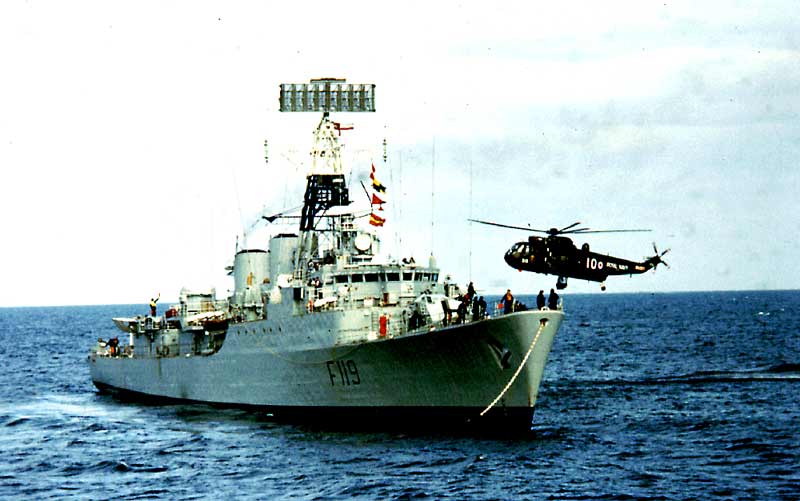
Tribal class Frigate, HMS Eskimo (1975)
However past the 1960s, the fleet inherited from the last war was largely gone, and the Navy new needs revolved around reduced task-forces and Atlantic patrols, notably with a new generation of ASW Frigates capable of dealing with the mass of conventional Soviet submarines that soon invaded the Atlantic, not to mention the considerable budget strain represented by building and maintaining a fleet of nuclear-powered strategic submarines and attack submarines, naval component of national deterrence. Apart the Franco-British expedition in Suez in 1954, and naval support in Korea, no major action was undergone by the Royal Navy until 1982, the Falklands War.
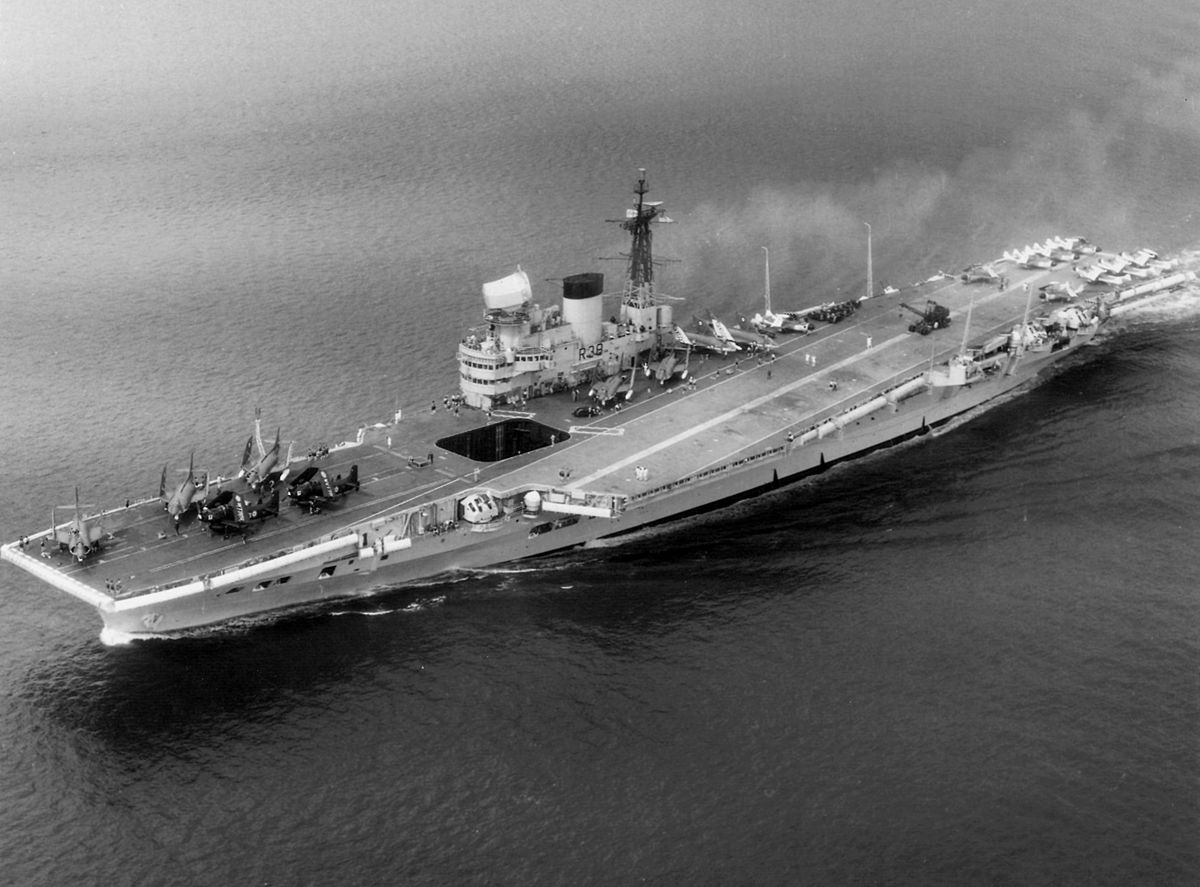
HMS Victorious after refit in the 1960s.
Since 1990 the old lady in service of the Queen and Country saw the end of the Cold War, new budgetary retraints but also a brand new generation of ships emerging (Astute class SNA, Albion class LSH, Type 45/Daring class DDs, River-class patrol sloops), including the remarkable HMS Queen Elisabeth, first true aircraft carrier since the 1950s and largest British ship ever put to sea, soon to be followed by HMS Prince of Wales. A more homogeneous and versatile fleet ready to tackle an uncertain world for the next thirty years and more.
The Royal Navy after the War
For the past forty-three years of Cold War, Great Britain has not been at war with its neighbors, but the years 1947-95 were traumatic for the Navy as having more change as any in its previous history. The budgetary situation after the end of the Second World War badly hit by an economy in sorry state and recession, but the colossal subsidies of the Lease-Lend has been suddenly withdrawn, making an urgent need to release personal from the armed forces, and meaning that large numbers of ships would be disarmed in a short notice.
The huge scale pruning of the Reserve Fleet removed all but be surviving battleships, all cruisers earlier than ww2 and all prewar destroyers. Almost every one of these were scrapped, but a handful found their way into other navies. Merchant ships were to be manned, but there was no priority for these as battleship design continued until as late as the 1950s, largely because of rumors about Russian capital ships being completed. There was a tacit admission however that battleships were in any case of limited value. With less validity reasoning was applied to cruiser designs, for at this time military thinking was dominated by fears of a nuclear war and military writers and theorists believed that warships had no role since a future war would be decided by long-range vectors with nuclear weapons.
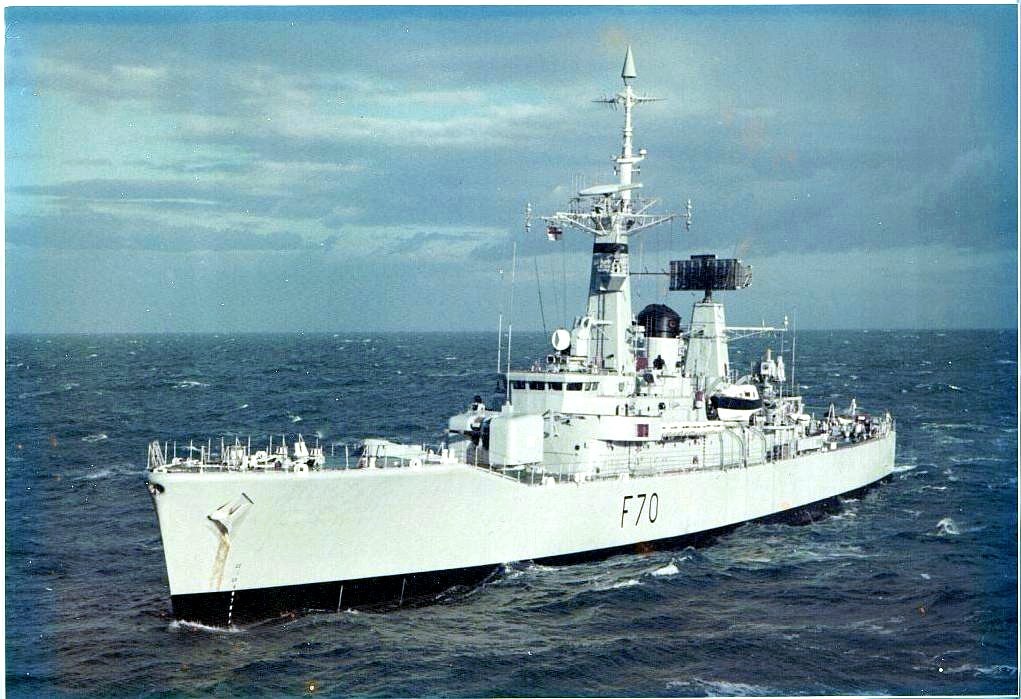
Leander class Frigate, HMS Apollo (1976)
It was recognised by more perceptive planners that the aircraft had still a major role to play, and so permission was given to work on two large and four intermediate hulls from the programme. The very big Malta class had been cancelled1 before any work had been done on them, but the hulls chosen, of the Africa class, were a better-balanced design, probably better balanced and were, therefore, more cost-effective, with a fully enclosed hangar space, a necessity for nuclear war.
The modernization of the six wartime armoured carriers was looked into, but it was found that the restricted hangar height ruled out the newest jets, and condemned the two Implacables and Indomitable. Of the other three, Illustrious and Formidable had suffered heavy war damage, leaving only HMS Victorious. It is interesting to note that before the survey, made in 1949, which settled her fate, modernization plans had been drawn up for HMS Formidable: she would have had a fully angled flight deck, some two years before the RAE Bedford Conference at which the angled deck is claimed to have been invented. In fact, it was the intention to modernize all six carriers; Victorious was uniquely the prototype.
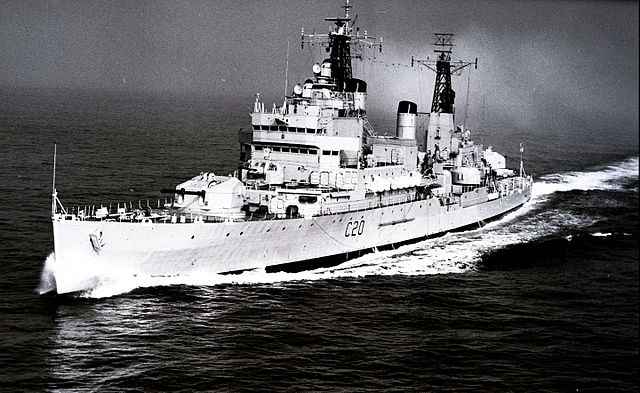
One of the last British Cruisers, HMS Tiger
Articles
British Cold War Carriers:
Majestic class | Centaur class | HMS Victorious | HMS Eagle | HMS Ark Royal | HMS Hermes | CVA-01 project | Invincible class | HMS Argus | Queen Elisabeth class (planned)- Centaur class Aircraft Carriers (1947)
- County class missile destroyers (1960)
- HMS Bristol (1969)
- HMS Eagle (1946)
- HMS Hermes (1953)
- HMS Vanguard (1944)
- HMS Victorious (cold war)
- Majestic class aircraft carriers
- Sheffield (Type 42) class missile destroyers (1971)
- Tiger class (1945)
- Daring class (1949)
- 1953 design (project)
- Cavendish class (1944)
- Weapon class (1945)
- Battle class (1945)
- FADEP program (1946)
- County class GMD (1959)
- Bristol class GMD (1969)
- Sheffield class GMD (1971)
- Manchester class GMD (1980)
- Type 43 GMD (1974)
- Rapid class (1942)
- Tenacious class (1941)
- Whitby class (1954)
- Blackwood class (1953)
- Leopard class (1954)
- Salisbury class (1953)
- Tribal class (1959)
- Rothesay class (1957)
- Leander class (1961)
- BB Leander class (1967)
- HMS Mermaid (1966)
- Amazon class (1971)
- Broadsword class (1976)
- Boxer class (1981)
- Cornwall class (1985)
- Duke class (1987)
- T (conv.) class (1944)
- T (Stream) class (1945)
- A (Mod.) class (1944)
- Explorer class (1954)
- Strickleback class (1954)
- Porpoise class (1956)
- Oberon class (1959)
- HMS Dreanought SSN (1960)
- Valiant class SSN (1963)
- Resolution class SSBN (1966)
- Swiftsure class SSN (1971)
- Trafalgar class SSN (1981)
- Upholder class (1986)
- Vanguard class SSBN (started)
- Fearless class (1963)
- HMS Ocean (started)
- Sir Lancelot LLS (1963)
- Sir Galahad (1986)
- Ardennes/Avon class (1976)
- Brit. LCVPs (1963)
- Brit. LCM(9) (1980)
- Ton class (1952)
- Ham class (1947)
- Ley class (1952)
- HMS Abdiel (1967)
- HMS Wilton (1972)
- Hunt class (1978)
- Venturer class (1979)
- River class (1983)
- Sandown class (1988)
- HMS Argus ATS (1988)
- Ford class SDF (1951)
- Cormorant class (1985)
- Kingfisger class (1974)
- HMS Jura OPV (1975)
- Island class OPVs (1976)
- HMS Speedy PHDF (1979)
- Castle class OPVs (1980)
- Peacock class OPVs (1982)
- MBT 538 class (1948)
- Gay class FACs (1952)
- Dark class FACs (1954)
- Bold class FACs (1955)
- Brave class FACs (1957)
- Tenacity class PCs (1967)
- Brave class FPCs (1969)
British Cold War Cruisers
Destroyers
British cold-war Frigates
British cold war Submarines
Assault ships
Minesweepers/layers
Misc. ships
Sections
Aircraft Carriers
Cruisers
Destroyers
Frigates
Submarines
REFITS AND MODERNISATIONS
The Admiralty was well aware that fire control and radars of the current ships were obsolescent, and this, coupled with their strenuous war service, poor anti-corrosion protection and general lack of amenities, made major overhauls imperative. There was also the question of replacing out-of-date weaponry, and to correct the situation a series of major refits was put in hand in the early 1950s. Battleships were considered for conversion to missile ships, but, as in the United States, the cost was seen to be prohibitive and out of all proportion to any improvement in fighting value, so work on the battleships was confined to routine maintenance. Finally, the modernisation programme was cut back to one carrier and as many cruisers and destroyers as possible.

HMS Blake after conversion, Key West 1978
The Southampton and “Colony” classes and HMS Belfast were all given partial modernizations between 1950 and 1960, but mounting costs and aging of the ships caused the programme to be cut back at Swiftsure. It has been suggested that the HMS Swiftsure turned out to have been inadequately surveyed after sustaining severe damage in collision with the destroyer Diamond during the big NATO exercise “Mainbrace” in 1953, and that by the time the extent of the damage became evident in 1960 the ship’s modernization had been almost completed; nothing could be done to remedy the situation and she was towed away to the scrapyard.

HMS Charity off Korea, 1952
Apart from the “Battle” class and later destroyers, virtually all the wartime “Emergency” destroyers were unsuitable for modem warfare because of inadequate air defence and fire control. Current needs for fleet escorts were met by the big destroyers, but there were no fast escorts to cope with the new Soviet “Whiskey” class submarines. The “Emergency” destroyers were ideal for conversion and so the Type 15 frigate design by N G Holt, was drawn up as a stopgap until the new frigate designs were ready. Despite the end of the Korean War, East-West tension remained high throughout the 1950s, and to make up numbers other simpler and cheaper conversions were also put in hand.
It is not often realized that corrosion was a major problem with war-built ships. Before the war, mill scale was removed by pickling in dilute acid; thin plating, particularly in destroyers, was galvanized. To save time, war-built ships did not receive either treatment and by the end of the war were usually in a worse condition than older vessels.
Detailed Review: Modernized ships of the Royal Navy
Battleships
Although the breed was no longer in favour, Aircraft Carriers being the new capital ships in favor, these were still many battleships in service in 1947:
-HMS Nelson: The valiant 1925 battleship was no longer in service in 1945 already, but she she was officially broken up in 1948.
-King Georges V class: Much more modern, these four battleships were still an asset but were not kept in service, being mothballed instead for some more years, stripped of their AA artillery, useful elsewhere. These were quad- and eight barrelled 40mm Bofors “pom-Pom” units. King Georges V was paid off in 1946 but served as a private ships and went into reserve. The HMS Anson served as training ship in Portland before being decommissioned in 1949 and paid off. HMS Howe was an harbour training ship at Portsmouth 1950-51, then flagship pf training RA until 1947, then paid off and BU in 1949. Duke of York was the flagship of the Home fleet, then reserved fleet until 1951. Until their demolition there were talks of conversion to missile ships, considered but dropped.
-Monitors: HMS Roberts and Abercrombie (1941-42) were the last British monitors, served as training and reserved ships after 1947, and went into list removal in 1953-55 until broken up in 1954 (Abercrombie) and 1965 (Roberts).
HMS Vanguard
The Last british Battleship. The end of a breed that emerged with HMS warrior in 1860. The Vanguard was originally planned in 1939 to complete the battleship serie by using the spare 381 mm (15-in) gun armed turrets of the former battlecruisers HMS Courageous and Glorious. This was to be a 30 knots battleships for the Far East, to deal with Japanese Ships. She was laid down however at John Brown not until November 1941, launched in November 1944, and with prospects of victory on Japan, construction slowed down and more priorities emerged. Ultimately the Vanguard was completed after many modifications on August 1946.
She would never fire a shot in the war she was built for. The turrets imposed many compromises and the vanguard was not an overall successful design. She nevertheless was kept as prestige ship for the fifties, received some AA armament modifications in service (refit at Devonport 1947-48) and went in the Mediterranean, then training ship at Portland, refitted at Devonport in 1954, then paid off in reserve, flagship of the reserve fleet and NATO HQ ship until sold for scrap in 1960.
Aircraft Carriers
Illustrious class
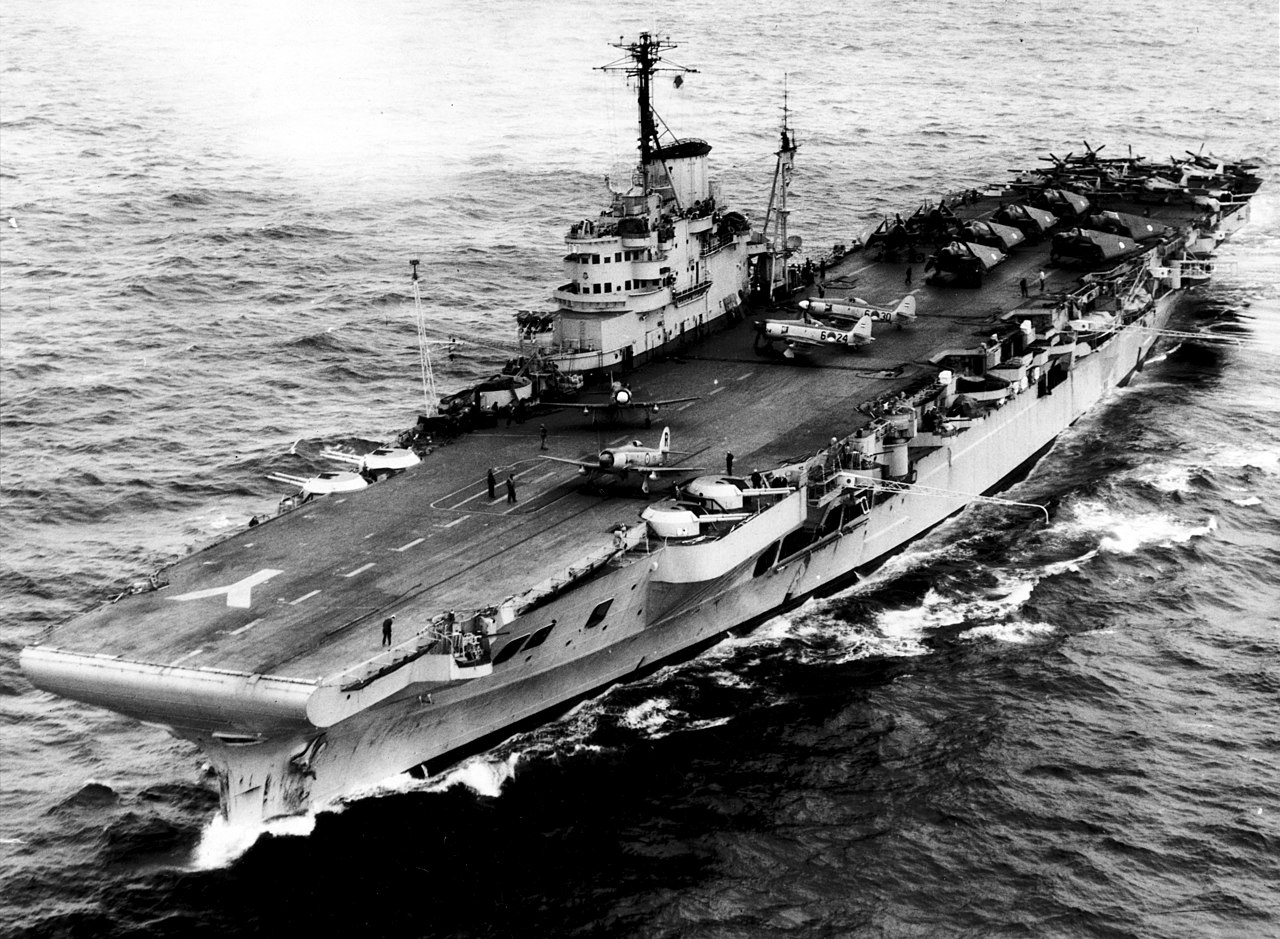
HMS Illustrious after reconstruction to operate jets, circa 1954
HMS Illustrious, Victorious, Formidable and Indomitable (renamed R87, 38, 67 and 92) were pretty much spent after their very active life in WW2. Apart HMS Victorious, which was rebuilt, they served as reserve ships until 1949, and were broken up in 1953-56. HMS Illustrious however was taken in hands for refit, from which she emerged in mid-1946, with a more powerful catapult, 30% more aviation fuel, remodelled ends for the flight deck, and she served eight years as a trial and training carrier. She operated the first British sea jets, and had a new all-40 mm Bofors AA artillery. Similar modernization prospects for the HMS Formidable were soon dropped. For the second refit of HMS Victorious see later. She was broken up in 1969.
Indomitable was back in the UK by November 1945, repatriating personal. She would do two more trooping runs until 1946 and in 1947-50 was refitted as HMS Ilustrious, joining the Home Fleet for a three-eyears commission, armed finally with 24 single Bofors, five octuple Bofors and her aircraft complement included the last and best piston-planes of their generation, the Firefly, Sea Fury, Sea Hornet, Firebrand, and early ASR helicopters. HMS Indomitable was in reserved by 1953 and was scrapped in 1955.
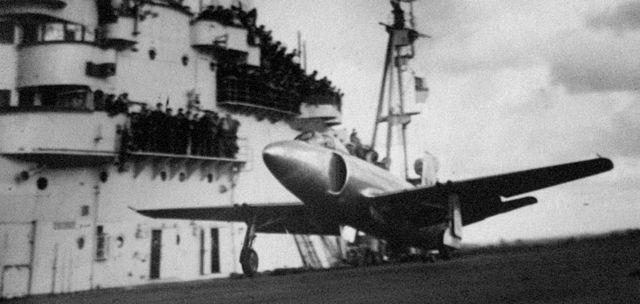
A supermarine Seafire landing on Illustrious in 1947
Implacable class
Both carriers arrived late into WW2 and knew little service in fact postwar. HMS Implacable returned in 1946 from the BPF and served for tes-landings of new planes in the Home fleet. In late 1947 up to 1949 her air graoup as allocated was changed miltiple times and was difficult to setup. She ended with 13 Sea Hornet and 12 Firebrands, a meagre 25 planes, and later 4 sea Vampires, the first jets, were added. 12 Barracudas arrived next summer for ASW operations.
She operated as such until 1950 but was soon placed into reserved then served as training carrier until 1954, and was discarded, sold and scrapped the next year. From late 1944 to 1955 this represented barely ten years of service, quite a short time for a large, costly fleet carrier.
The HMS Indefatigable did not fare batter. She also served with the BPF in the far east and made several repatriation runs. From 1950 she served as a training carrier. Her hangars were trasnformed into classrooms and messdecks, and she was eventually placed into reserve in 1954, sold and scrapped in 1956. The dilemna was both ships were not large or sturdy enough for jets and reconstruction cost would have been too steep.
HMS Unicorn
The ww2 escort carrier was placed in reserve right away upon return from the far east. However when the Korean war broke out, her commission as prolongated until 1953, she served with ther WW2 air complement and without much change in AA nor electronics. She however was probably one of the very few carriers in the RN to bombard land targets in Korea with her main dual purpose 5-in artillery. Her commission expired in 1953, and she became a ferry carrier upon her return. she was mothballed and sold for scrapped in 1959.
Colossus class light fleet aircraft carriers
Foreign sells:
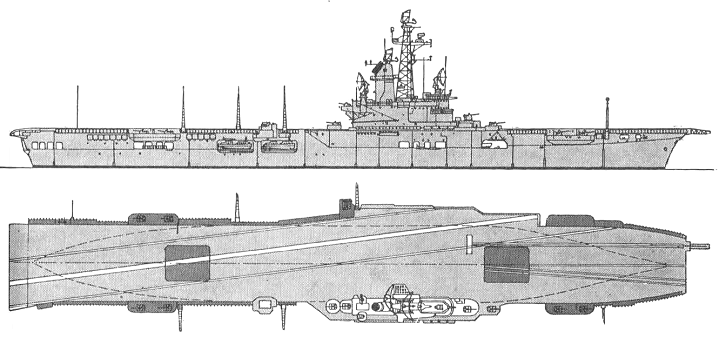
General appearance of HNLMS Karel Doorman after reconstruction in the early 1960s (Conways).
-HMS Colossus was transferred to France and became Arromanches, soldiering in Indochina and Suez, she was discarded and later scrapped in 1878.
-HMS Venerable was sold to the Dutch, and became Karel Doorman. She replaced the smaller Nairana and served for the best part of the sixties and she was resold to Argentina in 1969. Under the new name of Veinticinco de Mayo she took part in the Falklands war in 1982.
-HMS Warrior became Canadian for just two years in leasing 1946-48, returned in UK, was modernized, and resold in 1959 to Argentina as Independencia.
-HMS Vengeance was lent to the RAN as HMAS Melbourne, returned and in 1956 became the Brazilian first carrier, Minas Gerais.
British Carriers in operations
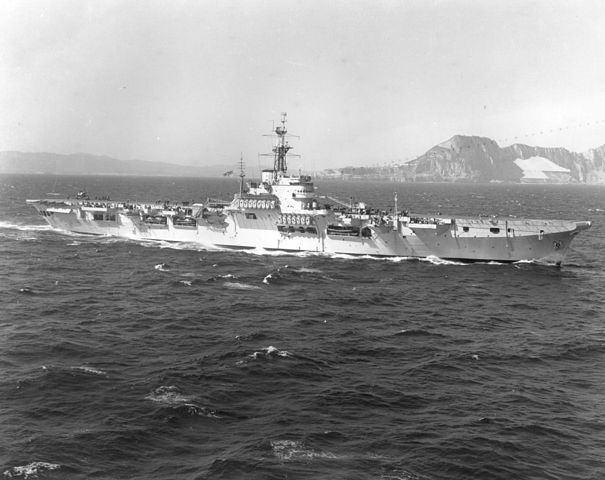
HMS Warrior off Gibraltar in the late 1950s, as modernized.
Without much modifications, HMS Glory, Ocean, Theseus and Triumph served wth distinction over Korea. At their return however the jet age condemned them and after been used as training ships or for menial tasks, Ocean, Glory and Theseus were scrapped in 1961-62.
–HMS Warrior was converted to test a steel ramp for jets back in the UK in 1949, testing also a flexible landing deck to cushion jets. This odd solution was made of rubber band over air bags, estended to the rear over 150 feets. In 1952-53 she was comprehensively modernized, of course the “magic carpet” flight deck was dismounted and she went out for dockyard with a lattice foremast and enlarge bridge (which served as prototype for the Karel Doorman’s own reconstruction). In 1955 her deck received a partial angled deck and stronger arrester to operate 15000 Ib planes landing at 60 knots. A catapult was fitted forward, powerful enough to launch a 14,000 ib jet. She acted as HQ ship for nuclear tests in the pacific, Christmas Island and upon her return in 1957 was proposed to Argentina and sold in 1958, and she had a reduced AA.
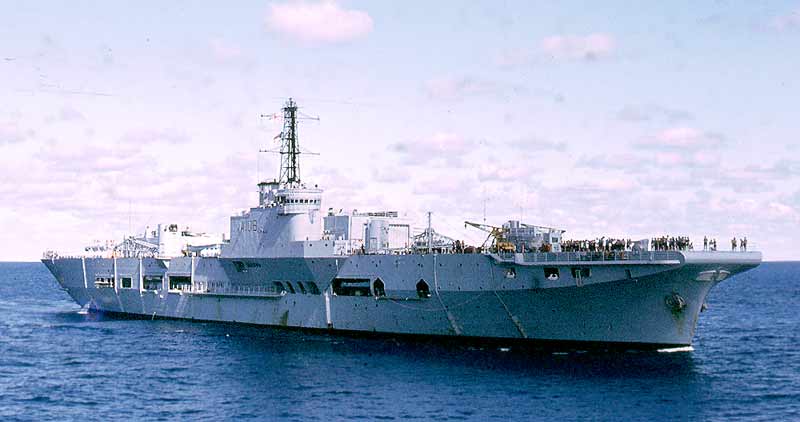
HMS Triumph in January 1972
-HMS Triumph returned home a veteran of WW2 and Korea, and served home as a training ships for officer cadets. The 1956-57 estimates order her to be converted as a repair ship. He hangars were filled with workshops, to assist various ships abroad far from any dockyard. While the idea was sound, the program was under-budgeted and suffered major delays, lasting over seven years. In the end she served only a few years as a repair ship and was place in reserved in 1981, sold and broken up in 1982.
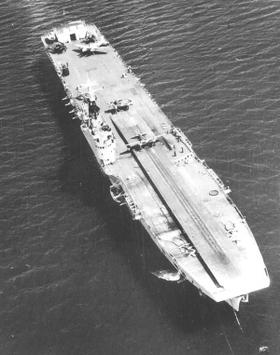
Perseus class light fleet aircraft carriers
These light fleet carriers of the Colossus class were completed as fleet repair ships for the Pacific. Unlike the Unicorn they could not operate aircraft because of the new heavy lifts, deckhouses on the main flying deck and heavy cranes but had had large and well-equipped facilities and workshops. In 1946 their AA was scrapped and replaced by sixteen 40 mm Bofors and displacement rose to 26,265 tond, 694 feets in lenght. In 1950 HMS persus was taken in hands for modifications: a steel structure was installed at the front, to test flights and a new catapult. The power was steam provided by the boilers of the ship, even if it was immobile. Both Perseus and Pioneers became ferry carriers in 1953, but the latter was sold for scrap in 1954 while Persus remained in service until 1958.
Majestic class light fleet aircraft carriers
With the end of Hostilities, work stopped on the six carriers laid down and there were considerations to scrap them and free the slipways. However soon both Australia and Canada expressed their interest to acquire two of these, and work restarted on the HMS Magnificent and Terrible. In 1948 they were sent in their original design to their owners. The Australians acquired the Majestic, and heavily modified it previously, so they were about to do the same with HMS Terrible. In 1952, the RCAN acquired the HMS Powerful, which was also completely reconstructed and served for motst of the cold war. India acquired HMS Hercules, which became the Vikrant, also totally modernized. HMS leviathan was kept for spare parts, without commission.
HMS Campania escort carrier
This was the sold survivor of a class of three identical refigerated ships converted into half-carriers (with reduced aircraft capacity and their storage capacity intact). She was the first CVE fitted with the new AIO combat system and Type 277 radar. She was recommissioned after reserve as a ferry carrier, capable of carrying 90 planes, armed with 2×2 Bofors and 2 single. However she was lent for the 1951 festival of Britain, and refitted later by Camell laird as an exhibition ship, touring Europe. Back in the admiralty she was refitted and carried scientists for the first British nuclear test at the Monte bello Islands in 1952. The next year she was laid up and finally scrapped in 1955.
Cruisers
Contrary to the USN which converted several conventional cruisers as missile ones, the British Royal Navy preferred to convert only the Tiger class. HMS belfast in London, on the Thames is now the last of these conventional cruisers. However most of the conventional fleet of cruisers, no less than thirty ships, served in the 1950-60s. The Belfast was the only one to escape scrapping, preserved in 1971.
‘County’ class heavy cruisers
These interwar cruisers were fast ageing in 1946. The first to go, without much modifications, were the HMS London and Norfolk in 1950. They were followed by the Devonshire in 1954 and Cumberland in 1959.
-HMS Cumberland became a trial ship in 1949-51 fitted with lattice masts, new directors and radars, plus accomodations. The armament was removed, escept for two single 4.5 in Mk.5 mounts. STAAG 40 mm Bofors were fitted with the new Battle class mk 37 director. In 1953 she carried a single foward turret aft, 3in/70 Mark 6 turret with MRS3 director, and a 6-in automatic turret forward Mk26. The trials campaigns lasted until 1958, allowing to perfect the pre-welling NR propellers and new stabilizer in addition to artillery.
-HMS London was still in the far east in 1949, carrying troops back home. She was damaged by Chinese shore battery when trying to save the crew of HMS Amethyst, a stranded sloop in Chinese waters. Apart the removal of 20 mm guns, there were no changes and the ship started a career of cadet training ship with only the “A” turret kept, and twin 4-in mounts AA plus a quadruple pompom, single bofors, and three saluting guns. Her powerplant was reduced to four boilers, 21 knots. She was paid off at the end of 1953.
Leander & Arethusa class light cruisers
Leander was purchased by the RIN (Indian navy) and became the Delhi. India rejeted an offer to acquire also the Ajax and Leander. China however expressed interest and acquired the Galatea, renamed Chungking. The cruiser changed hands two times and served until the 1980s as an accomodation hulk.
‘Town’ class cruisers
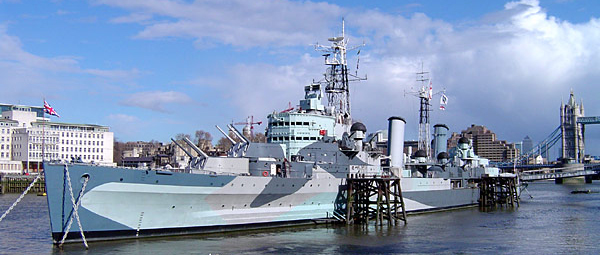
HMS belfast, as for today. Her bridge has been completely rebuilt along the lines of the Tiger class, so the camouflage is a fancy recreation in this condition. The Belfast today in London is a mere “evocation” of a WW2 British Town class cruiser.
In 1950-52 HMS Birmingham and Southampton were modernized: New bridgework, new lattice masts, Mk6 directors and radars, and air conditioning to serve in the Far east. Both were discarded 1959 and 1960. Sheffield was also modernized the same way in 1956 and was discarded in 1967. HMS Glasgow was not altered and retired in 1958, as HMS Liverpool. Belfast served in the korean war and received a partial modernization in 1956. She received the new Tiger-type bridge, MRS8 directors and modified AA, with 6×2 40 mm Bofors, and two lattice masts. She was decommissioned at Portsmouth and acquired by a charitable organization for conversion as a museum.
Dido class AA cruisers
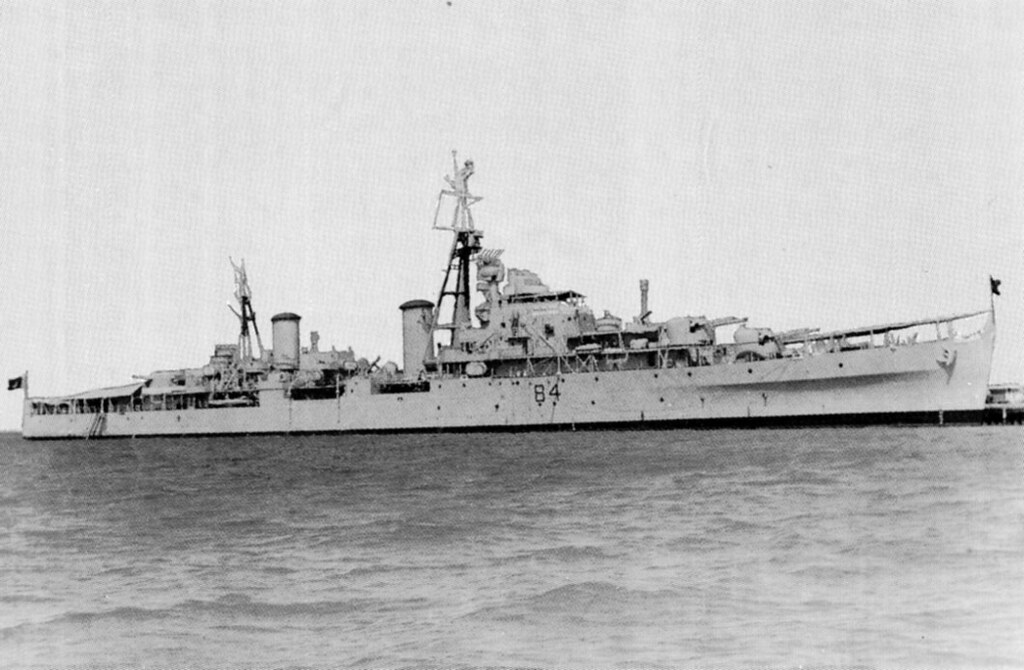
Pakistani PNS babur (ex-HMS Diadem).
All six ships were decommissioned in 1955-59. They were too cramped and light to take on new equipments and escaped modernization. Phoebe and Cleopatra received new US pattern 40 mm guns. Phebe was the first scrapped, in poor conditions after the collision in the Mediterranean. For the very close Bellona class, HMS Royalist was modernized in 1954 and transferred to new Zealand. HMS Diadem was modernized with lattice masts and new directors in 1956 and was later transferred to Pakistan as Babur.
“Crown Colony” class light cruisers
Ceylon and Newfoundand were sold to Peru in 1959, Nigeria to India (INS Mysore) in 1957. They were criticized as cramped and had thin side armour. None was really modernized as there was no room for it. Only addition were ne covered bridges and CRBN directors, new Bofors AA. Main turrets were often removed. However Mysore, Ceylo and Newfoundland were modernized the same way as the southamptons. In peruvian service they were called Almirante Grau and Coronel Bolognesi.
Swifsture class light cruisers
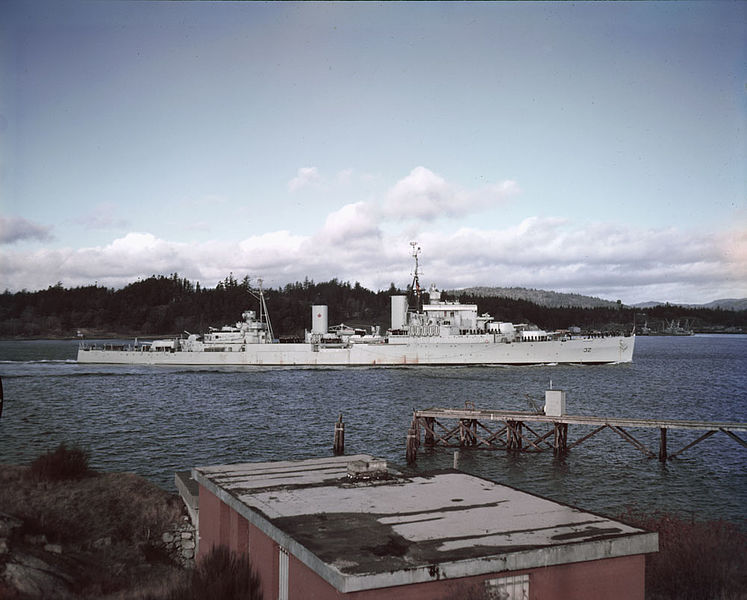
HCMS Ontario in 1958
Both HMS Swiftsure and Superb were considered for extensive modernization, notably with the fitting of new automated turrets, on the line of the new Blake-class. Hwowever if work started at Chatham in 1956 and 1957, it was never completed, stopped by decision of the admiralty in 1959 as costly for obsolete and cramped ships. Both were scrapped, in 1962 and 1960 respectively. HMS HMS Minotaur was transferred to Canada before being completed, as HCMS Ontario, entering service in May 1945. She was scrapped in 1960.
Abdiel class minelayers
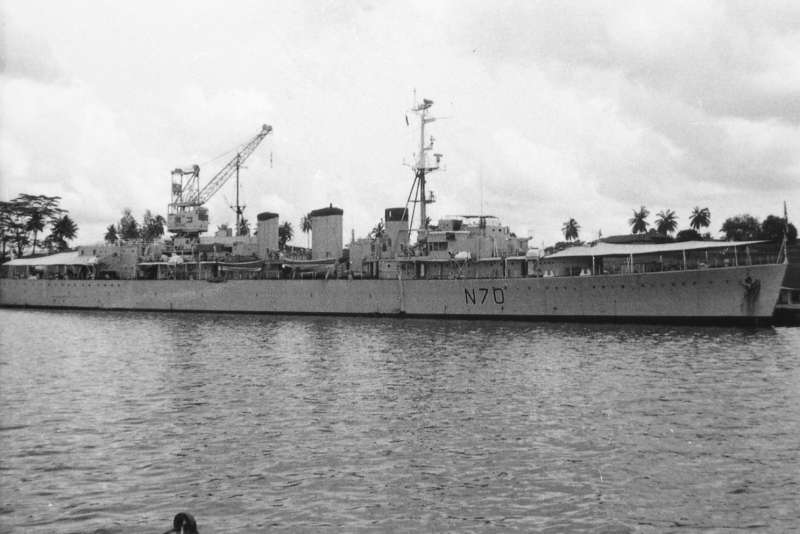
HMS Manxman at Sembawang, Singapore, March 1964, photo by K. Watson. Src shipspotting.com
The Manxman of the Abdiel class and Apollo and Ariadne of the latter class were used as flagships after the war due to their generous accomodations. HMS Manxman was comprehensively modernized in 1955: Aft twin 4-in removed and deckhouse built instead, and in 1962-63 at Chatham she was converted as a depot ship for coastal minesweepers, with storehouses and offices for repairing and maintaining 16 ships. The forward boiler room was emptied and replaced by additional storage space. She had 6 Bofors for close defence. She served until 1971. Apollo had new structures built, in 1954 her deckhouse was raised by one deck, and she retained her after 4-in twin mount. She was BU in 1962 whereas Ariadne was laid up in 1946 and left out of commission, for spare parts, only to be broken up in 1964.
Destroyers
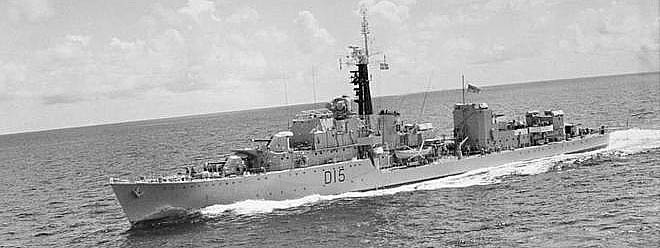
HMS Cavendish during Exercise Fotex, 1964 (IWM)
So far, UK was still counting about a recent hundred destroyers in 1946. After mass-decommissions and srappings, the oldest ships kept were the N Napier class destroyers of 1940. They were broken up in 1955-58. Of the next M Milne class, four out of five were sold to Turkey in 1959.
Napier was used for minesweeping testings after 1949. All except nepal had new lattice masts, and modernization ior conversion into Type 15/16 ASW Frigates was rejected due to their relative age but mostly worn-out conditions after wartime intensive service. HMS Musketeer became an accomodation ship for coastal forces in Harwich, and the ships destined to Turkey were modernized. The admiraly at some point envisioned their conversion as Type 62 air direction frigates.
For the Obdurate (O) class, three were discarded in 1955-64, three sold to Pakistan and three became Type 16 frigates (see later). Of the Q and R classes, three ships were sold to India in 1949, of the next S, T, V, W and U classes of 1942-43, only two were discarded whereas 18 were converted to type 15 and 7 to Type 16 Frigates, the remainder being sold to Yugoslavia (2 in 1956), and South Africa in 1950-53.
The Myngs an Cavendish class (1943-44) were modernized (see later) and the remainder sold to Israel (2), and Egypt (2). The new ‘C’ classes, Childers, Cossack, Cormwell of 1944-45 were sold to Pakistan (4 ships) and the remainder were discarded and BU in the 1960s.
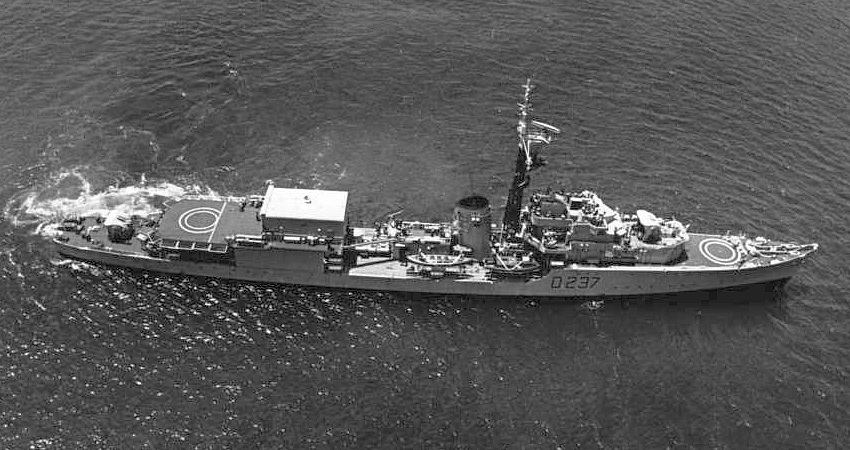
South African SAS Simon Van der Stel, type 15 Frigates in the 1970s.
Saumarez and Volage were badly damaged by mines in the Corfu strait by Albanians in October 1946. There was an odd proposal to weld both (ine lost the stern, the other the bow), like the WW1 “Zubian”, called “sausage”, but it never passed the crew’s joke stage. Savage ad Teazer were used for propellers tests. Cavendish was modernized (see later). The Israeli ships were named Yaffo and Eilat, and the Egyptian El Fateh and El Qaher. HMS Creole and Crispin were given an prominent W/T cabin instead of B gun position, and the others received two Squid mortars and aft handling room. Armament was composed of modern mk5-7 40 mm Bofors mounts.
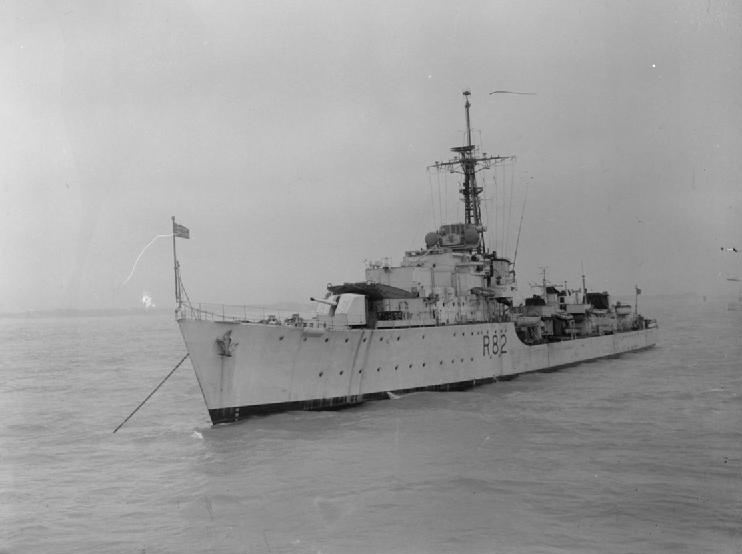
HMS Creole as modified with the W/T cabin instead of B gun, 1947.
Battle & Weapons class (1944-45)
The most modern WW2 British destroyers up to this point were still acceptable for service as is until the late 1950s. They were discarded in the 1960s and up to 1970-79 for those modernized. Two were sold to Pakistan, one to Iran, and the remainder converted as radar pickets, 8 ships, most of the completed “Weapons” class. The Battles were completed late into the war, and after it, and the 1st group earned a 4in startshell gun in Q position, and STAAG Mk2 40 mm mounts. HMS Saintes tested a Mk6 twin 4.5 in gun, for the future Daring class.
The quarterdeck 40 mm was replaced by a squid mortar on all ships. HMS Finisterre was used as a gunnery training ship, with accomodations and deckhouse instead of the TTs. She was renamed later HMS Vigo. Cadiz and Gabbard were sold to Pakistan in 1956 as Khaibar and Badr, in 1966 Sluys was sold to Iran, as Artemiz. She was its admiral ship, until the revolution. HMS Hogue was badly damaged in a collision with an Indian cruiser and laid up in Singampore, disarmed in 1961. The other ships of the 1st groups were discarded and BU in 1961-70. The second group destroyers were also discarded without modernization in the 1960s but the Barrosa, Agincourt, Coruna and Aisne were converted as radar pickets. For the Weapons group, all four were converted.
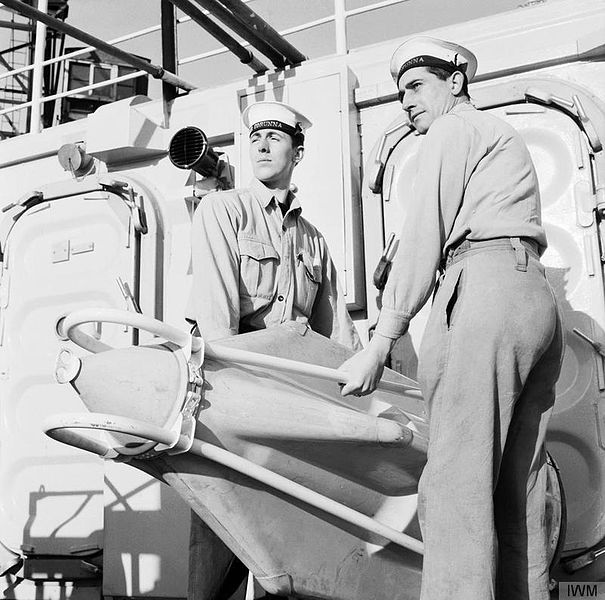
Seacat missile on HMS Corunna in 1961
As a side note, a few German Destroyers were evaluated and cannibalized: Two Leberecht Maass class ships, and Z23 and Z30. R38 became the H40 and H97 was evaluated without new denomination. All four were discarded in 1947-49 due to poor conditions.
Modernized WW2 submarines
Since the mass of ww2 submersibles were obsolete after the Type XXI and other German advanced propulsion prototypes were uncovered, some 68 of the T, S and U, and Acheron class stayed in service for years, until the 1960s and other were streamlined and stayed active until the 1970s. Netherlands (2), France (4), portugal (2) and Israel (2) actually received these and others were converted. Too small to be kept in the cold war fleet, S-Types that were not sold to France, Israel and Portugal were discarded in the 1960s. HMS Sidon was lost, sinking in 1959 because officially of an oxygen bottle and torpedo explosion. HMS Truculent was lost during a collision with a freighter in the Thames in 1950. Of the U class, the two survivors, HMS Untiring and Upstart were sank as targets.
Not well known, the X-craft of 1944 fame, when they tried to sink the Tirpitz were still in service in 1952. New names: Netherland’s Seehund, Dolphin (1948), reverted in 1953 to the UK. French Sirène, Sybille, Sultane, Saphir, Portuguese Nautilo, Neptune, Israeli Rahav, Tanin. Two U class became the Greek Amfitri and Xifias, returned to the RN in 1952 and sunk as targets later.
Streamlined and converted T class subs

HMS Trump streamlined, P333
The overall shapes were better blended, hydrodynamics were pushed forward and new poerful batteries gave them an underwater boost. This modifications concerned the HMS Tapir, Token, Tireless, Talent and Teredo. Others were converted like the HMS Tiptoe, Trump, Taciturn, Tabard, Totem, Truncheon, Turpin, and Thermopylae. The range of modifications concerned mostly riveted hull models, with new batteries, streamlined conning tower into a “fin”, and reshaped bow casing. All boats, even the non modernized ones received a snorkel of the port side “snort” type, hinged at deck level. Deck Guns were generally removed, but the Portuguese ones. The welded hull ones were taken in hands for a full modernization from 1951.
“T-Streamline” serie
Five T class boats were taken in hands fo a partial modernization. They were old riveted hull types, therefore not given the same service span and same modenrization level. Nevertheless, they had the typical casing and fin, guns out, but same propulsion as before, two ASR diesels and two electric motors for 2500/1450 hp, same speed of 15,25 knots surfaced, but 1.4 knots more underwater as shown by the prototypes. Still quite low for cold war 1960s boats. They were however quieter enough to be used for ASW training. HMS Tireless was the prototype. Performances were also helped by new batteries delivering 6560 amp/hr instead of the old 5330 figure. No info is available on sensors upgrade, however the torpedoes carried were the new Mk20-23 models.
“T-Conversion” serie
These 1944-45 welded hull boats (eight total) of the Taciturn and Tabard groups were converted in 1951-56. Modifications were quite extensive and comprised the following operations:
-The pressure hull was cut in two
-A New 20 feets section (in some cases 12-15 feets) was added at the rear for extra machinery room.
-Two new electric motors were added with clutches to link them with diesels
-Fourth battery section added with 6500 cells.
-Guns and external TT removed
-Snorkel radar added, new R/T masts
-New streamlined fin fitted in place of the old kiosk
-Bow and stern reshaped and streamlined
-TT reduced to four bow, two stern with Mk23 ‘Grog’ and Mk8 torpedoes.
On Tabard and Trump, the fin was totally enclosed, whereas there was a small low-set bridge
As a result of the engine modifications, underwater speed more than doubled, at 15 knots.
Read more: http://rnsubs.co.uk/articles/development/streamlining.html
Acheron class modernized
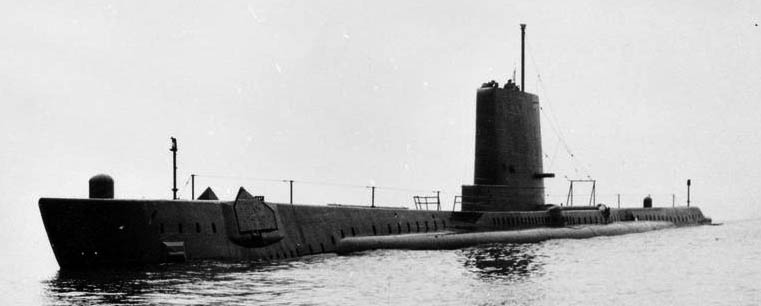
HMS Artful – Imperial War Museum
This also concerned the Acheron class, which were thoroughly modernized and deserved their own part. Their 20 mm guns were removed, low bow casings fitted with buoyancy tanks and external tubes blanked. Conversion started in 1955. Only one escaped it, HMS Aurochs, discarded in 1967, remarkably late for a WW2 submarine, “in her juice”.
Modernized Frigates
This concerned modernization of WW2 Hunt class ASW frigates, Grimsby, Bittern and Black Swan classes, Captain, River, loch, Bay and Flower class ships. They were deactivated and BU from 1955 to 1966. Many were sold too. Details below:
Hunt class Frigates
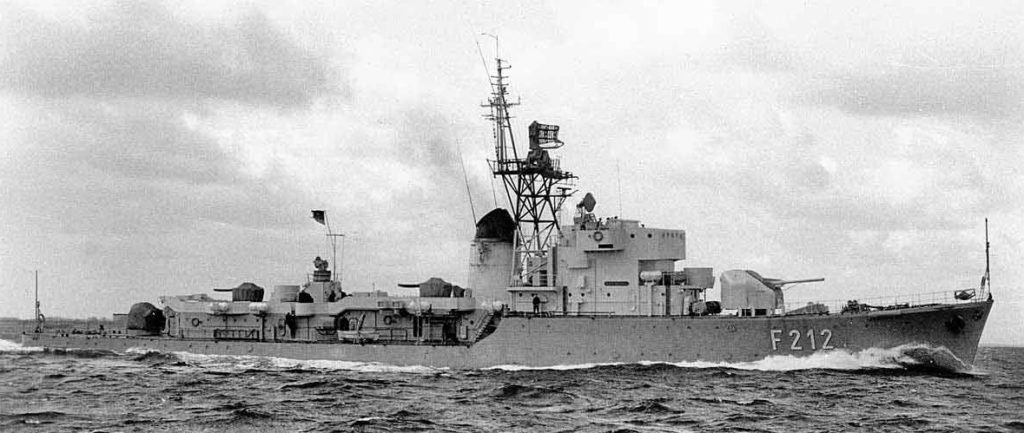
One of the “Hunt” class in service lng after British units: FGS Gneisenau F212, of the Bundesmarine in the 1970s.
From 1947 they were all rerated AA Frigates since their ASW equipment was limited and obsolete. Few saw active service after the war, with partial recommission or training use. HMS brocklesby was converted as a disarmed test ship for a new variable-depht sonar on the quartedeck. HMS Mendip served two years during the civil war as Lin Fu and was returned to UK, then resold to Egypt as Mohamed Ali El Kebir. HMS Cottesmore joined her as Ibrahim El Awal. Denmark purchased the Blacksmore, Calpe and Exmoore in 1952-53 which became Esbern Snare, Rolf Krake and Valdemar Sejr.
India was lent three ships, the Godavari, Ganga and Gomati, Norway had the Badsworth, Beaufort and Zetland sold and renamed Arendal, Haugesund and Tromsö, and Equador received the Quantock and Meynell, renamed Prdt. Alfare and Velasco Ibarra. Finally, the Federal West German Navy obtained three ships, the Raule, Brommy, and Gneisenau.
Gimsby, Bittern, Egret Black Swan class Frigates
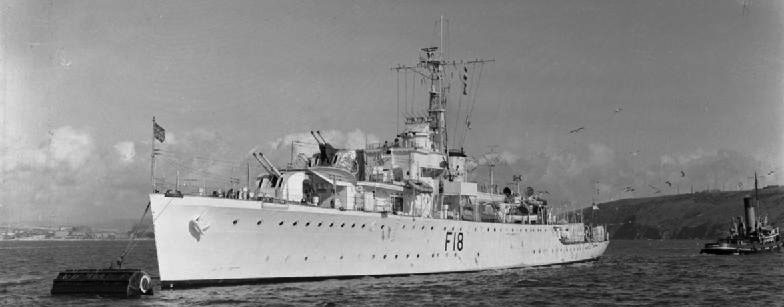
HMS Fleetwood was disarmed and served as a test ship for the admiralty signal and radar unit, with a new lattice masts, extra radars, deckhouses for accomodations forward and aft. HMS Stork and Pelican served for a few years after the war. The Black swan class ships were discarded in the RN in the 1950s except the HMS Erne, RNVR drillship Wessex 1952, HMS Whimbrel sold to Egypt as El Amir Faroukh, and Flamingo to the Bundesmarine as Graf Spee.
The modified Black Swan class served extensively on foreign stations in the 1950-60s. HMS Amethyst was badly damaged by Chinese artillery during the civil war on the Yangtse. These ships were given Mk5 mountings for their Bofors guns. They were fitted with lattice masts, only two ships retaining their tripods. Redpole and Starling became tenders, disarmed for navigational training. Actaeon, Hart and Mermaid were sold: They became the West German Hipper, Scheer and Scharnhorst from 1958.

HMIS Sutlej in 1946, IWM
Captain & River class Frigates
The River class were for the most paid off since there was already a large provision of larger and more modern Loch, Castle and Bay classes already in service. In all surviving ships, 20 mm guns were replaced by 40 mm Bofors on new mounts, and Type 277 height-finder radar. HMS Helmsdale was disarmed and used as a trial ship for th Squid mortar system, with a twin launcher on B position. HMS Meon and Waverney were used to test propellers silencers, and Landing Ship Headquarters for LSH(S) crafts. There was a large aft deckhouse for the Royal Army personal. HMS Exe could have been converted that way (conflicted sources). The last ships of the class were BU in 1966.
The “Captain” class frigates were lend-lease US-built DE type escort destroyers and should be in theory returned to the USN according to the Lend-Lease agreements. However HMS Hotham (Buckley class) remained in service with the RN but she had been fitted in 1945 to provide power, an emergency station for Singapore, stripped of her armaments. In 1951 she was returned home to be used as a test ship for gas turbines. On paper she was to receive English Electric’ twin-shaft EL60A turbines for 2x 6000 hp total. They were never fitted as more modern model were already avilable. Technically she was returned to the USA but broken up in UK.
Loch & Bay class Frigates
The relatively large Loch class Frigates proved very adaptable and could be updated postwar with a large array of new radars sensors and even armaments. They were part of the solution of the RN facing hordes of Soviet Submarines in the 1950-60s. The nine most modernized ships which served in the Persian gulf were modernized in 1955-57, with twin 4-in Mk19 guns, four single 40 mm Bofors Mk9 on the bridge wings and forecastle break and a twin Mk5 aft. Type 277 Q height-finder radar. They served until the late 1960s, seven ships were sold to New Zealand, one to Iran (Babr), one to Malaysia (Hang Tuah) while Loch Fada was used to test vertical launchers for the Seawolf missile, BU in 1976. Two more were converted as depot ships for minesweepers and small crafts.
The Bay class frigates had a weak ASW armament and were never really modernized. One became the Finnish Matti Kukri, and four, the Portuguese Alvarese Cabral, Don F. De Almeida, Pacheco de pereira, and Vaco da Gama in 1959-61. Two Bay class ended as C&C stations for overseas service. These were HMS Alert and Surprise whic had a full displacement of 2440 tonnes, were armed by two twin 4in/45 Mark 16, two ingle 40 mm Mk7, and four 3-pdr saluting. They also served as Yachts. The Surprise was converted as Royal Yacht with a glass cabin in lieu of the twin 4-in mount and both ships had increased accomodations. They were retired in 1965and Alert in 1981. The remainder were BU in 1958-59.*
Flower & Castle class Frigates
These two ex-corvettes were returned by the Royal New Zealand Navy in 1948, and were retired on the navy list for three years they were thus the only survivant of the large numbers of Corvettes made for the RN from 1940 onwards. The reminder were disposed of in large numbers from 1946 some to be converted to whalecatchers and small coasters, but the majority to be scrapped.
Castle class: Like other escorts these vessels were absorbed into the frigate category in 1947. Menay served with the training squadron at Portaldn, but the hulls for to small for any attempt of modernization and they were scrapped from the mid-1950s. Berkley castle capsized in drydock. At Sheerness during the distrasrous flood in February 1953 and was rever repaired. The weather ships were lent to the Air Ministry with the 40 mm Bofors guns and the Squid DC mortar cocooned, but never retired to naval service.
Miscellaneous Ships
MINESWEEPERS
Halycon class: These were launched in 1936-38, displacing 1330t deep load, Franklin, Scott, Seagull and Sharpshooter reverted to surveying duties postwar. HMS Sharpshooter was renamed Shackleton in 1953. They were scrapped between 1956 and 1965.
Algerine class: They were launched 1941-45, 1225-1325t deep load. Eighty-three of these successful sweepers were retained; many were transferred to other navies, and served as training ships. They were surplus to requirements after it was realised during the Korean War that steel-hulled sweepers could no longer rely on degaussing for protection against magnetic mines.
HMS Cadmus, Fancy, Liberty, Ready, Rosario and Spanker became the Belgian Georges Lecointe, A F Dufour, Adrien de Gerlache, Jan van Haverbeke, De Moor and De Brouwer (1949-53); HMS Hare became the Nigerian Nigeria (1959); HMS Flying Fish and HMS Pickle became the Ceylonese Vijaya and Parakrama (1949-58); HMS Fly became the Iranian Palang (1949); Pelorus and Rosamund became the South African Pietermaritzburg and Bloemfontein (1949); Arcturus, Aries, Gozo, Lightfoot and Postillion became the Royal Hellenic Navy’s Pyrpolitis, Armatolos, Polemistis, Navamachos and Machitis (1947); Mariner became the Burmese Yan Myo (1958); and HMS Minstrel became the Royal Thai Navy’s Phosampton (1947).
COASTAL FORCES
Vosper 73ft type: 47t deep load, MTB 386, 392, 502, 523-527, 529, 530, 532, 533
These were renumbered as fast patrol boats in 1950, MTB 386 and 392, and became the FPB 1001 and 1002, 523-527, 529, 530, 532 and 533 became the FPB 1023-1027, 1029, 1030, 1032 and 1033. FPB 1030 sank after a collision, with her sister FPB 1032 off the Netherlands coast on 28 March 1950, while FPB 1023 caught fire and blew up in Aarhus harbour, Denmark, on 17 May 1953. Only FPB 1002 survived (as a hulk) by 1956. The armament was mixed, some having a 6pdr forward, others twin 20mm. FPB 1032 received an experimental 4.5in/25.
British Power Boat 71sft type:
These were 53t deep load. The serie which survived the war were the MTB 470, 480, 496, 498, 505-509, 519, 521, 522, 596, 598. Nine were renamed in 1947: HMS Proud Fusilier (ex-MTB 505), Proud Grenadier (ex-MTB 506), Proud Guardsman (ex-MTB 507), Proud Highlander (ex-MTB 508), Proud Knight (ex-MTB 509), Proud Lancer (ex-MTB 519), Proud Legionary (ex-MTB 522), Proud Patriot (ex-MTB 596) and Proud Patroller (ex-MTB 598), with 1000 added to their numbers. The others were all stricken by 1947, except MTB 470, 480, 496 and 498, which were renumbered as fast patrol boats FPB 1570, 1580, 1596 and 1598.
Camper & Nicholson type:
These boats displaced 102.5t deep load. Ordered in 1941 and laid down in May 1942, was completed in 1945 for experimental purposes. She displaced 86.5t standard, was 117ft 3in oa x 19ft lin x 4ft 4in max (35.7m x 5.8m x 1.3m) and was fitted with 3-shaft gas turbine/gasoline machinery (one Gatric gas turbine plus two Packard engines, 5200shp = 34kts); she was unarmed and had a complement of thirty-one.
Renumbered P 5559, she ran a series of trials in 1947 before being sold c1948.
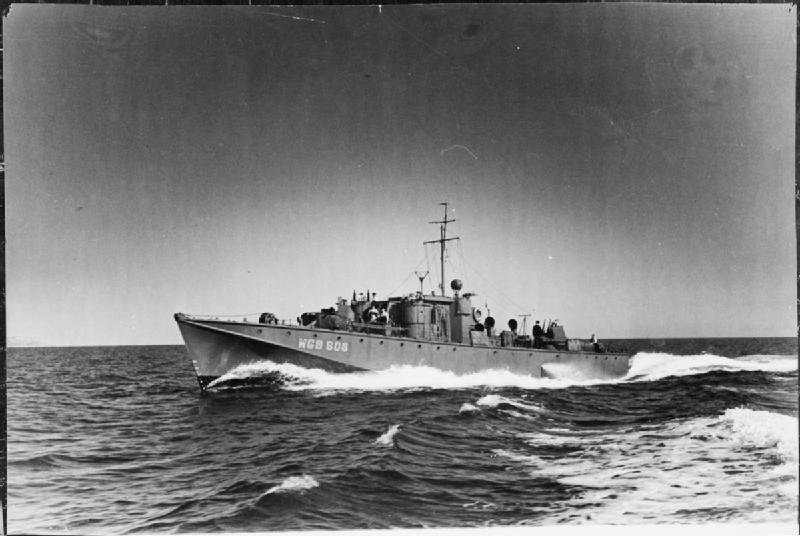
Fairmile ‘D’ type:
These displaced 118t deep load, MTB 731, 750, 758, 759, 780, 790, 793, 794, 795.
All were renumbered, MTB 731, 750, 758, 779, 780, 785, 790 and 793-795, and they became the FPB 3001, 3002, 5001, 5003, 5010, 5013, 5031, 5032, 5033 and 5035-5037; 3001, 3002, 3050 and 3053 served as motor anti-submarine boats, (MA/SBs) the others as convertible MTBS/MGBS with four TT or two guns, 6pdrs in most, but 4.5in/25 in 5036. Only FPB 5001, 5035 and 5036 were still in service by 1958 and they were put on the disposal list shortly afterwards.
Modified Fairmile ‘D’ type:
Displacement 118t deep load – The serie comprised the MTB 5002, 5005, 5007, 5008, 5009, 5015, 5020
These craft were numbered in the same series as the ordinary D-type, and so were not renumbered, merely reclassified as FPBS. They were armed as convertible MTBS/MGBS, rearmed with 6pdr guns and 21in TT. 5009 mounted two 4.5in/25 by 1958 only FPB 5015 and 5020 survived, but they were soon put on the disposal list.
Fairmile ‘F’ type
MGB 2001 Prototype ‘F’ had four Bristol Hercules engines. Other than that, the Fairmile B’ Type Motor Launches displaced 85.6t deep load.
These were the ML 2154-2156, 2217, 2220, 2221, 2223, 2237, 2248, 2250, 2337, 2338, 2342, 2357, 2360, 2461, 2462, 2489, 2491, 2493, 2564, 2567, 2568, 2571, 2575-2577, 2581-2583, 2585, 2586, 2592, 2593, 2595, 2866, 2869, 2882, 2886, 2901, 2906, 2912, 2919, 2921; RML 495, 496, 498, 512, 515, 529.
Most were scrapped or sold in the 1950s and only five were in service by 1958.
Harbour Defence Motor Launches (HDML):
These 54t deep load ships were the SDML 1001, 1053, 1081, 1085, 1091, 1301, 1323, 1326, 1329, 1393, 1411, 3328, 3501-3503, 3505-3508, 3510-3516, Meda (ex-SML 352, ex-ML 1301). Most were scrapped in the 1950s, only nine remaining by 1958. Several served in the Far East as gunboats, with a power-operated 6pdr forward and a 20mm aft. Latterly they were re-rated as Seaward Defence MLs.
Amphibious ships
LCM (7)
About 50 were left, three had been discarded in the 1950s.
LCT (8)
These were 126ft Motor Minesweepers: 430t deep load. The serie represented the MMS 1002-1004, 1011, 1017, 1030, 1034, 1038, 1042, 1044, 1048, 1060, 1061, 1075, 1077, 1089, 1090 4086, 409
LCT 400 series
105ft Motor Minesweepers: 295t deep load. These were the MMS 1501, 1505, 1532, 1534-1536, 1546, 1548, 1550, 1553, 1556, 1558, 1569, 1579, 1583, 1584, 1586, 1599, 1600, 1602-1606, 1609, 1610, 1635, 1644, 1667, 1672, 1681, 1685, 1717, 1724, 1728, 1733, 1736, 1761, 1763, 1771, 1772, 1775, 1783, 1785, 1786, 1788-1791, 1794.
Both the 126ft and 105ft types were replaced by the Ton’, ‘Ham’ and ‘Ley’ classes in the 1950s, although four of the large type served for longer as degaussing vessels DGV 401-404. 408.
EX-GERMAN MOTOR TORPEDO-BOATS
At the end of the Second World War about 34 ex-Schnellboote or ‘E-Boats’ were handed over. Most were scrapped, but three were retained for experimental purposes, S 130, S 208 and S 212. These were renumberedP 5230, P 5208 and P 5212. Displacing 105t normal load and 114ft 6in oa x 16ft 9in x 6ft mean (34.9m x 5.Im x 1.8m), they were fitted with 3-shaft diesels (P 5230 Mercedes-Benz engines, 7500bhp; P 5212 1 Mercedes-Benz engines + 2 Napier Deltic, 9,000 bhp; P 5208 3 Napier Deltic, 9,000bhp) giving 39kts. Oil carried: 20t, complement about fifteen.
P 5212 operated in British waters until paid off for scrapping in 1956. The other two were employed on what were officially described as fishery protection duties under the British Flag Officer, Germany. What this actually involved was surveillance of the Soviet Navy in the eastern Baltic.
Both craft, unarmed and fitted with equipment for monitoring signals, observed manoeuvres, trusting to their big margin of speed to get away if detected. In 1957 these marine equivalents of the U-2 spy-plane were handed over to the newly formed Bundesmarine in 1957 and renumbered UW 10 and UW 11. They were rearmed for training duties with the two TT and were finally scrapped in 1964-65.
Cold War British STEAM GUNBOATS
Grey Seal class: launched 1941-42, 255t deep load
The serie comprised the HMS Grey Seal, Grey Fox, Grey Wolf, Grey Goose.
Three of the survivors were sold and scrapped in 1948-49, but HMS Grey Goose was selected to replace the frigate Hotham as the trials ship for the prototype Rolls-Royce PM60 gas turbine. She was taken in hand in 1952 and given two funnels with sharply raked tops. In 1954-55 she ran a series of intensive trials, paving the way for the successful ‘marinising’ of the G2 and Proteus for small craft and the G6 for large ships. When the trials were over in 1955 she was stripped and laid up. She was sold in December 1957.
Cold War British AMPHIBIOUS WARFARE SHIPS
LST (3): launched 1944-45, 4980t deep load
HMS Frederick Clover (LST 3001), Ansio (LST 3003), Tromsö (LST 3006), LST 3008, Reginald Kerr (LST 3009), Avenger (LST 3001), Ben Nevis (LST (Q) 1, ex-LST 3012), Ben Lomond (LST (Q) 2, ex-LST 3013), LST 3014, Battler, (LST 3015), Dieppe (LST 3016), LST 3017, Vaagsö (LST 3019), Charles, McLeod (LST 3021), LST 3022, Maxwell Brander (LST 3024), Bruizer (LST ) Bruizer (LST 3025), Charger (LST 3026), Lofoten (LST 3027), Snowden Smith (LST 3028), Chaser (LST 3029), LST 3031, LST 3033, LST 3035, Puncher (LST 3036), Evan Gibb (LST 3037), Fighter (LST 3038), LST 3040, LST 3041, Hunter (LST 3042), Messina (LST 3043), Narvik (LST 3044), LST 3501, Pursuer (LST 3504), Ravager (LST 3505), LST 3507, Scorcher (LST 3508), Humphrey Gale (LST 3509), Slinger (LST 3510), Reggio (LST 3511), LST 3512, Salerno (LST 3513), Smiter (LST 3514), Stalker (LST 3515), Striker (LST 3516), St Nazaire (LST 3517), Suvla (LST 3518), LST 3519, Thruster (LST 3520), Tracker (LST 3522), Trouncer (LST 3523), Trumpeter (LST 3524), Walcheren (LST 3525), Zeebrugge (LST 3532), LST 3524
Numbered craft were all sold by 1950 or transferred. Some became the Australian Tarakan, Labuan and Lae in 1951 – and all vessels with generals’ names (Frederick Clover, etc) had been on charter to the War Department from 1946. Avenger became Indian Magar in 1951 and Smiter was wrecked off Lagos, Portugal, on 25 April 1949. In 1956 Tromsö, Attacker, Battler, Charger, 3033, Fighter, 3041, Hunter, Pursuer, 3507, Slinger, 3512, St Nazaire, 3519, Thruster, Trouncer, Trumpeter, Walcheren and 3524 were chartered commercially and renamed Empire Gannet, Empire Cymric, Empire Puffin, Empire Nordic, Empire Shearwater, Empire Grebe, Empire Doric, Empire Curlew, Empire Tern, Empire Gaelic, Empire Kittivake, Empire Celtic, Empire Skua, Empire Baltic, Empire Petrel, Empire Gull, Empire Fulmar, Empire Guillemot and Empire Cedric. The rest were broken up from 1970 onwards. In 1964 Loforen was converted to a helicopter support ship, with a flight deck to enable her to carry six Wessex ASW helicopters out to sea for deep-water training. Last in service was the RFA Empire Gull, scrapped in 1980. Lofoten, latterly in service as a dockyard hulk, was broken up in 1994.
LCM (7): Launched 1943-44, 63t ships.
Left, three serving as naval servicing boats (NSB) and stores carriers. Several had been re-engined.
LCT (8): launched 1945-47, 810t loaded
The serie comprised the LCT 4001, 4002, 4025, 4037-4045, 4049, 4050, 4061-4064, 4073, 4074, 4085, 4086, 4097-4099, 4128, 4148, 4156, 4164, 4165, LCT 4001, 4002, 4037-4041, 4043, 4044, 4049, 4061, 4062, 4064, 4073-4074, 4085, 4086, 4097, 4099, 4128 and 4164 were renamed Redoubt, Agheita, Rampart (later Akyab), Citadel, Parapet, Bastion, Abbeville, Counterguard, Portulis, Audemer, Aachen, Sallyport, Ardennes, Antwerp, Agedabia, Arromanche, dalnes, Buttress, Arezzo and Arakan in 1956. Numbered craft were put on the disposal list in 1958-60, Counterguard became the Malaysian Sri Lanebar 57, 1965, Buttress was sold to France as L 9061 in 1965 and Bastion was tranferred to Zambia in 1966. The remainder were disposed of from 1965 onward.
In 1980, HMS Abbeville, Agheila and Audemer were still being operated by the Royal Corps of Transport.
-LCT (3): Launched 1941-44, 640t loaded. The serie comprised the LCT (E) 341, LCT (E) 413, 341 was lent to the Royal Malaysian Navy as Malaya (MRC 1401); MRC 1413. (ex-LCT(E) 413) was scrapped. LCT (4): launched 1942-45, 640t loaded. LCT 403 (ex-LCT 1220), 404, (ex-1231), 405 (ex-523), 406 (ex-941), 407 (ex-1186), 408 (ex-1202); MCR 1013, 1015, 1023, 1097, 1098, 1100, i109, 1110, 1119, 1120, 1122.
All were broken up in the 1960s.
-LCA series: built 1940-44, 13t. A total of 286, ranging from LCA 1010 to 1992, were on strength in 1947, most were scrapped in the 1960s.
-LCH: built 1943, 5t. The serie comprised the LCH 243, broken up circa 1955.
LCP(L): built 1942, 104t
The ten survivors, ranging from LCP(L) 519 to 561 and 501, were scrapped in 1955 up to the the 1960s.
The following minelayers were in service in 1947: Plover (BU 1968), Blackbird (ex-Sheppey) (sold 1949), Dabchick (ex-7Thorney) (to Malaya 1954), Stone chat (BU 1967), Redshank (ex-Turbot) (BU 1957), Ringdove (sold 1950), Linnet (BU 1964), Miner I (ex-M 1) (Minstrel 1962, sold 1967), Miner II (ex-M2) (Gossamer 1949, sunk as target 1970), Miner III (ex-M 3) (BU 1977), Miner IV (ex-M 4) (BU 1964), Miner V (ex-M 5) (Britannic 1960, RAF target 1979), Miner VI (ex-M 6) (sold 1966), Miner VII (ex-M 7) (PAS Steady 1959), Miner VIII.
Depot Ships
The Depot ships HMS Resource, Woolwich, Maistone, Forth, Tyne, Adamant, the aircraft transports Blackburn (to RNVR as drille ship, BU 1968), Ripon (BU 1959), Roc (Sold 1959), Seafox (sold 1958) and Walrus (renamed Skua 1953, sold 1962).
NEW CONSTRUCTIONS
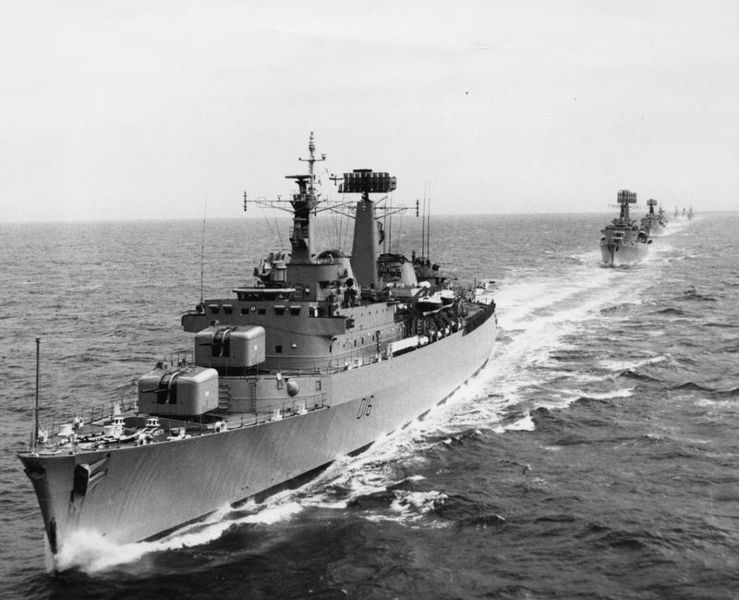
HMS London, a County class missile destroyer, leading other ships of the type in 1971, src: IWM.
The major surface threat in the 1950s was seen as the Soviet Sverdlov class cruisers operating against Western trade. So seriously was this possibility taken that two new designs were drawn up to deal with it, a cruiser and a super-destroyer. The cruiser was intended to provide air-cover with guided missiles and relied on rapid-firing 6-in guns as its main armament, while a new rapid-firing single 5-in gun was designed for the destroyers.
The cruiser would have displaced 18,000t (standard) and would have carried Seaslug missiles aft and fully automatic 6-in guns forward. The destroyer, on the other hand, relied on three 5in guns for air defence, and when the project was finally dropped as it was because it had no missile defence. The gun derived from the British Army’s land-mobile 5-in, reached an advanced design stage, but was stopped when the Ordnance Board recommended an end to ‘gunnery solutions to AA defence’ in 1958.
All that remained of this interesting design was the advanced steam machinery which was developed for the fast escort, stopped, and then cut down and married with the gas turbines for the County class missile destroyers, the larger fleet escort for which the Board opted, after much thought. The first two were ordered in 1955, followed by two further units in 1957. The more urgent need of frigates had meant that the first six Type 12 ships, intended as prototypes, had been ordered in 1951, followed by another twelve of slightly modified design in 1954.
These frigates were intended to be cheap, but this proved to be a vain hope. They were, however, a great success and are still widely regarded as one of the finest escort designs of the period in any navy. In 1952-55 a dozen cheaper, ‘utility’ Type 14 ships were laid down to supplement the Type 12s, and a simpler destroyer conversion, the Type 16, was put in hand.
Two other new classes of frigates were ordered in 1951, a standard diesel-engined hull in two variants, one for anti-aircraft defence and the other for aircraft-direction. It had been intended to make up numbers in both categories with more conversions of destroyers, but these plans were shelved when a change of heart by the Staff indicated that it would be possible to go back to building general-purpose warships. This change of policy was influenced by new trends in technology, with more compact machinery and electronics on the way.
Despite cutbacks and delays, however, the Korean War building programme had created an impressive escort force. By the end of 1958, twenty-four new frigates had been completed and thirty-four destroyers had been converted; in addition, twenty-one C class destroyers had received varying degrees of modernisation to improve their escort capability, and many of the slower “Loch” class had been rearmed.
The other area in which the Royal Navy invested heavily was mine warfare. Having suffered considerable casualties from the mining of harbours and estuaries, the British were understandably more sensitive about this than the Americans (who in any case had much deeper coastal waters) and when it was learned during the Korean War that Russian magnetic mines were proving immune to degaussing measures it was realised that a large number of new minesweepers were needed to replace the steel-hulled Algerines.
Between 1950 and 1960 some one hundred and twenty coastal minesweepers were built, concurrently with one hundred inshore types. The CMS design proved an outstanding success, robust and sufficiently seaworthy to detect and classify mines on the seabed so that they could be destroyed by a demolition charge. When this equipment was fitted, it perfected a number of coastal minesweepers as minehunters and over the years the new techniques replaced traditional sweeping as the major method to hunt mines in coastal waters.
British SUBMARINES of the cold war

Cutaway of the HMS Resolution (S22). Nuclear deterrence soon imposed domestic SSBNs, active by 1967.
By 1945 the Royal Navy had built up a formidable submarine fleet and there was no intention of frittering away such asset -Apart from the possibility of offensive use in wartime- the part of submarines was ruled to be essential in training ASW forces, and great attention was paid to German late technology with prolongated tests done with some Type XXI U-boats and Meteor propulsion system. It was decided to build two experimental hydrogen peroxide turbine propulsion systems and to modermize welded boats of the “T” class along the lines of the “M” class submarines with enlarged batteries and streamlined hulls.
The two peroxide boats proved expensive, but the experience gained was incorporated in a new design of diesel, the Porpoise class. This hull form was very successful and in the improved Oberon class, one of the major conventional designs of the period. What’s more, propulsion was enhanced by the successful adaptation of nuclear power which gave virtually unlimited thermal power without a large energy source. When USS Nautilus proved such a triumph in the US Navy, the RN immediately decided to switch to nuclear power, although the intention to “go nuclear” was there even if peroxide boats were built, and work on a prototype in Scotland, did not started until 1957, and fell so far that the Admiralty decided to buy a US reactor from the T-class and to put the Dounreay type classes.
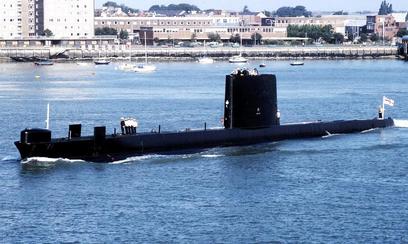
HMS Oberon – This class one the last conventional Britisn attack submarine to enter service (1961)
Since then a fourth and a fifth class has bee making the RN one of only five navies operating nuclear-powered subs. For some years it was believed that no mere “submersibles” would be built, but the cost of nuclear boats and manning them forced the resurgence of a conventional design, the 2400t SSK announced in 1979. These carried a similar armament but entered service in the early 1990s. In 1963 the momentous decision was make responsibility for the British nuclear deterrent from the RN, in the form of Polaris underwater-launched vectors: Submarines were ordered in 1963-64, but the Government cancelled the fifth boat in February in appeasement to its left wing. The entire project, and training of the crews, building four submarines and providing dedicated facilities, was carried through with great rapidity, one of the few major British defence projects to keep budgetary limits but become operational on time.
In July 1980 it was announced that four new new SSBNs, armed with Trident II missiles would be built. These would had a 6000 miles range, well outside the range of Soviet SBAs and would have eight independently launched missiles each carrying three warheads. Major components of the missile system came from the United States, but many sub-systems were made by British subcontractors, as the missiles themselves.
A NEW GENERATION OF WARSHIPS
Although the “electronic” components aged rapidly since 1940, during the 1950s the tendency was beginning to slow down to some extent in size of individual items of electronic equipments, assuming that the previous policy of building these could be discarded. The unsophisticated Tribal kit was now possible to build a general-purpose ftee destroyer. In 1960 the decision was made to build frigates to a totally recast design. The new hull now made possible to include a new generation of surveillance radars, combining a high-level awareness with a good measure of air warning.

HMS Ark Royal as modernized;
1966 and the end of the fleet air arm
The cancellation of the new aircraft carriers in 1966 was a traumatic experience for the Royal Navy, involving the resignation of the First sea lord, and loss of a chief striking force. The carrier Victorious hit was fire damage was the first to be reformed, followed later by HMS Eagle, and the naval air strike was from then handed over to the RAF. This crisis only showed inter-services rivalry flaring up, the RAF apparently succeeding in convincing the Secretary of State for Defence that carriers werevulnerable to strikes from land-based inter-continental ballistic missiles.
The Navy kept helicopters, but was to hand over its Buccaneer and Phantom aircraft to the RAF, with a contingent of RAF mixed aircrew with the surviving carrier’s air group. RAF squadrons took over the mission of protecting the fleet at sea, but this soon as predicted by many, proved unworkable. The RAF indeed was already overstretched in providing for the air defence of the United Kingdom airspace and in the even case planes dedicated to the fleet were serviceable, a few minutes delay in takeoff meant that they would arrive on the scene too late. But even after both services realised this could not continue, the politicians clung to their ruling there could never be any more aircraft carriers and at least not operated the kind of ships operating fixed-wings aircraft comparable to those in the US Navy as costs would have been crippling.
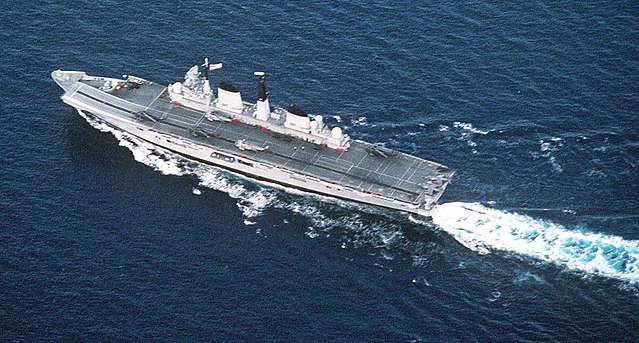
HMS Invincible in 1991
1967 compromises and the sea harrier
The answer would have to be found elsewhere. In 1967 serious thought was given to a “command cruiser” operating six large helicopters, similar to the French Jeanne d’Arc. Further studies showed greater efficiency would be obtained with nine rotary-wing aircraft stored in an internal hangar, with a starboard island and clear flight deck. A ‘through-deck cruiser’ as coined by the politicians, and soon the existence of the Harrier VSTOL naval version further complicated decision-making. It was decided ultimately to make sure that the design of the ship would accommodate the Sea Harrier if required. However this became a purely political struggle and the Sea Harrier was not considered before May 1975, more than two years after the ship had been laid down. In 1980 the first two squadrons were formed, giving the RN control over its own air power once more, and the debate now revolved around the aircraft type to replace one day the Sea Harrier.
Default in the cuirass: About the GIUK
In the mid-1970s the growing strength of the Soviet Navy in nuclear submarines was focusing attention on the so-called GIUK, the Greeland-Iceland-UK Gap. This “choke point”, through which subs of the Northern Fleet must pass through to attack targets in the North Atlantic had already been “bugged” with networks of passive sensors laid on the seabed to track their passage. Known as SOSUS (Sound Surveillance System), system needed massive, weatherly anti-submarine ships to patrol the area and strike targets defined by the SOSUS arrays. The US Navy defined the large Spruance class destroyers, but the RN opted for 4000 tons frigates armed with two helicopters, surface missiles and a new point-defence missile capable of defending against other missiles, and elaborated C5I.
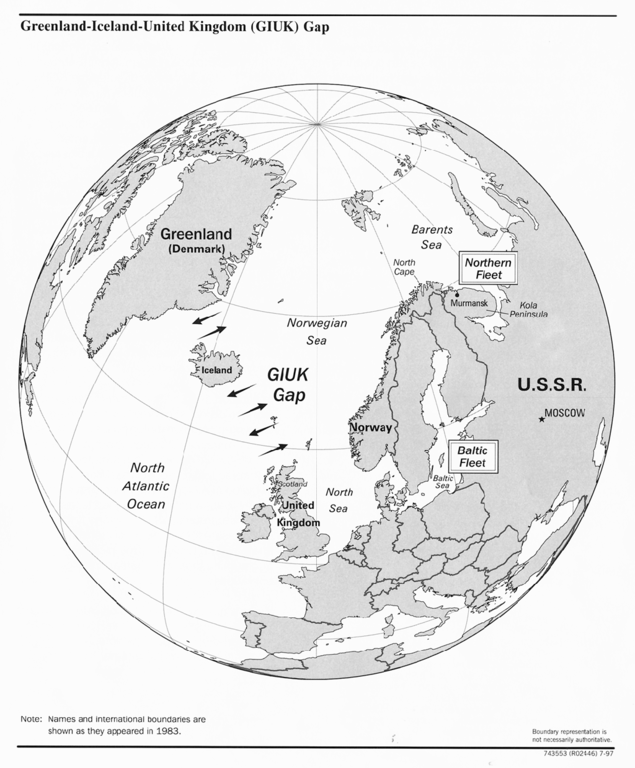
SOSUS and the GIUK gap
Late 1970s modernization costs overruns
The new missile had originally been conceived as an anti-aircraft weapons, but during development they were tailored to answer underwater-launched missiles and sea-skimmers. For years it was the only anti-missile missile system in service, but time was running out for the RN with the cost of new warships rising beyond control, linked to the need of protecting them against anti-ship missiles. Studies showed that a double-ended Sea Dart destroyer was to be over 8000 tons, with the cost of hundreds of millions of pounds. To make matters worse, the Royal Dockyards half-life refits costs became exorbitant with £70m to upgrade a Leander class frigate and £64m for a “County” class DLG in 1981.
1980s budget cuts
In 1981 the axe fell when the new Secretary of State John Nott, announced that the surface fleet would be reduced, with one of the three support carriers laid up or sold, no more than fifty ships overall and no more half-life modernizations approved. The Type 22 programme was replaced by a new economical utility escort known as Type 23. However to compensate, the nuclear hunter-killer programme was accelerated, and Type 2400 DE subs confirmed. HMS Bulwark was paid off, followed by Hermes (scheduled so) and HMS Invincible was “on offer” to the Australian Navy. In addition two DLGs and two Leander class frigates had been sold. Older frigates and some Leanders were also to be sold. And at that time the events on the south atlantic erupted.
THE FALKLAND’S CAMPAIGN (1982)
Note: This will be the object of a comprehensive post, possibly in 2022, for the 40th anniversary.
When Argentine forces occupied the Falkland Islands and South Georgia on 2 April 1982, the British Government immediately dispatched a task force to recapture the islands. Although the assembling and equipping of such a force around the carriers Hermes (flagship) and Invincible was a masterpiece of speed and efficiency (the carriers and several warships sailed and 5000 tons of military stores were loaded, all within seventy-two hours of the order to embark), the fighting around the Falklands showed that the Royal Navy was no longer adequately equipped for such operations. The fact that the Falklands are 8000 miles from Britain and that the nearest base was Ascension caused particular strain, but air attacks by Argentine shore-based aircraft showed that a small air group of fewer than thirty Sea Harriers was no substitute for a large carrier with high-performance aircraft.
The first blow came on 4 May, when the DDG Sheffield was hit by an air-launched Exocet missile from a Super Etendard strike aircraft. The missile failed to detonate, but it set the fuel tanks on fire and the ship had to be abandoned some hours later. She was taken in tow because the navy hoped to have the damage examined by experts at South Georgia, but when the weather deteriorated on 10 May the bumed-out hulk was scuttled. The strike against the Task Force was undoubtedly provoked by the loss of the old cruiser General Belgrano, which was torpedoed by the nuclear submarine Conqueror on 2 May. According to later claims by the British Government, Belgrano and her Exocet-armed destroyers were the southernmost element of a three-pronged attack on the Task Force, and the submarine’s CO was given permission to attack any hostile targets. Surprisingly the elderly Mk 8 torpedo was used, at a range of about 3000yds, rather than the long-range Mk 24.
Once the amphibious assault had got under way at San Carlos on 21 May, fierce air battles became an almost daily occurrence, and bombing or rocket attacks accounted for the DDG Coventry and the frigates Ardent and Antelope. The Navy found that the lack of airborne early warning aircraft made the Sea Harriers’ task much harder, and the older radars, 965 and 992Q, had great difficulty in tracking fast,1 low-flying air targets. The need for stronger close-range defence led to the use of troops and their GPMGs to provide AA fire, and ships still in the UK were hurriedly rearmed with twin 30mm and single 20mm guns, as well as additional chaff-launchers to give protection against guided missiles. The Vulcan Phalanx 20mm ‘Gading’ was acquired from the United States and two were put on the flight deck of the new carrier Illustrious.
A large number of merchant ships were chartered or requisitioned, including the luxury liners Canberra and Queen Elizabeth 2, with helicopter platforms, naval-standard communications and, in some cases, 20mm guns, added. The most elaborate conversions were the ro-ro container ships Atlantic Conveyor and Atlantic Causeway. The former took RAF Harriers to the South Atlantic and then acted as a ‘spare deck’ for aircraft and helicopters in San Carlos Water, while the latter was given a hangar and four anti-submarine Sea King helicopters. Atlantic Conveyor’s loss to an Exocet attack was a major setback to the timetable of Operation ‘Corporate’ for she carried a portable air-strip and refuelling equipment.
Ground-support aircraft were allowed to operate away from the carriers. Although the land forces got safely ashore, the Navy’s presence remained vital throughout, to move supplies and to provide cover against Argentine air strikes. A rash attempt by 5 Brigade to move without Sea Harrier cover led to the crippling of the LSLs Sir Galahad and Sir Tristram at Fitzroy, arguably the worst moment of an otherwise brilliant campaign in which numerically inferior forces had repeatedly out-thought and out-fought the opposition.
Two days before the surrender on 24 June, the DLG Glamorgan was hit by a land-launched Exocet missile, which wrecked her hangar and killed fifteen men, but by a near-miracle she escaped serious damage. The missile was detected on radar and correctly identified, giving her a vital seventy seconds to turn away and try to get out of range. As the Exocet was nearly out of fuel it did not strike with full force, and it seems that the warhead may have detonated only partially.

Royal Navy aircraft carrier HMS Invincible during the International Fleet Review which was part of Trafalgar 200.
The Royal Navy post-1982
Although the Falklands campaign halted the rundown temporarily, the 1981 cuts were merely postponed. The collapse of the Warsaw Pact in the late 1980s provided the Treasury with a strong case for reducing defense expenditure even faster. The ‘Options for Change’ policy review in 1990-91 reaffirmed the need for amphibious ships but the commitment made in the mid-1980s to maintain ‘about fifty’ escorts soon shrank to ‘about forty’, and older frigates were retired or sold off rapidly. A major casualty was the planned new nuclear attack submarine design, but the Trident programme remained sacrosanct.
The End of the Cold War (1980-90)
The Falkkands campaign had the advantage of stopping at least momentarily the budget cuts, but the rapid collapse of the Warsaw pact in later years provided ammunition to the treasury for further axe blows. In the mid-1980s however a commitment was held on to keep “about fifty” escorts and later “about forty” while older Frigates were retired. The “Option for Changes” of 1990 reaffirmed the need for a strong amphibious class, but the strongest blow fell on the new nuclear attack submarine program. The only component left unscaved was the sacro-sanct Trident program and its host four ballistic submarines.
The Navy found a solution to maintain ship by cutting through personal and automation. The Type 23 program ships were inded intended to be much more automated. On the other hand, UK retired from the NFR-90 European Frigate program in 1989. By late 1991 however intention to join the join French-Italian program for a common new AA Frigate. In 1991 also, the “Front Line First” review added more cuts, but it also forced the Navy to rethink its commitment as a rapid reaction force, well integrated into NATO but taking in account both the Falkland campaing and Gulf war in a post-cold war environment.
Two defence reviews in the early 1990s, ‘Options for Change’ and ‘Front Line First’ imposed severe financial cuts on the RN. Although a reduction in numbers was inevitable, the Navy evolved a credible alternative to the cold war/northwest European strategy which had been in place for 20 years. Profiting by experience in the Falklands and in the Gulf in 1990-91, the Navy offered a limited out-of-area capability to deal with sudden crisis, and to support United Nations’ peace-keeping operations. The result was renewed emphasis on amphibious warfare, and a reduction of the anti-submarine role in NATO’s Eastern Atlantic theatre.
British mine warfare policy
The Soviet Navy’s interest and expertise in mine warfare showed no sign of decreasing in the 1970s, and the replacements designed for the RN’s ageing coastal minesweepers proved to be, ton for ton, among the most complex and expensive warships ever built. To reduce their magnetic signature virtually to nil, it was necessary to design nonmagnetic diesels and build the hull of glass-reinforced plastic (GRP). GRP is expensive and difficult to fabricate on such a large scale, and the Brecon class are currently the world’s largest ships built of this material. They are known as Mine Counter Measures Vessels (MCMVs) because they can accommodate both hunting and sweeping functions in one hull.
Since 1982 MCM forces have been in action four times, including the clearance of Port Stanley, hunting for Libyan mines in the Gulf of Suez, dealing with Iranian mines in 1987, and finally, supporting the Coalition forces in the 1991 Gulf conflict. Five ‘Hunt’ class performed outstanding service in dealing with Iraqi mines laid off Kuwait City. As with larger warships, the government commitment to maintain a force of fifty modern MCM craft has not been honored. The thirteen ‘Hunts’ had been supplemented by twelve ‘River’ class MSFs and five Sandown class SRMHs, but by 1995 the force of ‘Tons’ had disappeared and there was no further role for the ‘Rivers’.
COMMONWEALTH NAVIES
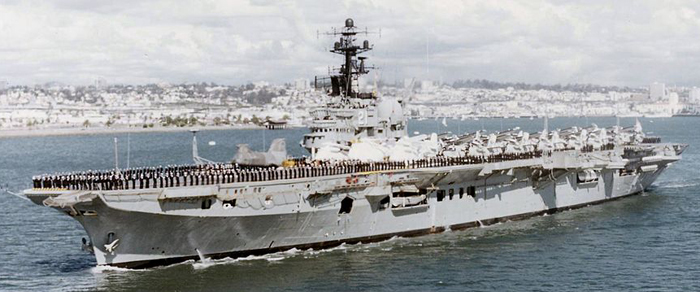
HMAS Melbourne at San Diego in 1977
The disappearance of the Empire weakened the links which bound the navies of Canada and Australia to that of Great Britain, and there was a steady drift away from a reliance on British equipment. The RCN was the first, purchasing USN weapons and electronics to make it easier to get spares in an emergency, and going as far as to design its own escort destroyers. The RAN, on the other hand, continued to build RN designs in its own shipyards for some years.
Ikara anti-submarine missile system and other e jointly developed. While South Africa Commonwealth the SAN relied totally on Brin. 1961 political pressure to prevent them fr equipment forced the South Africans to turn to the ‘New Commonwealth’ navies, principally fitted the traditional mold for a longer period indigenous resources, but Pakistan turned in to help and India to the Soviet Union. India’s policy of building up local resources to a point at could be expanded and even equipped with Sen.
WEAPONRY
The Royal Navy continued its policy of demanding high standards in its weapons and equipment, but the underlying which had become particularly evident after this 1948 largely frustrated this. Lack of money to buy equipment led to endless delays, some imposed by the navy’s bureaucratic machinery and others by the Treasury. In the end the result was always the same: Equipment placed into service far too late, making these obsolescent when operational. Other problems were caused by the temptation to allow too many committees to make alterations to specifications.
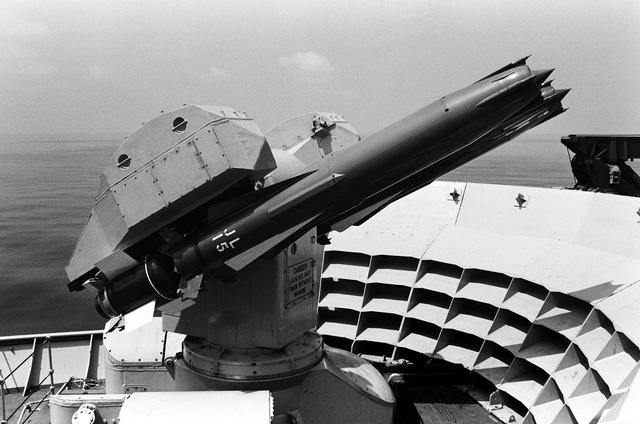
Sea Dart missile system onboard HMS Invincible
Thus, the Seaslug missile was made extraordinarily bulky on the advice of the Royal Aircraft Establishment (Farnborough), not believing reports that the American Terrier missile had its boosters mounted in tandem. For political reasons its is almost impossible to purchase foreign equipment, but when it is bought the immediate temptation has been to “Anglicise” it; This happened with the American Mk 56 fire control system, winch painful development re-emerged as the MRS3.
The beam-riding Seaslug gave way eventually to the much more effective semi-active homer Sea Dart, which followed the American ideas closely, and this weapon is currently being upgraded. The experience with lighter missiles has been happier, for the short range Seacat was designed to replace the venerable 40mm Bofors gun, and by being tailored specifically to one role it emerged as a relatively cost-effective close-range defence system for ships down to frigates.
 Armstrong-Withworth system Sea Slug AA missile system (1961)
Armstrong-Withworth system Sea Slug AA missile system (1961)
Replacement was to have been Sea Wolf, but the lengthy and costly, lengthy development enabled the designers to give it a capability against sea-skimming missiles. The system was further developed into a vertical launch (VL) system for the Type 23 frigates and AORs. A lighter type 911 tracker was produced, and the missile’s range has been increased from 10,000m to 14,000m. The problem for the RN is that it has shrunk in size without losing its front-line commitments, and as a result its production runs are short. This pushes up cost and explains why so many good ideas have to had to depend on export orders before they can go ahdea. It was hoped to persuade the Netherlands to buy Sea Dart in exhange for a Signaal 3-D radar, and the Type 22 frigate was also begun as a joint venture with the Dutch.
Since 1947 British torpedoes have earner poor reputation, most of it undeserved. Although the Mk8 submarines torpedo was by far the most efficient and cost-effective model used in WW2, it was hoped to replace it with faster and more accurate models using British wartime developments as well as German design ideas in 1945. The most promising was High-Test Peroxide (HTP), and this was used to drive high-speed fancy or 21in Mk 12. This weapon had to be withdrawn after a propellant causes and explosion which sank the submarine Sidon in 1955, but it was further developed by the Swedish Navy into the Tp61, a very safe and effective torpedo.
Several torpedoes were designed and then axed for some reasons, notably the Pentane and theMk30 Mod 1. The desperate need of a lightweight homing torpedo for helicopters, aircraft and frigates led to the purchase of American Mk 43, 44 and 46 models, but the Mk 43 became obsolete many years ago and the other two have been replaced by the Stingray.

Despite many problems, the Mk 24 Tigerfish came into service in 1970, being followed in the 1990’S by the new heavy Spearfish. The cancellation of the Undersea Guided Weapon programme force the navy to buy the USNs Sub-Harpoon to give its nuclear submarines a capability in long-range anti-ship means. Trials started in October 1981. This purchase was followed by the selection of the latest surface version, the RGM-84C, as the successor to the Exocet. The Netherlands 30mm CIWS Goalkeeper, a Gatling system was bought in exchange for the sale of Marine Sprey gas turbines to the RNIN. The experience of 1982 also led to increased expenditures on electronic warfare, and in 1991 the RN’s performances in the Gulf conflict proved that the money was well spent.
The Royal Navy Today (1995-2020)
After post-cold war massive (but previsible and necessary) budget cuts, the RN concentrated around its carriers and new destroyers programs, while modernizeing its SSN and SSBN fleet to keep the edge. The Royal Navy maintains as of today a technologically sophisticated, very well trained and maintained fleet, which includes one aircraft carrier (still without planes), two amphibious transport docks, four ballistic missile submarines (nuclear deterrent component), six nuclear fleet submarines, six guided missile destroyers, thirteen frigates and the same number of mine-countermeasure vessels plus 22 patrol vessels.
By the fall of 2018, two years from now, 75 registered commissioned ships composed. Additionally 13 ships serve with the Royal Fleet Auxiliary (RFA) and five Merchant Navy ships available under private finance initiative to replenishes the fleet at sea and amphibious forces when operating far from home. They also doubled that by taking on patrol duties, freeing frigates for other tasks. This came with a total tonnage of about 408,750 tonnes, for the strke fleet alone, and 743,759 tonnes including the Royal Fleet Auxiliary and Royal Marines. It is backed by 174 aircraft and helicopters, notably long range AAW patrol planes. This force is manned by 33,280 Regulars, 3,040 in the Maritime Reserve and and 7,960 in the Royal Fleet Reserve, all mobilizable in case of war.
Planification for 2020-2030 includes:
-Completion and commission of the Prince of Wales, second of the QE class carriers.
-Tree of seven Astute-class submarines
-First of four Dreadnought-class ballistic missile submarines
-First two of of eight Type 26 frigates/City class of 6900 tonnes.
-Ninth and last ocean-going River class patrol vessel.
-Program in early development and design work: Five planned Type 31 frigates of 5,700 tonnes.
Also development of small unmanned vessels for spec ops, such as the MAST-13, is ongoing for testng and development of the concept.
Current “fleet air arm”:
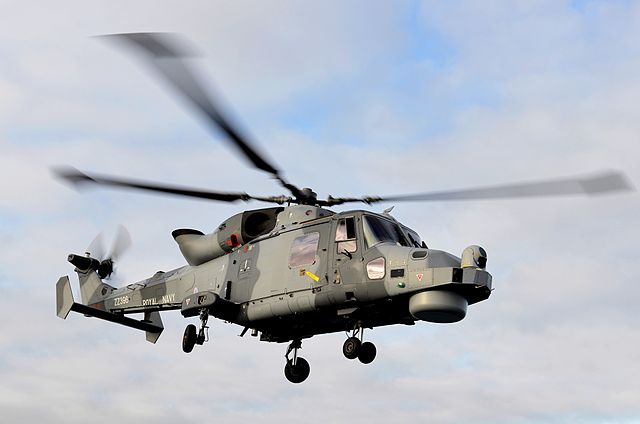
The Fleet air arm is composed of the following:
-About 24 (Total 48) Agusta Westland AW159 Wildcat (2009) multipurpose helicopters
-About 40? AW101 Merlin helicopters
-9 BAE Systems Nimrod MRA4 long range patrol planes
-About 15 transport Eurocopter AS365 Dauphin helicopters
-UCAAVs such as the rail-launched ScanEagle.
-Tutor and Hawk training planes (basic/advanced)
Also:
-In operational reserve since 2006: Sea Harrier GR7/GR9.
-To be retired: Sea King ASaC7. To be replaced by Merlin HM2 helicopters (“Crowsnest” programme).
And:
-F-35B Lightning II Joint Combat Aircraft (awaited) – 24 immediately after the POW is commissioned, and about 138 projected until 2023.
Cold War Ships of the Royal Navy
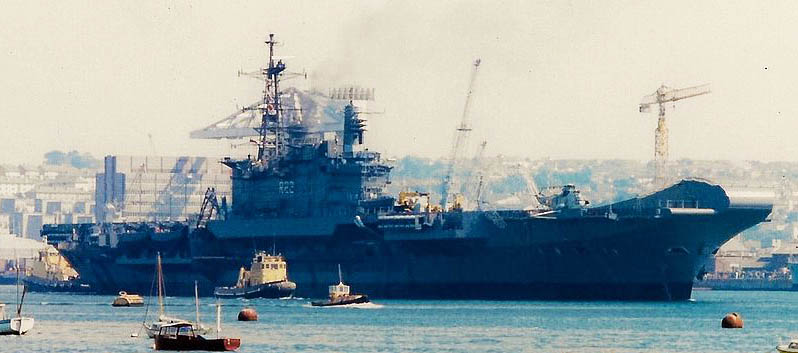
The last WW2 generation modernized fleet carrier, HMS Hermes, departing Devonport for India, as INS Viraat.
 Centaur class aicraft carriers (1947)
Centaur class aicraft carriers (1947)
Class: HMS Centaur, Bulwark, Albion
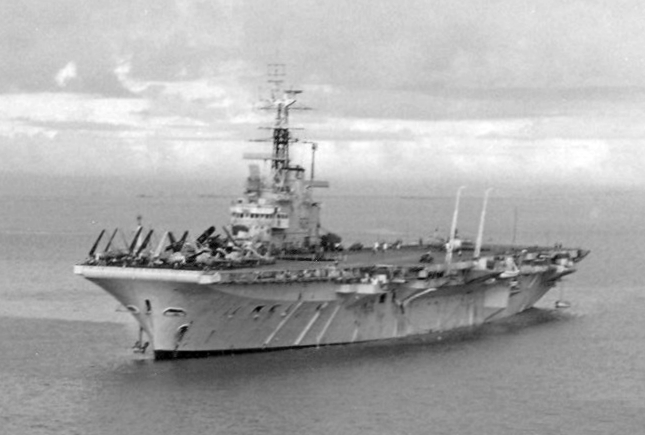
HMS Bulwark at Singapore in 1958 for exercize Ocean Link
Four completed units of a projected class of eight ‘intermediate fleet carriers’ were retained for the postwar fleet. One was so delayed that she eventually formed a separate type, but the other three, redesigned to incorporate as many wartime lessons as possible, were launched in 1947-48 and completed in somewhat leisurely fashion six years later. Almost as soon as the vessels were completed they were taken in hand for modification. An ‘interim’ or 5 degrees angled deck was added and this necessitated the removal of three twin Bofors guns from the port side. After the Suez operations in 1956 the ships were given steam catapults and stronger arrester wires, and the six-barrelled Mk 6 Bofors mounting abaft the island was removed to provide deck space.
They proved too small to operate the new generation of aircraft coming into service in the late 1950s, and in 1959-60 Bulwark was converted to a commando carrier. This involved the removal of her arrester gear and catapults, the provision of four assault landing craft (LCAS) in davits aft and the modification of her accommodation to allow 733 Royal Marines to embark. With eight helicopters in place of her former air group, she could land troops and vehicles ashore rapidly, and proved such a success that her sister Albion was similarly converted in 1961-62. Albion’s conversion was slightly more elaborate, and allowed her to embark 900 commandos. Plans to convert Centaur, however, were shelved because of rising costs, and she was paid off into reserve in 1966, to be scrapped six years later. The air groups varied during their careers. At Suez, for example, Albion was flying Sea Venom and Sea Hawk fighters, Skyrider AEW aircraft and Sycamore helicopters. At the end of her career Centaur carried four Gannet AEW aircraft and eight Whirlwind helicopters.
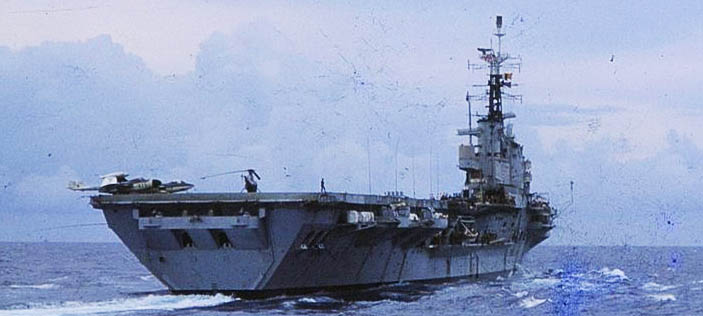
Stern of HMS Centaur underway to Ceylon
Specifications (After conversion)
Displacement: 22,00/27,00 tonnes FL
Dimensions: 224.8 x 37,5 m x 8.2 m
Powerplant: 2 shaft Parsons GST, 4 3-drum adm. Boilers 78,000 shp 28 knots
Armament: 32x 40mm Mk6 AA, 26 aircrafts as modernized
Electronics: Radar 984, 974, 983, 275
Crew: 1102 +300 air group
 HMS Victorious
HMS Victorious
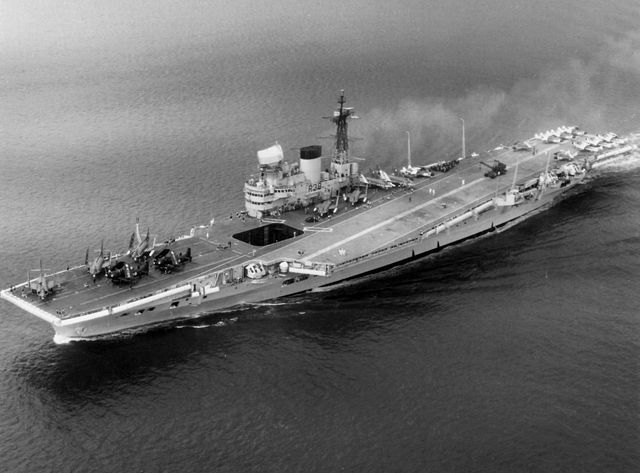
HMS Victorious circa 1959
HMS Victorious was virtually rebuilt from 1950 to the end of 1957 to allow her to operate modern jet aircraft. During the process the hull was widened, deepened and lengthened and the machinery and boilers replaced, although it was only decided in 1955 to replace the boilers. Two steam catapults, an angled deck and mirror landing sights were provided, as well as a 3-D radar and faster lifts. The major item of the reconstruction was the provision of a massive sponson on the port side for the 8%4 degrees angled deck. This extended the flight deck 35ft 6in outboard and was the first fully angled deck fitted in a British carrier. The new island was rapid growth in size of the latter meant that she never carried more and the Mk 6 Bofors were removed former armamnent was completely replaced by six twin 3in/50 Mk 33 automatic gun mountings purchased from the US Navy, mounted one on each side forward and two on each to compensate for the weight added.
During the 1962-63 refit the flight deck was strengthened and an access gangway was provided outboard of the island. The ‘flyco’ on the inboard side of the island was extended and enlarged and the mirror sights were replaced by projector sights. When she recommissioned on 14 January 1958, Victorious was the most modern British carrier, but although it had originally been hoped that she would operate fifty-four aircraft, the than twenty-eight (plus eight helicopters) and finally carried only twenty-three (eight Buccaneers, eight Sea Vixens, two Wessex). In 1968 she suffered a minor fire while refitting, and as the decision had already been taken to run down the carrier force she was summarily put on the disposal list and sold for scrapping the following surmounted by a huge ‘searchlight’ array for the Type 984 3-D radar, the first to go to sea.
Two parallel-track 145ft steam catapults were provided and because of the angled deck there were only four arrester wires, cach with an average span of 80ft. A major internal improvement was to nearly double the generating capacity to 4200kW, but even this had to be increased to 5000kW in 1962-63. The side aft. In addition one six-barrelled 40mm Mk 6 automatic mounting was positioned on the starboard side between thc boạt crane and the after 3in guns. Each gun mounting was controlled by its own CRBF (Close Range Blind Fire) director positioned alongside. During a May 1962-August 1963 refit two 3in mountings Gannets and fire enlarged and the mirror sights were replaced by projector sights. When she recommissioned on 14 January 1958, Victorious was the most modern British carrier, but although it had originally been hoped that she would operate fifty-four aircraft, the summarily put on the disposal list and sold for scrapping the following year.

HMS Victorious (R38) after reconstruction and modernization. Author’s profile for the future poster.
Specifications (After conversion)
Displacement: 30,530/35,500 tonnes FL
Dimensions: 225.5/238m x 31,5/47.8 m x 9.5 m
Powerplant: 3 shaft Parsons GST, 6 Fosters Wheeler Boilers 110,000 shp 31 knots
Armament: 12x 3-in/50 Mk33, 6x 40mm Mk6 AA, 36 aircrafts as modernized
Electronics: Radar 984, 974 193Q
Crew: 2400
 Aircraft Carrier HMS Eagle (1946)
Aircraft Carrier HMS Eagle (1946)
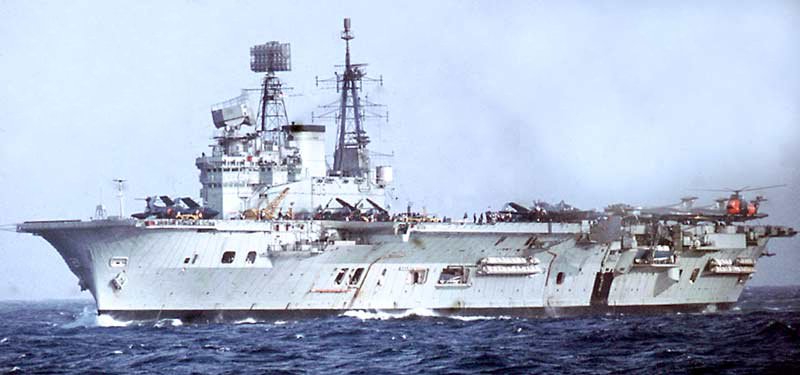
Originally intended to form one of a class of four 32,500t improved Implacables, Audacious was quite far advanced at the end of the war and was therefore earmarked for completion more or less as designed. Her name as changed to Eagle in January 1946 because the original Eagle had just been cancelled. Her surviving sister det Royal, however, was held up to allow numerous improvements to be incorporated, and so the two ships differed in many details. A new legend was drawn up in 1946 for both ships, raising 36,970t (standard), 45,720t (deep).
Eagle’s design followed closely the pattern of the wartime armoured carriers, with eight twin 4.5in DP gun mountings in quadrantal sponsons, but the close-range armament was the most modern available. Eight six-barrelled 40mm Bofors Mk 6, each with its own CRBF fire control director, were mounted, four on the port side, two on the starboard side and one at each end of the island. In addition there were nine single 40mm Mk 7 on the island and on the port side, and before completion two twin 40mm Mk 5 were added in a sponson under the overhang of the flight deck at the stern. Original first refit provision of radars comprised the models 960, 982, 983, 275, 262, 974. Also in 1951 she was armed with sixteen 4.5 in/45 Mk6, forty-eight 40mm/60 Mk6 AA, four 40mm/60 Mk5 AA, 9x 40mm/60 Mk7 AA, and had a total of 60 aircraft, of course piston-engine at that time still, but the first few jets such as the De Havilland Venom.
See also: https://youtu.be/epS1HRZpDyY
This gave the phenomenal total of twelve radar directors controlling 16 4.5in and 48-40mm barrels, with a further 13-40mm barrels control. As the only large modern carrier, Eagle was a major addition to the RN’s strength when she started her builder’s trials in October 1951. On trials she made 30.53kts at 44,250t 156,630shp and 29,6kts at deep load (49,950t). Endurance was calculated at 4500nm at 24kts. She took part in her first major operation, the NATO exercise ‘Mainbrace’, at the end of 1952.
From June 1954 to February 1955 she was under refit, emerging with a 5° angled deck and the new mirror landing sight. Apart from realignment of the arrester wires and other flight deck fittings, the change necessitated the removal of one Mk 6 Bofors mounting from the port side; the three single Mk 7s were also removed from the port side of the island. On 1 November 1956 Eagle’s Sea Hawks, Wyverns and Sea Venoms began six days of attacks on Egyptian airfields and positions during the Anglo-French attempt to seize the Suez Canal.
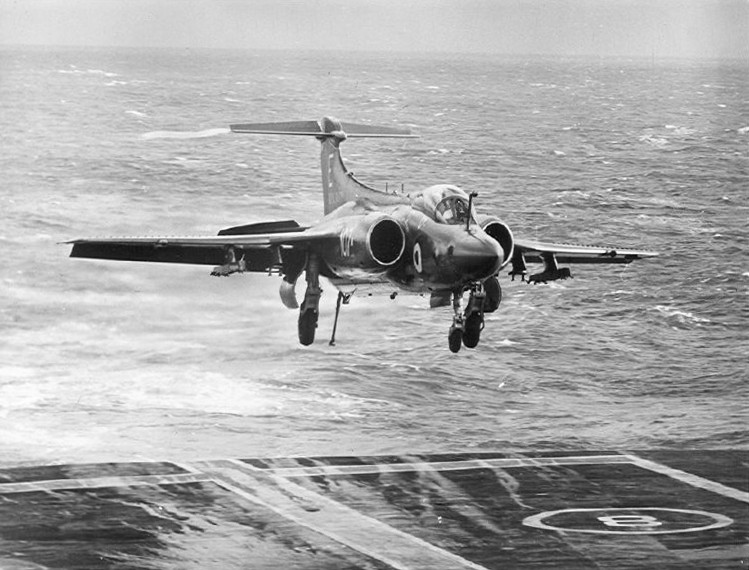
Buccaneer landing on the Eagle in 1971
The air group flew 621 sorties despite having a defective catapult. On her return to Devonport she had a short refit and then returned to the Mediterranean, where she spent most of the remainder of the commission. From mid-1959 to May 1964 she underwent complete rebuilding at Devonport to bring her up to the standard of Victorious: a fully (8°) angled deck, steam catapults and the long-range 3-D air warning Type 984 rader were fitted. The opportunity was taken to renew her boiler fire-bricks, for these had given constant trouble since completion. In addition, Confrontation by maintaining stand-ing air patrols over the Malacca Strait. No sooner was this crisis over than she sailed for Aden to provide reinforcements and then had to provide air defence for Zambia against possible invasion from Rhodesia. The ‘Beira Patrol’, a blockade to prevent oil from reaching Rhodesia, involved the identification of more than seven hundred ships and the covering of 200,000 square miles of sea each day, and it kept Eagle at sea for seventy-one days.
As rebuilt in 1959-1964 she was given a short lattice foremast carrying “double bedstead’ surveillance radar, a Type 965 (AKE-2) and the forward 4.5in sponsons were removed to increase internal accommodation. The close-range armament was entirely replaced by six quadruple Seacat GWS22 SAM systems, four sponsoned port and starboard forward and aft, one right aft under the flight deck overhang and one on the starboard side between the island and the after sponson. A less obvious but important improvement was to boost the generating capacity to 8250kW, nearly double the original power, while flight deck armour was reduced from 4-in to l-in.
With the growing size and complexity of aircraft, and as the after half of the lower hangar was now given over to workshops, the complement dropped to thirty-five fixed-wing aircraft and ten helicopters, half the complement envisaged in 1942. In 1954 she had operated fifty-nine aircraft, Avengers, AEW Skyraiders and a Dragon-fly helicopter; ten years later she had Sea Vixens, Scimitars and Gannets.
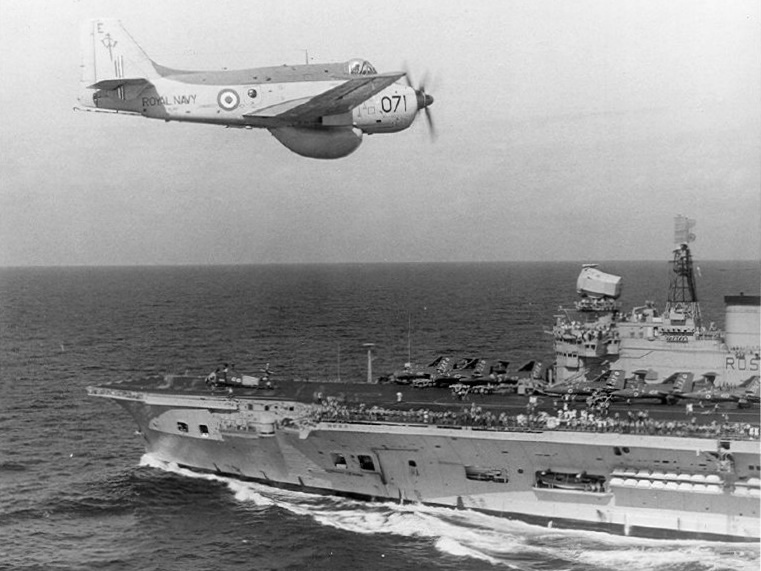
Fairey Gannet over the Eagle in the 1960s
In 1964 the ship sailed for the Far East to help contain the Indonesian axe the RN’s carriers, on the flimsy pretext that she would cost too much to convert to operate Phantoms; in fact she had already operated Phantoms and needed only minor modifications her flight deck 01 equipment. She was paid off at Portsmouth in January 1972 and was laid up at Devonport later the same year. Although Eagle was officially in fully including Sea Hawks, maintained reserve, the difficulty of keeping Ark Royal running meant that she was progressively ‘cannibalised’, and she was finally towed away to the breakers in 1978.

HMS Eagle in the Mediterranean January 1970
Specifications (1964)
Displacement: 45,000 – 53390 tonnes FL
Dimensions: 219,5/247.4 m x 34.3/52.1 m oa, 11 m
Powerplant: 4 shafts Geared Turbines, 8 adm. 3 drum boilers, 152,000 shp 31 knots
Armament: 4×2 4.5-in, 6×4 Seacat GWS22 SAM, 45 aircraft
Electronics: Radar 984, 963, 965 (AKE-2)
Complement: 2750 with air group
 Aircraft Carrier HMS Ark Royal (1950)
Aircraft Carrier HMS Ark Royal (1950)
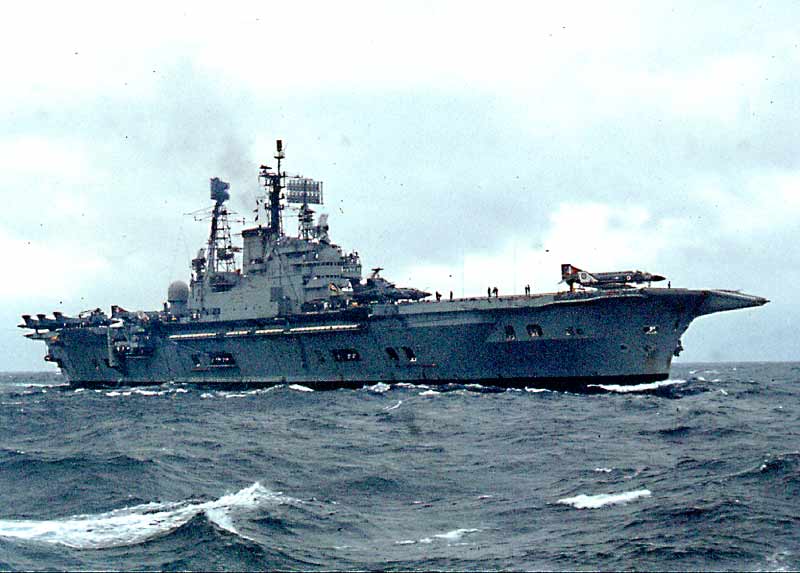
HMS Ark Royal North Atlantic July 1976
Although often claimed to have been projected as HMS Imresistible, there is no official record of this name. The ship was in fact laid down 18 months after the previous Ark Royal was sunk, and there was every reason to reserve that name for a new carrier. She was not very far advanced at the end of the war and so the opportunity was taken to change the design considerably, but this made her completion more and more protracted, until she became the butt of comedians’ jokes. She finally started trials in June 1954 and entered service in February 1955.
The most important alteration was to provide her with a deck-edge lift, as in US carriers. It was never a great success because it served the upper hangar only, and in any case the device was not really suited to the British type of closed hangar. The port forward 4.5in guns were never installed because the ship went to sea with a 5° angled deck, and this also meant a smaller number of 40 mm guns on the port side, as in Eagle. She had a tall lattice foremast, and a different island. Her initial armament in 1955 comprised twelve 4.5 in Mk6 DP guns, thirty-six 40 mm Mk5 AA, six Mk7 AA and 50 aircrafts.
As with Eagle it proved difficult to accommodate two 210ft steam catapults on the foredeck, and so when these were installed in 1967-70 an unusual deposition was adopted, with one on the port side forward and the other in the waist. Ark Royal underwent many more changes than Eagle. In 1956 the starboard 4.5in turrets were also removed, followed by the forward pairs (port and starboard) of the after group in 1964 and the rest in 1969.
During the 1959 refit the side lift was removed to allow the hangar to be enlarged, and in 1961 a deck-landing projector sight was installed, with the “Hilo’ long-range guidance system and stronger steatween March 1967 and February 1970 she underwent a major refit to allow the operation of Phantom F-4K interceptors and Buccaneer S2 strike aircraft. This involved removing the last of the 40mm guns; it was planned to replace them with four Seacat missile systems, but these were never installed. New armament comprised eight 4.5 in, tenwty-eight 40 mm AA and 48 aircraft. Electronics suite comprised the radars 960, 982, 983, 275 and 974.
The radar outfit always differed from Eagle’s. As built, Ark Royal had two Type 982 ‘hayrake’ scanners and two Type 983 height-finders, with Type 262 fitted to the directors controlling the 40mm guns, and Type 275 controlling the 4.5in. In 1959 a catapults. Be-‘double bedstead’ Type 965M aerial was stepped on a short lattice mast forward of the mainmast; in 1967-70 a second 965M was added on a much taller lattice mainmast, and a large dome abaft the island, housing a Carrier Controlled Approach (CCA) radar of US origin, was fitted. Although completed later than Eagle, the ‘Ark’ was never as mechanically reliable, and had the 1966 Defence Review not cancelled her replacement (CVA-02) she would have been scrapped first.
In 1966 it was felt that she might last until 1972 without major repairs to her machinery, and the fact that she staggered on for another six years is testimony to the heroic efforts of her engineers. Although hard-worked she missed all the important actions except the Indonesian Confrontation, and had it not been for a thirteen-week TV serial called ‘Sailor’ she might never have endeared herself to the public in the way that she did. Despite efforts to raise money to preserve her the MoD steadfastly refused to sanction any unworthy scheme; in any case the sums talked of were wildly unrealistic, and she was towed away in the autumn of 1980. After she had been paid off at Devonport in December 1978 her name was given to the third of the Invincible class.

Conway’s profile of the Ark Royal as of 1977
Specifications (1969)
Displacement: 43,340/53,060 tonnes FL
Dimensions: As HMS Eagle but 50.1m (164ft 6in) deck overall width
Powerplant: As Eagle
Armour: As Eagle
Armament: 4 GWS22 Seacat SAM*, 36 aircraft
Electronics: Radar 965, SPN-35
Complement: 2637
 Aircraft Carrier HMS Hermes (1953)
Aircraft Carrier HMS Hermes (1953)

When the original order for Hermes, sixth of the Centaur class, was named was given to Elephant of the same class; very little work was done on the hull, however, giving time for the specification to be revised. Thus, while the three Centaur class went ahead with their ‘interim’ standard of equipment, Hermes was radically redesigned to include a 6° angled deck, celled in October 1945, the ou a side lift and a Type 984 3-D long range radar with Comprehensive Display System (CDS). Although the deck-edge lift was unusual in British carriers (the first was still being installed in Ark Royal) it was dictated by the need to find space for the steam catapults at the forward end of the flight deck. Once the forward centreline lift was suppressed the side lift was needed to work aircraft, and it also provided a convenient extension to the angled deck area.
The appearance of the ship was very different from that of her former sisters, with a massive ‘dustbin’ scanner for the Type 984 radar over the istand, The superstructure was considerably enlarged, but the armament was reduced to five twin 40 mm Bofors (two port, three starboard) controlled by MRS8 directors. In 1964-66 she was refitted and the Hermes Bofors were replaced by two quadruple Seacat close-range SAM defence systems, in the after port and starboard sponsons. Another improvement was the addition of the ‘Alaska highway’ outboard of the island. In 1971-73 the Type 984 scanner was dian Ocean and Far East she had to be withdrawn from front-line service because she could not operate the new F-4K Phantom, which had replaced the Sea Vixen.
In 1971 she paid off for conversion to a commando carrier, losing her arrester wires, catapults and 3-D radar. In 1977 she was rerated as an ASW cargap until completion of Ark Royal and served until 1984. Her last air group as an ASW carrier consisted of nine Sea Kings and four Wessex Mk5s, but at the end of 1980 she embarked five Sea Harriers and nine Sea King Mk 2s. Although threatened with premature scrapping under the 1981 defence cuts, she acted as flagship of the Falklands Task Force April-June 1982, during which time she embarked twenty Sea Harriers and ten Sea Kings.
Paid off in 1984, but in 1986 she was refitted and there its radar was replaced by a Type 965 bedstead’ and a massive array of deck-landing lights was provided on the foremast and bridge. The main difficulty with Hermes was her small size, for when she commissioned at the end of 1959 she could only operate twenty Sea Vixen, Scimitar and Buccaneer and eight Gannet ASW aircraft. After serving in the Atlantic, Mediterranean, with Sea King helicopters in place of the Wessex Mk Is, but she has now undergone conversion to operate a squadron of Sea Harrier STOVL aircraft. This conversion also includes the provision of a 7° ski-jump ramp, extended the full width of the flight deck. In her new role Hermes bridged the vonport and sold to India; transferred at Devonport on 12 May 1987 and renamed Viraat.

Authors’s profile in 1970
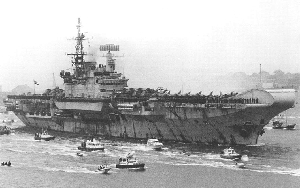
Conways’s profile in 1982
Specifications (As rebuilt 1960)
Displacement: 23,900/28,700 tonnes FL
Dimensions: 198.1/226.9 m oa x 44.1/48.8m oa x 8.8 m
Powerplant: 2 shafts geared Turbines, 4 Adm. 3-drum boilers, 76,000 hp, 28 kts, range 8000? nm
Protection: 40 mm (2-in) over the magazines, flight deck 19 mm (1.1 in)
Armament: 5×2 40 mm Mk5 AA, later 2×3 GWS22 SAM, 28 aircraft
Electronics: Radars 984, 982, 296, 974
Complement: 1830+270 air group
 CVA01 class Fleet Aircraft Carriers (Cancelled 1966)
CVA01 class Fleet Aircraft Carriers (Cancelled 1966)
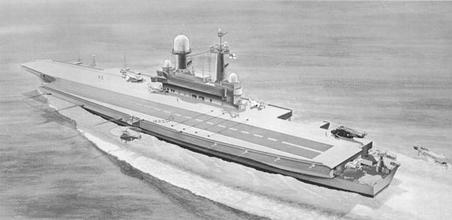
The story of the last class of fleet carriers designed for the RN is a harrowing one – although it must be said that the cancellation of the programme in 1966 necessary, if only to save the Navy from getting the wrong carrier – and it will remain a classic example of how a design can be ruined by constraints. The MoD needed two new fleet carriers to replace Victorious and Eagle in the early 1970s and their role was seen as providing strike power against airfields and hostile ships, and air defence for the fleet. It was hoped that the project would be backed by the RAF as well, using the planned joint RAF/FAA swing-wing ‘strike fighter’ as the principal unit of the air group. When that aircraft died stillborn the new carrier design (designated CVA-01 or Attack Carrier, as was absolutely in the USN) hit its first problem. The second was purely political, for both Lord Mountbatten and his VCNS were certain that the Treasury and the ‘bomber lobby’ in the RAF would oppose a large carrier.
This proved to be the case, and when it was pointed out that a carrier capable of accommodating the latest aircraft and catapults of the necessary length would displace over 60,000t, the politicians asked for the length of catapult to be reduced (!). To cope with such ill-considered requests the designers cut the catapults from four to two and eliminated the deck park, reducing displacement to 55,000t, but there was still pressure to cut the size to 30,000t, half as big as the original target. Even though the design was changed to a “furniture van’ concept, with very light structure, no armour and only a novel form of underwater protection against torpedoes, it could not be reduced below 50,000t. Speed was restricted to 27–28kts, but after doubts were raised about putting so much power out through two shafts, the old 3-shaft system of the Illustrious class was re-adopted, so that one engine could be closed down for maintenance and still leave enough power for Fleet speed.
The flight deck layout was unusual, offset to port, but angled at only 32°, The passageway (known as the ‘Alaska highway’) fitted in Hermes and other carriers was made even wider, allowing aircraft as well as vehicles to be moved forward and aft reasons. Things got worse. To fit all the requirements in such a small hull, many ingenious ideas were adopted. This was a recipe for disaster, as experience shows that only some 20-25 per cent novelty can be accepted in a design; more than this raises insoluble problems. With hindsight the biggest blunder was the political one of confusing size with cost, but given without disturbing the deck park. There were other novel features, such as doors at the after end of the hangar to allow the engines to be run inside, and a new ‘scissors’ type of lift.
It had been hoped to have two Anglo-Dutch ‘Broomstick’ radars housed in radomes forward and aft, but it was at the Treasury’s insistence that CVA-01 should not exceed the full load tonnage of Eagle there was very little that either Staff or Ship Department could do. Not for nothing did the project leader refer to the cancellation as the happiest day of his life. The design work was authorised in July 1963 and ended in February 1966 without an order being placed. soon discovered that two radars of this type would have to be kept very far apart – miles in fact! – to avoid mutual interference, and so one was dropped. Two BS6 catapults were planned, with water-spray type arrester gear. Displacement had been kept to 50,000t but when 2000t of armour were added, the total continued to be referred to as 50,000t for political The death of the fleet carrier replacement programme in February 1966 did not mean the end of plans for air-capable ships.

Invincible class Aircraft Carriers (1977)

By 1967 an outline Staff Requirement had produced studies for a 12,500t command cruiser carrying six Sea King helicopter designated CCH, The ship was an helicopter-carrying cruiser, and that is what she was: a derivative of the Tiger class, with a missile/gun armament forward and a large external hangar aft, as in the French Jeanne d’Arc.
Simple logic dictated that ‘cleaning up’ the superstructure and moving it to the starboard side would provide more deck space, although any attempt to do this was likely to be regarded by the politicians as resurrection of the fleet carrier. But studies continued to show that increasing the air group to more than nine helicopters must lead to through deck’ or clear flight deck and island superstructure, if only to provide sufficient internal space for the hangar and workshops. Thus, despite the difficult climate, the design staff prepared designs for what were to be called ‘through-deck cruisers’ rising from 17,500t to 19,500t and with the growth in size it became possible to consider the possibility of using short take-off/vertical landing (STOVL) strike aircraft.
The RN had refused to accept the original P1154 STOVL fighter on the grounds that its lacked space through decks or the the island superstructure, if only to provide sufficient internal space for the hangar and workshops. Thus, despite the difficult climate, the design staff prepared designs for what were to be called ‘through-deck cruisers’ rising from 17,500t to 19,500t and with the growth in size it became possible to consider the possibility of using short take-off/vertical landing (STOVL) strike aircraft.
The RN had refused to accept the original P1154 STOVL fighter on grounds that its lack of navigational radar and short endurance would give it a very low capability at sea. But in the interim the designers of the successful subsonic Harrier had pressed ahead with a Sea Harrier equipped with a more powerful engine, more fuel and new avionics which would provide the pilot with computer-aided navigation and attack data. In effect, advances in electronics have made it possible to do away with the observer while still reducing the pilot’s work-load.
In May 1975 it was officially announced that the new TDC would carry Sea Harriers, although the capability had long since been designed into the ship to avoid subsequent delays; in service nine Sea Kings and the five Sea Harriers are embarked. The Sketch Design was ready at the end of 1970, but the order was not placed until April 1973. For a long time there was no mention of any sisters, but in May 1976 No 2 (Illustrious) was ordered, followed by No 3 in December 1978.
The third ship was planned to be called Indomitable, but immediately after the old Ark Royal paid off it was announced that her name would go to the new ship. There are many novel features in the design. First, it is the largest gas turbine-powered ship in the world, with four Rolls-Royce Olympus units coupled to two shafts. Second, the emphasis is on large internal volume to allow the maintenance of virtually all equipment by exchange; in other words, everything down to the gas turbines and operating consoles has to be removable. This had already been achieved in other gas turbine ships, but the Invincible design carries it much farther. Because of the lack of armour and the use of much lighter alloy, the volume of the hull is big for its tonnage.
Invincible is the first ship equipped with the new Type 1022 long-range air warning radar and she also has a double-headed Sea Dart guided with Type 910 weapon-system, trackers at each end of the island and a twin-arm launcher on the centreline forward. The provision of Sea Dart had been criticised for an alleged reduction of the flying capability, but it must be remembered that the Sea Harrier is a subsonic strike aircraft, not a supersonic interceptor, and therefore the ship (and other vessels in company) needs a long-range, rapid-reaction defence against air attack.
While Invincible was under construction a very simple improvement was perfected which revolutionised flying at sea. This is the ‘ski-jump’, a ramp which gives the Sea Harrier sufficient lift to enable it to take off using less fuel or carrying more payload. In Invincible and Illustrious it takes the form of a 47t light steel structure welded on to the port side of the flight deck, rising at an angle of 7° over the bow, but it has the effect of adding 1500lb of payload to the Sea Harrier; Ark Royal will have a steeper performance improve ramp further. The euphemism ‘through-deck cruiser’ (CAH) was subsequently changed to ‘command cruiser’ which was a reasonable title: much of the cost of Invincible is accounted for by (Communications, mand and Control), and above all she is a flagship, having effective control of submarines and surface ships.
By the time that Invincible came into service, however, the term ‘carrier’ was back in favour, and she is now rated as a support carrier (CVS). It remains to be seen what developments in STOVL aircraft will take place in the next decade or so, but the Invincible class promise to be very effective anti-submarine ships, taking the most potent ASW helicopters far out to sea, but able to protect them from attack by enemy bombers. Their principal role is clearly to patrol the Greenland-Iceland-UK Gap in support of ASW forces operating behind the SOSUS barrier.
As the first Western ships designed to exploit fixed-wing STOVL aircraft they are having a marked influence on other navies. Following the 1981 Review Invincible was offered to the Defence Royal Australian Navy as placement for Melbourne. The offer was accepted, subject to modifications to fuel stowage, communications, etc, when the Falklands Crisis intervened. She sailed with Hermes on 5 April, but did not return until relieved by Illustrious in late August. During the campaign she embarked nine Sea Harriers and ten helicopters. Illustrious was rushed to completion with the addition of two 20mm Phalanx ‘Gatling’ guns (one forward to starboard of Sea Dart, one right aft on starboard side of the flight deck). Invincible was similarly fitted but Ark Royal was fitted with three Goalkeeper CIWS (one in bows on centreline, one sponsoned on port side at after end of the flight deck, and one sponsoned to starboard of the island).
Invincible refitted at Devonport during April 1986 – January 1989 to similar standard as Ark Royal, with a longer ski-jump and 12 degrees exit angle, enlarged accommodation etc. Illustrious was to follow in 1989 but she was laid up in reserve for two years because of financial problems. Preliminary work started on this £100m refit in August 1991, and full reconstruction in mid-november. She and her sisters will also receive enhanced EW and CI systems.
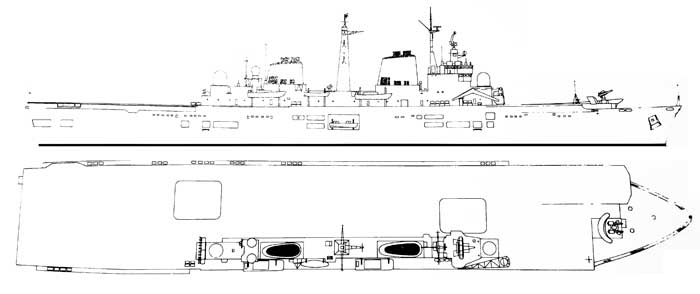
Specifications
Displacement: 16,000/19,500 tonnes FL
Dimensions: 192.6/206.3 m oa x 27.5/35 m oa x 7.7 m
Powerplant: 2 shafts CODOG, 4 Olympus Gas Turbines, 112,000 hp, 28 kts, range 5000 nm
Armament: 1 Sea Dart GWS30 SAM, 2 Phalanx CIWS, 14 aircraft
Electronics: Radars 1022, 909, 1006, Sonar 184M
Complement: 447+318 air group
 HMS Argus – Aircraft training ship (1989)
HMS Argus – Aircraft training ship (1989)
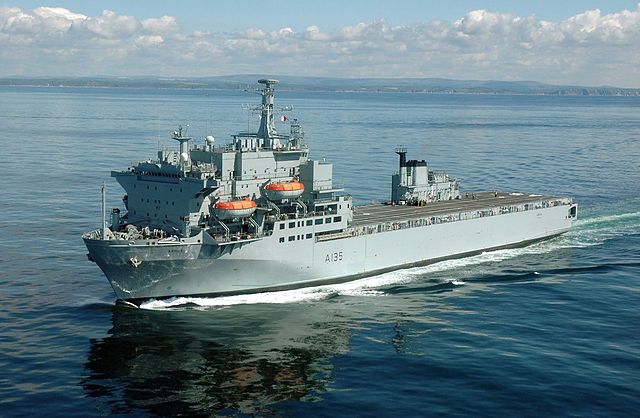
Although not strictly an aircraft carrier, being a replacement for RFA Engadine, this former roll-on/roll-off and containership functions as an auxiliary carrier, as the choice of an old carrier name signifies. She has a wartime role as a ferry carrier and hastaken part in exercises as a ‘spare deck’. In the Gulf conflict in 1991 she was hurriedly converted to a hospital ship but also operated HC4 Commando troop-carrying helicopters. Her peacetime role is to take ASW helicopters out to their deepwater exercise areas (saving fuel and flying time), and in wartime she can ferry up STOVL aircraft. She has a naval standard ops room and AIO, and full communications equipment to enable her to operate with the Fleet. She is civilian-manned by the RFA, with naval air group and command twelve Sea Harrier team embarked.
She was taken up from trade in 1982 and returned to her owners, but purchased outright in 1984. Converted to ATS by Harland & Wolff during April 1984 March 1988, she was dedicated on 1 June 1988, relieving Engadine the following year. During conversion three watertight bulkheads were added and to compensate for weights and a 5ft layer of concrete was also added above the hangar (serving incidentally as splinterproof protection).
 Tiger class cruisers (1945)
Tiger class cruisers (1945)
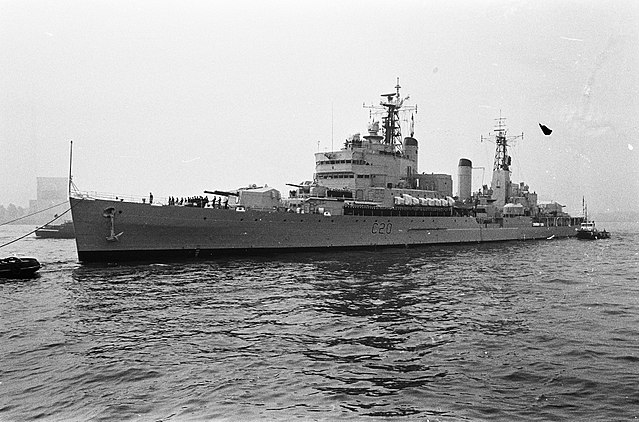
HMS Tiger at Rotterdam before conversion
These vessels were at the same time the last cruisers of WW2 since they were launched in 1945, on plans dating back from 1940, and the first and last British cruisers of the cold war. Although the decision to complete the last three of the Tiger class to a new design was made by the Board of Admiralty in 1951 (a move strongly opposed by many), the dismantling of the old structure did not start until 1954. The new design had two twin 6in Mk 26 DP automatic mountings, one forward and one aft, with three twin 3in Mk 6 AA mountings in ‘B’ position and abreast the second funnel.
The internal fittings reflected the needs of a new generation of naval warfare; air conditioning throughout, a 200-line telephone exchange and a computer-aided Action Information Organisation AIO). Each mounting had its own MRS3 fire-control set (basically an Anglicised version of the US Navy’s Mk 56 with a Type 903 dish scanner): there were two above the bridge, one aft and one on each side amidships. Radars included a Type 960 masthead dipole array for air warning (range 170 miles), Type 992 for surface search at the masthead (range 30 miles), and a Type 277Q height-finder on the mainmast (range 120 miles).
The armament was impressive, each water-cooled 6in barrel capable of delivering 20rpm. The 3in could theoretically deliver up to 120rpm; in practice achieved. 90 rpm was the best figure obtained in practice. Like most attempts to produce perfection, the Tigers were too late, arriving on the scene just when the gun solution to AA defence was going out of fashion. Although fine, modern ships, there was little they could do other than engage smaller warships with gunfire or bombard shore positions. Their excellent command communications however, still made them useful as task group flagships, and it was decided to give them more flexibility by replacing one 6in turret with a hangar and flight deck for four helicopters.

HMS Tiger after reconstruction in 1965
This was approved, and in 1965-69 Blake was refitted at Portsmouth, followed by Tiger at Devonport in 1968-72. Lack of money prevented Lion from being taken in hand and she was put on the disposal list in 1975, but not before so much equipment and facilities had been ‘cannibalised’ that her sister was nicknamed Liger’. As reconstructed, displacement rose to 9975t standard, 12,080t deep load, and armament was now 2-6in Mk 26 (1 x 2), 2-3in Mk 6 (1 x 2), 2 Seacat, GWS 22 SAM systems (2 x 4) and four Wessex (later Sea King) helicopters. New sensors consisted of radar Types 965, 992Q, 278 and 903. As refitted Blake had a particularly ungainly profile, with a huge box hangar from mainmast to stern.

HMS Blake and USS Nimitz in the English Channel on 4 October 1975
When Tiger emerged in 1972 her funnels considerably squared-off caps, and after another commission this improvement was given to Blake as well. Both ships proved useful in their new role, but their big crews made them expensive to maintain, and when the manpower shortage hit the Royal Navy in the late 1970s they were prime candidates for the disposal list. In any case the decommissioning of Hermes and Bulwark had remedied the previous shortage of ASW helicopter ships, and so in 1979 Tiger was put on the disposal list, while Blake was laid up at Chatham in January 1980. Blake was not sold until 1982 while Tiger lasted until 1986.

HMS Blake after reconstruction, Key West 1979

Conway’s profile of the Tiger
Specifications (Light Cruiser)
Displacement: 9550/11700 tonnes FL
Dimensions: 163.8/169.3 m oa x 19.5 x 7 m
Powerplant: 4 shafts geared Turbines, 4 Adm. 3-drum boilers, 80,000 hp, 31.5 kts, range 6500 nm
Armament: 2×2 6-in/50 Mk21, 3×2 3-in/70 Mk6
Electronics: Radars 960, 992Q, 277Q, 903
Complement: 903
 Minotaur class cruisers (1947 & 1951 design)
Minotaur class cruisers (1947 & 1951 design)
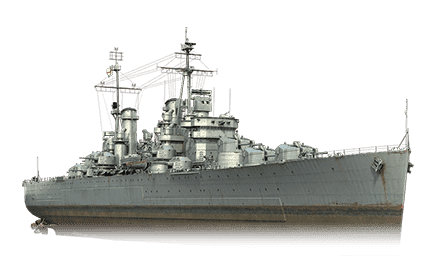
wow’s rendition of the Minotaur, design 1947
The Neptune design of 1944 was dropped at the end of the war, and in its place a new design was developed, known as the Minotaur class. Instead of the triple 6in Mk 25, the ships would have had five twin Mk 26 mountings, capable of rapid fire (12-15rpm) at 80° elevation. The layout would have been virtually an enormously expanded Dido with three turrets forward and two aft, but there would also have been a heavy secondary battery of 3in guns and TT. They would have been much inferior to the US Worcesters owing to their heavy electrical equipment. The most important innovations were a flush weather deck and a ‘staggered’ machinery layout. The design was clearly influenced not only by war experience, but by the magnificent designs produced by the US Navy for the Pacific. Three main design stages were reached, following a Controller’s meeting early in 1946.
Each time the design was slightly reduced in size, but finally lack of money forced the Navy to abandon any idea of building a new cruiser class for the time being. Although four ships, Minotaur, Centurion, Edgar and Mars had been planned in 1945, no contracts were placed. A decision was deferred on the Minotaur class, allowing work to continue on refining the design. The last revision found is dated 1951.
which time the need for other pres of warship was taking priority. It must be assumed that the project had died by 1952-53.
1949, 1960 cruiser designs
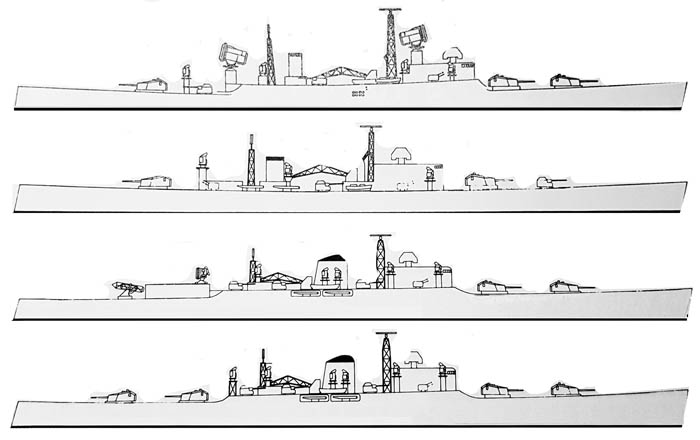
It was felt that a traditional cruiser with the ability to operate independently for long periods was still necessary to carry out the duties of trade protection and area anti-aircraft defence of the fleet. However, it was also believed that such a ship had an offensive function or convoys protection as well, and these joint requirements led to a series of design studies around 1948-49 for ships which could be in service in about ten years’e and were therefore referred to the ‘1960 cruisers’.
They were to have some or all of the following features:
Surface gun armament; long and short range AA armament (with missiles if possible); speed, endurance and seakeeping; at least splinter protection to vitals; torpedo, and ASW armament; aircraft direction capability; command and communications facilities. Radical solutions, such as nuclear propulsion, were deliberately excluded in order to meet the proposed schedule, which in turn was determined by the delivery of major Wolf new weapon systems – the twin 6in Mk 26 and 3in/70 in 1953, 5in/70 and a new close-range weapons (DACR) in 1957 and the Seaslug SAM in 1958. Conventional steam machinery was adopted (improved Daring type), and the armament was arranged to obviate all physical fouling between guns necessary because of high training speeds and automatic control).
Details of four variants are cluded here, although there is no evidence that the construction of any type was ever seriously planned. A light cruiser design was under consideration in mid-1949, but very little information has survived. More is to come about these projects.
 Daring class destroyers (1952)
Daring class destroyers (1952)
Class: Dainty, Daring, Defender, Decoy, Delight, Diamond, Diana, Duchess

Rendition of the HMS Daring – Conways
Although similar big destroyers were built abroad, in 1953 the Admiralty decided that they should be rated as Daring type ships’ and manned as light cruisers, under a captain, with bugle-calls instead of pipes, etc. These ships were divided into two groups: Dainty, Daring, Defender and Delight had a 220v DC electrical installation whereas the others had the new 440v AC system which was to become standard. Starting in 1963 the class was modernised, with all TT removed (the after bank had been removed in 1958-59), the STAAG Bofors mounting in the bridge wings removed and the Mk 6M director replaced by an MRS3 type. The DC group received two more twin Mk 5 mountings in place of the STAAG, but the others had Mk 7 singles in the bridge wings.
In 1963 HMS Decoy was fitted with a quadruple Seacat short-range missile launcher abaft the second (visible) funnel, but although firing trials were successful it was decided not to refit the rest of the class, and the launcher removed. The system MRS8, a reworked CRBF director with new below-decks equipment. Diana and Daring were temporarily fitted with a streamlined after funnel casing a short while after completion at the personal wish of Mountbatten; It was better for the looks, but restricted the arcs of fire of the aft twin Bofors and was removed after a few years. The ships served on all stations and gave good service, but as the design had already been stretched there was insufficient room for new sensors and weaponry. Duchess was transferred to the Royal Australian Navy in 1964 to replace HMAS Voyager and retained her name, and in 1970 HMS Decoy and Diana were sold to Peru, becoming Ferré and Palacios.
Specifications (As built)
Displacement: 2830/3580 tonnes FL
Dimensions: 118.8 x 13.1 x 4.1 m
Powerplant: 2 shaft double-reduction geared turbines, 2 FW/B&W boilers, 54,000 hp, 34.75 kts
Armament: 3×2 4.5in/45 Mk6, 6x 40mm/60 Mk5, 1 Squid
Electronics: Radars 903, 262, 293, Sonars 170, 174/177
 Cavendish class destroyers (1958)
Cavendish class destroyers (1958)
Class: Caesar, Cavendish, Cambrian, Carron, Caprice, Cassandra, Carysford, Cavalier

HMS Canvendish in 1964 (IWM)
In 1953 the first of the class (HMS Carron) was taken in hand for modernisation and by 1961 all eight had been recommissioned. This enhanced the ships’ capabilities as general-purpose escorts, with the latest Mk 6M fire control, remote power control (RPC) fitted to the guns, and the after TT replaced by a deckhouse with two Squid ASW mortars and a twin Mk 5 Bofors AA gun. HMS Caesar, Cambrian, Caprice and Cassandra had an enclosed frigate-style bridge, which was left open on the others of the class. In 1966 Caprice and Cavalier received a quadruple Seacat GWS20 missile system in place of the Mk 5 Bofors, and this necessitated a big handing room on top of the original deckhouse. Shortly after recommissioning Carron was attached to the Dartmouth Training Squadron, with a large navigating bridge in place of ‘B’ gun. In 1960 she became a navigation tender attached to Dryad and had the rest of her armament removed. HMS Cavalier paid off in 1972, but avoided the breakers. Being the last RN ‘conventional’ destroyer, strenuous efforts were made to preserve her as a memorial. Finally she was acquired by the HMS Cavalier Trust in 1977 and is now open to the public on the Tyne.
Specifications (As converted)
Displacement: 1964/2675 tonnes FL
Dimensions: 110.6 x 10.9 x 4.4 m
Powerplant: 2 shaft Parsons Geared Turbines, 2 Adm. 3-drum boilers 40,000 hp 36.75 kts, range 2800 nm
Armament: 3x 4.5in/45 Mk45 CPS mounts, 2x 40 mm Mk5 AA, 2x 40mm Mk9, 2 Squid, 1×4 21in TTs
Electronics: Radar 192, 293P/Q, 978/974, 944
 Weapon class radar picket (1958)
Weapon class radar picket (1958)
Class: HMS Battleaxe, Crossbow, Broadsword, Scorpion

HMS Crossbow 1964
In 1958-59 all four vessels were converted to radar-pickets, with a tall lattice mast between the (visible) funnel and the foremast, carrying a Type 965 long-range radar array. The TT were removed and a continuous deckhouse ran aft as far as the original superstructure. The opportunity was taken to move Battleaxe’s and Broadsword’s twin Squid mortars and handing room from ‘B’ position back aft, and to resite the twin 4in gun forward; they were now identical with the other two ships in layout. The old Mk 6 director over the bridge was replaced by an MRS8 director.
On 1 August 1962 Battleaxe was badly damaged in a collision with the frigate Ursa in the Clyde and was laid up. The class were superseded by the “Battle’ conversions, with their more elaborate air-plotting facilities, and were put on the disposal list 1964-66.
Specifications (As converted)
Displacement: 2280/2935 tonnes FL
Dimensions: 111.2 x 11.6 x 4.5 m
Poerplant: 2 shafts Parsons geared turbines, 2 FW Boilers 40,000 hp 34 kts, 5000 nm range
Armament: 2×2 4.5in Mk16 AA, 4x 40 mm/60 STAAG Mk2, 2x 40 mm Mk9, 2 Squid/Limbo
Electronics: Radar 965, 293, 262, Sonars 170, 174/177
 Battle class radar picket (1960)
Battle class radar picket (1960)
Class: Agincourt, Aisne, Barrosa, Corunna
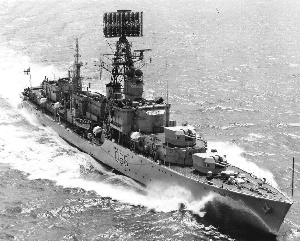
In 1960 four of the second group vere taken in hand for conversion to radar-pickets. This involved stepping a larger lattice foremast to carry the Type 965 radar array, with its double bedstead’ AKE-2 antenna. The original AA and TT armament was removed and a new after superstructure built, with a short lattice mast carrying a Type 978 height-finder array. Abaft this was an MRS8 director and a quadruple Seacat missile launcher. The original Mk 37 fire control director was left and so was on the the Squid ASW mortar quarter-deck. Internally the ships were totally rebuilt to improve habitability and to provide a new AIO. All four conversions were completed by the spring of 1962, but the ships were all on the disposal list in 1970. They were originally DC (direct current) ships and had to converted to AC (alternating current) to provide power for the new radars and the Seacat missile system.
Specifications (As converted)
Displacement: 2780/3430 tonnes FL
Dimensions: 1155 x 12.3 x 4.7 m
Powerplant: 2 shaft Parsons Geared Turbines, 2 admiralty 3-drum boilers 50,000 hp, 35.75 kts, 4400 nm range
Armament: 2×2 4.5in/45 Mk5 DP, 2x 20 mm AA, Seacat GWS22 SAM, Squid ASW
Electronics: Radar 965, 293, 262, 278, Sonars 174/177, 170
Project: The 1946 Fleet Aicraft Direction Escort (FADE)
Recent research by the World Ship Society has unearthed a hitherto unsuspected project, the 1946 Fleet Aircraft Direction Escort (FADE). It was to be longer than the Darings, with a maximum speed of 31.5kts, and would carry two large Type 980 radars (later replaced by Type 960). Priority was given to the Type 41 and Type 61 frigates, so design work was slow, and the project appears to have been dropped in 1949. At least two ships were planned, and in 1947 a FADE conversion of an Abdiel class minelayer was considered. The FADE mission would have been to extend early warning of hostile aircraft, to extend the range at which considered. The friendly aircraft could be controlled and to act as a rallying point for returning aircraft.
 County class guided missile destroyers (1960)
County class guided missile destroyers (1960)

The term ‘destroyer’ was applied to these ships approval, but they were later rated as DLGS, from the American term obtain Treasury ‘Destroyer Leader, Guided Missile’, applied to the new generation of big fleet escorts. As in the USN ships, however, destroyer principles governed their design: there was no longitudinal subdivision and the ships had relatively light scantlings to keep down size and weight.
Like the Whitbys the design was volume-critical, and in particular it centred on the Seaslug missile system. Seaslug was a first-generation beam-rider, with its four booster-motors wrapped around the body. British guided weapons of the period relied on wrap-around boosters because it was feared (incorrectly) that end-on mounting of the booster would produce instability in the missile after launch.
Thus although the new DLG had ample vertical space between decks for upright stowage and loading through deck-hatches, she had to be given a horizontal ‘tunnel’ through the superstructure. The missiles are brought up from the forward magazine on a hoist and then travel through the tunnel, undergoing checkouts, fitting of wings, etc, before being run out on to the launcher.
This was somewhat engineered, massive lattice-work affair weighing as much as a gun turret. Although the figure of thirty-six rounds is quoted, it is believed to be hulk, less in view of their bulk.
Four ships were voted under the 1955-56 and 1956-57 Estimates, followed by another four under the 1961-62 and 1964-65 Estimates. The second group had the slightly improved Seaslug Mk 2, externally identical, but having some capability against surface targets. They were also fitted with the ‘double bedstead’ AKE-2 version of the Type 965 long-range radar and had GWS22 directors controlling the Seacat missiles in place of GWS21. For the first time in a British warship, the design included provision for a medium helicopter, but arrangements for housing the Wessex – a hangar with a folding vertical door on the port side of the superstructure cumbersome.
The ‘Counties’ were, together with the ‘Tribals’, the first ships to have Combined Steam and Gas turbine (COSAG) machinery; main drive is supplied by twin HP and LP steam turbines and twin gas turbines are geared to the same shafts for boost. The system has the advantage of permitting the ship to get under way at short notice, as well as providing more power at high speed without excessive weight. They were expensive to man and maintain, and so HMS Hampshire was paid off in 1976 to be cannibalised. In 1972 Norfolk began a conversion to operate the new French Exocet surface-to-surface missile: four MM38 canisters were mounted in ‘B’ position, with special deflectors to avoid damage to the bridgework from the booster. She carried out firing trials in 1974, making her the first RN operational warship to fire an SSM. She was also refitted with a Pakistan in 1982. Kent was deleted in April 1980, but remained in service for harbour training. The later ships had good command facilities and were intended to last until the late 1980s, until all three Invincible class carriers were in service, but under the 1981 defence cuts they went earlier.
HMS Antrim
consideration for sale to Egypt after conversion to carry six Lynx helicopters in the former missile loading space in the main deck, but this fell through in 1978 and she too went on the disposal list. London had been earmarked lighter tubular foremast carrying a Type 992Q radar scanner, a modification subsequently extended to HMS Antrim, Fife and Glamorgan which so received Exocet. The older ships ere refitted with GWS22 Seacat vectors.
The limitations of the Seaslug missile system, inherent in the fact that it s a beam-rider, mean that these dsome ships were of diminishing Glamorgan and were damaged, one by bombs, the other by bombs and an Exocet, in the Falklands. Some were though of for conversion to minelayers – again the Seaslug ‘tunnel’ would prove ideal – to meet the need for operations behind the SOSUS barriers in the Greenland-Iceland-UK (GIUK) Gap. All four of the later ships were sold to Chile. Norfolk was transferred in April 1982; Antrim in June 1984, Glamorgan in October 1986, and Fife in August 1987.
Specifications
Displacement: 6200/6800 tonnes FL
Dimensions: 153.9/158.9 x 16.4 x 6.2m
Powerplant: 2 shafts COSAG, 2 GS turbines, B&W boilers, 4 G6 gas turbines 60,000 hp combined, 30 knots, range 3500 nm
Armament: 2×2 4.5 in/45 Mk6, Seaslug SAM, 2 Seacat GWS21/22, 2x 20 mm AA, 1 helicopter
Electronics: Radars 965, 277/278, 992Q, 901, 903/904, Sonars 170, 174/177
 Bristol class guided missile destroyers (1969)
Bristol class guided missile destroyers (1969)
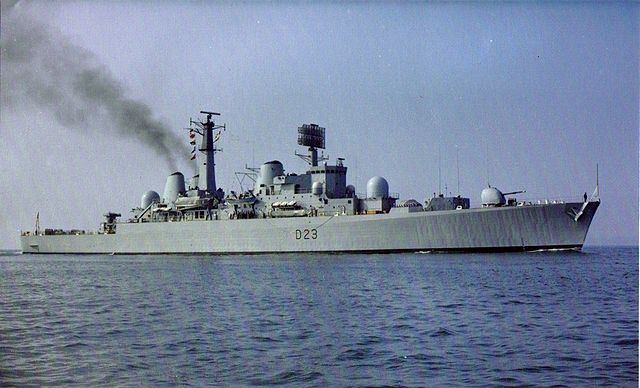
The new carriers planned for the 1970s (see CVA-01) would need escorts to provide them with anti-aircraft and anti-submarine defence and so four new DLGS were planned to follow the “County’ class. Although rated as DLGS, for some reason they were given Type No 82 in the general-purpose frigate series (originally known as CF299 frigates). With the cancellation of CVA-01 in 1966 it would have been logical to cancel them as well, and indeed the Board of Admiralty was willing to accept seven extra Leander class frigates in their place, but a trials ship had been promised for Netherlands ‘Broomstick’ radar project in the hope that the Netherlands would order the Olympus gas turbine.
Finally, the class was cut back to one unit, the reason being that she could act as a trials ship for new the Anglo-weapons. Although superficially resembling “cleaned-up’ “County’ class, the design incorporated another generation of equipment and ideas. The Sea Dart missile version of the system used vertical stowage and a twin-arm zero-length launcher like USN systems, and is a semi-active homing missile with a much greater capacity to handle multiple targets.
Although the same type of COSAG machinery was adopted, much more attention was paid to providing good access to the gas turbines. The result was that the design changed from a single-funnel to a two-funnel configuration and finally to three funnels, the after uptakes being split into two separate funnels to allow access to the Olympus gas turbines. Bristol was thus the first RN ship to be designed around the new concept of upkeep by replacement, which reduces the time spent on machinery overhauls. Although nearly 1000t bigger than the ‘Counties’, she needed seventy men fewer to run her.
She was also the first RN ship to go sea with the Anglo-Australian Ikara ASW missile system, mounted in a ‘zareba’ forward of the bridge.
The new 4.5in Mk 8 gun in a Vickers mounting replaced the old Mk 6 twin, but only one was provided, in ‘A’ position. Work had been proceeding on a joint Anglo-Netherlands project to produce a Comprehensive Display System (CDS) radar for air warning, surveillance and aircraft direction, and it was to be mounted over the bridge, but the rising cost of research and development, combined with the belief that there would be no need for such a system because there would be no carrier-aircraft to direct, led to Britian withdrawing from the scheme.
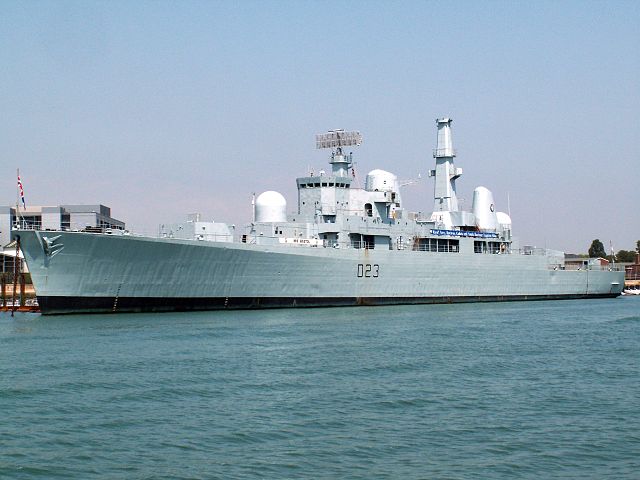
HMS Bristol disarmed at Portsmouth as of today
At the same data from the radar and sonar plots, the inertial navigation system, and any other source, and processed it via a suite of digital computers. In 1973 the ship suffered serious, almost fatal, damage when her steam plant was virtually destroyed by fire. For a time it was feared that she would be scrapped, but she was able to complete the Ikara and Sea Dart trials programme running only on the two gas turbines. This helped to convince doubters about the wisdom of time, the Netherlands was disenchanted with the spiralling cost (and volume) of the Sea Dart missile system; by mutual consent the CDS was dropped, and Bristol went to sea with the less capable Type 965 (AKE-2).
Although sometimes criticised as being a ‘white elephant’ she was an extremely versatile ship, with sophisticated command and communications to back up her weapon systems. The only serious shortcoming was the lack of a helicopter hangar, omitted because she was originally intended to operate with carriers. After completion she was used for weapon and system trials, and as a result never received the minor improvethe change to all-gas turbine propulsion, and since then the steam plant has been repaired. She was intended to receive a big half-life modernisation in 1981 but this was rescinded. However Type 1022 radar replaced Type 965 and other improvements were made. given to other large ships. The heart of Bristol’s weapon systems was the Action Data Automation. She served for a while as a training ship.

Conway’s illustration of the Bristol in 1979
Specifications (as built)
Displacement: 6700/7700 tonnes FL
Dimensions: 149.3/154.3 x 16.8 x 6.8 m
Powerplant: 2 shaft COSAG 2 GS Turbines, B&w boilers 2 Olyumpus TMIA Gas Turbines 30,000+44,000 hp 30 knots, range 5000 nm
Armament: 1x 4.5 in/55 Mk8, Twin Sea Dart GWS30 SAM (32), Ikara (32), Limbo Mk10
Electronics: Radar 902, 978, 1006, 92/993, Sonar 184, 162
 Sheffield class guided missile destroyers (1971)
Sheffield class guided missile destroyers (1971)
Class: Sheffield, Birmingham, Cardiff, Coventry, Newcastle, Glasgow, Exeter, Southampton, Nottingham, Liverpool
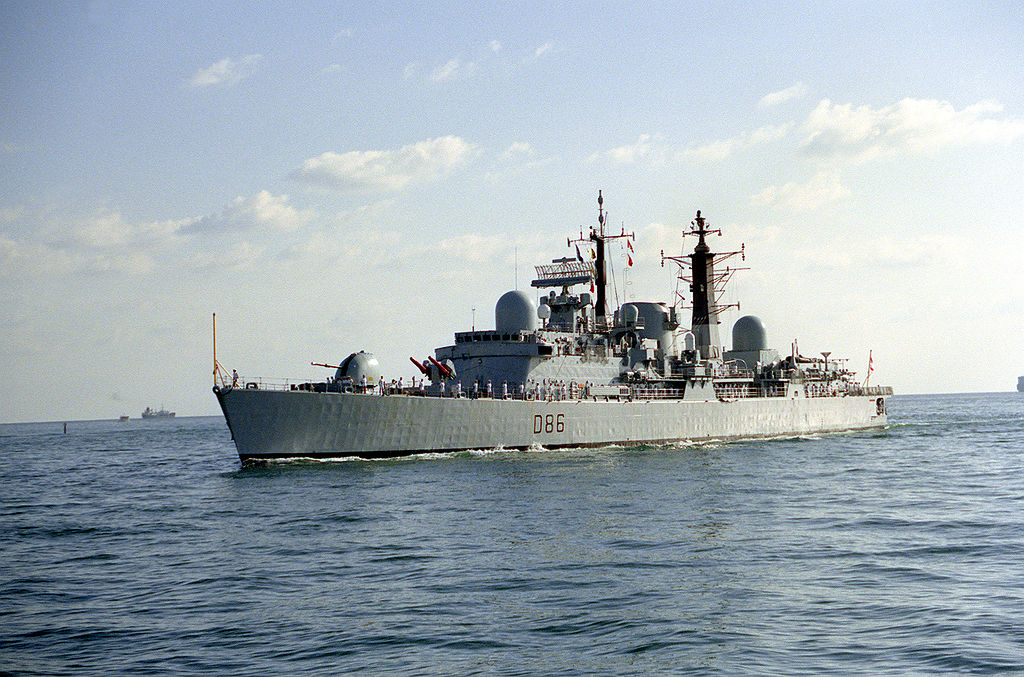
The cancellation of CVA-01 led to a new Staff Requirement for a smaller fleet escort capable of providing area defence. The result was the Type 42 guided missile destroyer (DDG), which achieved significant savings on cost and displacement by dropping the Ikara long-range ASW missile and Limbo mortar and adopting an all-gas turbine (COGOG) propulsion system, using Rolls-Royce Olympus turbines for main drive and Tynes for cruising.
Although lacking Ikara, the ASW capability was greatly improved over previous ships by providing a hangared Lynx light helicopter (armed with torpedoes and missiles). Unlike Bristol the forecastle deck extends right aft to form the helicopter flight deck, leaving a small covered quarterdeck below for handling mooring wires. Close-range ASW defence is provided by triple TT similar to the USN Mk 32, firing Mk 44 or Mk 46 weapons, but eventually to fire the new Stingray lightweight torpedo.
Apart from having the Sea Dart twin-arm launcher forward (a lighter hand-operated version of the type in Bristol), the configuration is similar to Bristol: Type 909 Sea Dart trackers forward and aft and a Type 965 (AKE-2) air warning radar above the forward superstructure. The appearance is quite different from previous DLGS, with a single wide funnel. Sheffield appeared with prominent ‘Loxton Bends’ on each side, an attempt to keep her heat signature down, but this was not repeated in following ships. Exeter commissioned in 1980 with the new Type 1022 interim STIR radar in place of the double 965, and this set was retro-fitted to the earlier ships.
Sheffield did not receive her STWS TT, but the others carried them on small platforms abreast the mainmast. The main weakness of the Sheffield class lay in the constraints placed on dimensions during the design phase. As a result of Treasury pressure the length and beam were kept down, resulting in cramped accommodation and reduced endurance. The problem of endurance was shrugged aside on the grounds that the ships had no ‘East of Suez’ role and would always be within reach of a replenishment group around the coasts of north-western Europe, but the short forecastle affects their seaworthiness by making them very wet forward. This fault has been rectified in later vessels (see below), but it places severe limits on what can be added to the surviving ships. The layout of the machinery compartments also easy removal routes, and a complete change of gas turbine can be carried out by the ship herself: all that is needed is easy sheltered anchorage and a crane capable of lifting the turbine in its module.
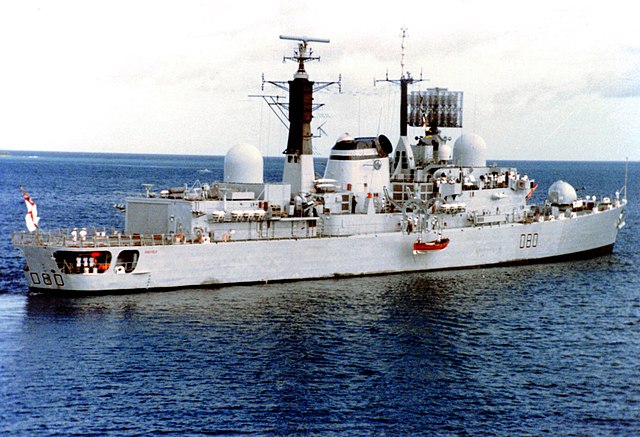
Stern view of the HMS Sheffield
With ten ships completed between 1975 and 1981 they were the largest class of major ships built for the RN since 1967, During the Falklands Campaign the survivors were fitted with 4-30mm Oerlikons (2×2) and two single 20mm amidships, had their EW enhanced and US chaff systems added. In addition, the Lynx helicopter received the Sea Skua air-to-surface missile, rushed into service. Later the 30mm guns were replaced by Mk 15 Phalanx CIWS. The high degree of automation has resulted in a reduction of one hundred men over Bristol’s complement. HMS Liverpool was the first to be built by the ‘extrusion’ method: large sections of hull were built separately and then moved on to the slipway. This enabled Cammell Laird to cut delivery time by a year.
HMS Cardiff was seriously delayed by a shortage of skilled manpower at Barrow-in-Furness and had to be towed to the Tyne in February 1976 for completion in Swan Hunter. HMS Sheffield was disabled and set on fire by an Argentine AM39 Exocet missile on 4 May 1982; the wreck was scuttled 10 May. Coventry was sunk by bombs on 25 May. All surviving ships have now been fitted with Type 996 radar in place of Type 992Q/993, 1022 in place of 965 and Phalanx CIWS P&S amidships. She was damaged on 3 September 1988 in a collision with a roll-on/roll-off ship in the Gulf: She was rebuilt on the Tyne during 1989-91.
Surviving ships were fitted with Type 996 radars in place of the 992, and 1022 in place of the 965 plus Phalanx CIWS amidships. Later on 3 September 1988, HMS Southampton collided with a Ro-Ro ship in the Gulf and was rebuilt on the Tyne in 1889-91.

Conway’s illustration of HMS Sheffield in 1975
Specifications (as built)
Displacement:3850/4350 tonnes FL
Dimensions: 119.5/125 m oa x 14 x 5.8 m
Powerplant: 2-shaft CODOG, Olympus gas turbines TM3B 50,000 hp 30 knots, 2 Tyne RMIA gas turbines 8000 hp 18 knots
Armament: 4.5/55 Mk8, 2×20 mm, Sea Dart GWS30 SAM, 1 Helic. 2×3 375 m ASW TTs
Electronics: Radar 909, 965/1022, 992/993Q/1006, Sonar 184M/162
 Manchester class guided missile destroyers (1980)
Manchester class guided missile destroyers (1980)

Gloucester in 1989.
Class: HMS Gloucester, Manchester, York, Edinburgh.
The shortcomings of the Sheffield class could easily be remedied by restoring the length cut off the original design and slightly increasing the beam, and in November 1978 an order was placed for the first of four ‘stretched Type 42s’. In configuration they are virtually identical with the later Sheffield class, with Type 1022 air warning radar. They also have the later version of the STWS defence against submarines using the Stingray torpedo and have four 30mm Oerlikons or Mk 15 Phalanx (depending of type of deployment) added.
Because of the longer hull they are marginally faster than the Sheffield class. During the Gulf conflict of 1991 Gloucester engaged and destroyed a “Silkworm’ anti-ship missile. Edinburgh was to be the first DDG armed To lightweight Seawolf, and in 1990 had a spray-deflecting bulwark and a single Phalanx fitted forward. In 1995 she reverted to the same configuration as her sisters.
Specifications
Displacement: 4570/5350 tonnes FL
Dimensions: 141.1 x 14.9 x 5.8 m
Powerplant: As Sheffield
Armament: As Sheffield
Electronics: Same but 1022 radar in place of 965
 Rapid class Frigates (1952)
Rapid class Frigates (1952)

HMS Relentless in 1967 – Conway’s profile.
The ‘Whiskey’ killers
The urgent need of fast frigates to counter the new generation of fast Soviet ‘Whiskey’ class submarines could most readily be met by adapting the numerous ‘Emergency’ destroyer hulls. By the late 1940s these were totally unsuited to modern warfare, the majority having low-angle guns and primitive fire control. Accordingly in 1949 plans were drawn up to convert two prototypes, Rocket and Relentless. The change was dramatic, with a new forecastle deck extending almost to the stern and a superstructure of riveted aluminium. A new type of enclosed bridge was provided at the forward end of the superstructure, directly ahead of the Operations Room, mainly in order to be close to the latter, but also to provide protection from the weather. The captain was provided with a periscope to permit him to con the ship from the Ops Room and even the lookouts were given transparent plastic domes in the bridge wings.
The armament was light – a twin 4in Mk 16 with its own CRBF director aft and a twin Bofors above the bridge but the ASW armament was nearly on a par with the as yet unbuilt Type 12, consisting of search and attack sonars of the latest type and two Squid mortars aft (replaced by an ASW mortar Mk 10 in later ships); Rocket and Relenless had the Mk 10 prototype. It was hoped to supplement this with eight 21in ASW homing torpedoes, but the failure of the ‘Bidder’ Mk 20 (E) torpedo caused the tubes to be removed from the few ships so fitted. This Type 15 conversion ranks as one of the outstanding successes of the postwar peiod, wringing as much as an extra twenty-five years out of obsolescent hulls. They were regarded as expensive in their day, but the cut-price Type 16s which followed them were not nearly so effective.
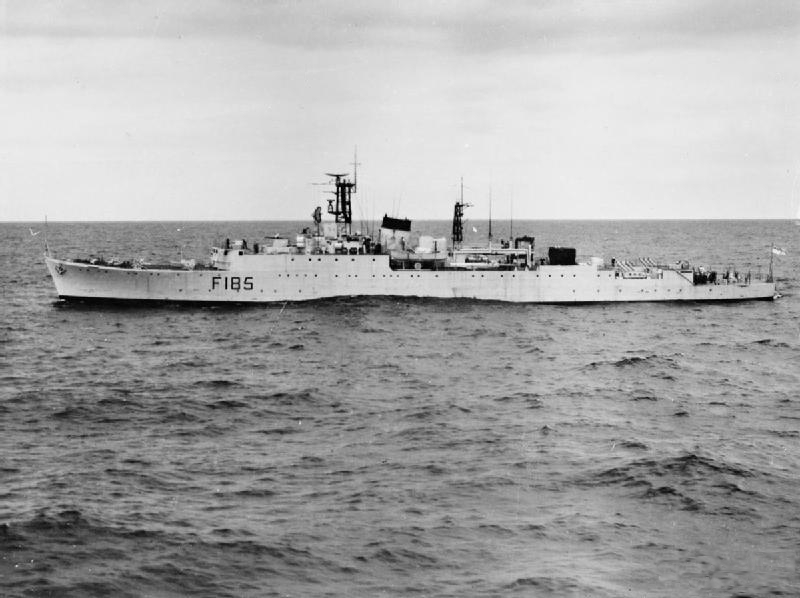
They proved weatherly and robust, and made up numbers of escorts at a time when new struction was coming into service very slowly. Endurance was reduced to 4750nm at 15kts (476t fuel) Rocket and Relentless completed their conversion in 1952 and were followed by the others in 1952-57. Yards known to have been involved are: Portsmnouth DYd 1950-52, Verulam 1952, Troubridge (completed by White, 1955-57); Devonport DYd Rocket 1950 52, Roebuck 1952-53, Ulysses 1952-53, Venus 1953, Wizard 1954; Chatham DYd – Ulster 1952-53, Zest 1954-56; Grenville 1953-54, Virago 1952; Scotts – Wakeful 1952-53; Palmers – Whirlwind 1952-53, Ursa 1952-54; Harland & Wolff, Belfast Wrangler 1951-52; Harland & Wolff, Liverpool – Urania 1953-54; White Volage 1952, Undaunted 1952-54; Barclay Curle – Urchin 1952-54; Stephens Rapid 1952-53; Thornycroft. Vigilant 1952; Yarrow Undine 1954. The main modification was to provide a new enclosed bridge above the ops room and in three of the ships (Troubridge, Ulster, Zest) the 40mm mounting was resited in an embrasure at the forward end of main deck.
HMS Wrangler became the South African Vrystaat on transfer to that navy. In their later years the survivors were used for training and some were disarmed. Grenville, Undaunted and Relentless were fitted with helicopter platforms to test the new concept of using light helicopters to drop homing torpedoes against submarines.
Specifications
Displacement: 2240/2850 tonnes FL
Dimensions: 109.5 x 10.9 x 4.3 m
Powerplant: 2 shaft Parsons Geared Turbines, 2 adm. 3-drum boilers 40,000 hp 36.7 knots range 3,000 nm
Armament: 2x 4.5 in/45 QF Mk16 AA, 2x 40 mm AA, 2x 21-in TTs, 2 Squid Mk4 ASW / Limbo Mk10
Electronics: Radars 278, 262, 293, sonar 170, 174
 Tenacious class Frigates (1952)
Tenacious class Frigates (1952)

Conway’s illustration of the Tenacious conversion, HMS Termagent as converted.
The cost of the Rapid or Type 15 full’ conversion forced the Admiralty to order a Type 16 limited’ conversion. It had the virtue that it could be accomplished quickly because the original destroyer hull was retained, but capability was much lower. The twin 4in gun on ‘B’ position had to rely on a Simple Tachymetric Director (STD) above the bridge, and the main sensor was a single Type 293 surface/air search and target-indication radar at the masthead. To provide a surface capability (of dubious value), one quadruple set of TT was retained, and Orwell and Paladin retained their minelaying rails. Twin Squids and a handing room, as in the ‘C’ class destroyers, were sited on the after superstructure. Tenacious completed her prototype conversion in 1952 and the rest were completed by 1956. Yards known to be involved were: Rosyth DYd – Orwell and Tenacious 1952, Paladin 1956; Harland & Wolff, Belfast Petard 1956; Thornycroft – Terpsichore 1952-53; Mountstuart – Teazer 1952, Tuscan 1953; Grayson Rollo – Termagant 1953, Tumult 1954: Harland & Wolf, Liverpool MP Tyrian 1953. Maximum draught was 16ft 1 in and ehdurance 5225nm at 15kts (588t oil). In the first ships the original destroyer bridge was retained, but Teazer, Terpischore and Tumult were iven a higher and narrow bridge, as in the new Type 12 frigates.
Specifications
Displacement: 1793/2593 tons FL
Dimensions: As Rapid class
Powerplant: As Rapid class but range 1700 nm/20 knots for Orwell, Paladin, Petard
Armament: Same but 3x 40mm/60 Mk9 AA, 1×4 TT 21-in, 2 Squid Mk3.
Electronics: Radar 293, 974, Sonar 170, 174P
 Withby class Frigates (1954)
Withby class Frigates (1954)
Class: Blackpool, Eastbourne, Scarborough, Tenby, Torquay, Withby 1956-58
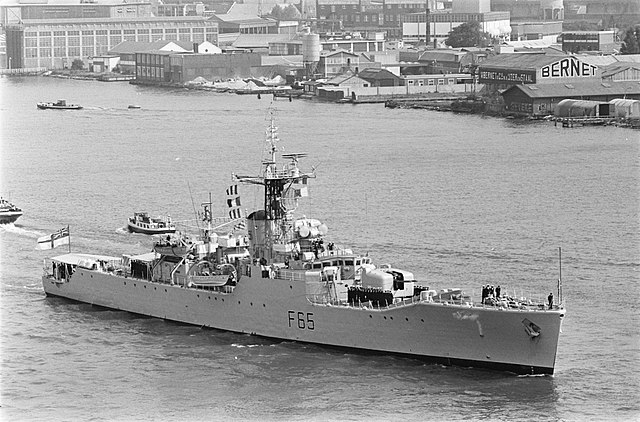
HMS Tenby
The so-called 1945 Sloop studies had envisaged a 25kt ASW version of the standard hull, but the need for a Type 11 frigate very quickly disappeared with the postwar appearance of the fast submarine. If such a design existed it had a short life, for the Staff Requirements raised the sea speed to 27kts, capable of being maintained in a seaway. Out of this emerged the Type 12 design, and the AA and AD, the downgraded, diesel-engined versions of the standard design. The Type 12 hull-form was, and remains, one of the outstanding small warship designs of the century. A sharp ‘V’ form forward permitted the hull to be driven into a head sea without the ‘panting’ and ‘slamming’ which went with traditional destroyers, but amidships the hull widened to a deep square form. This acted against high smooth-water speed, but made for good sustained speed, ideal for pursuit of a submarine in rough weather. To reinforce this the big (12ft diameter) propellers were slow-running, making them quieter and more efficient, and a raised topgallant forecastle kept spray and green water off the bridge.
Range was to be 4500nm at 12kts. The armament was intended to be the twin 3in/70 Mk 6 AA gun, a 40mm STAAG, two ASW Mk 10 triple mortars and no fewer than twelve TT for launching homing torpedoes, eight fixed and two twin training tubes. The Whitbys were prototypes and so went to sea with the existing, somewhat cumbersome 4.5in, although production vessels scheduled to get 3in gun. The 21in Mk 20 (E) torpedo (formerly ‘Bidder”) never became operational. Because of the fine lines the armament and bridgework had to be far aft (this made for greater crew efficiency, but it did mean a crowded upper deck). In the first three ships (Whitby, Torquay and Scarborough) the funnel was a thin ‘stovepipe’ close to the lattice foremast (to resist atomic blast), and as the radar arrays suffered from smoke-corrosion (and to improve the ship’s appearance) Eastbourne was given a thicker, raked funnel with a special domed cap. It was liked, and was subsequently retro-fitted to all three.
The result that all six ships had to be partially replated soon after completion. Only four vessels were fitted with TT and these were removed by the early 1960s. The STAAG was also removed and replaced by a single 40mm Mk 9. Torquay, Eastbourne, Scarborough and Tenby were altered for service in Dartmouth Training Squadron, with a large deckhouse aft for classrooms and offices. None of the class received any further modernisation: Scarborough and Tenby were temporarily transferred to Pakistan, but when the refit cost rose to (10m each the deal was cancelled). Blackpool was on loan to New Zealand from 1966 to 1971. Torquay was used for navigation and direction training, and carried out trials of the first Computer Assisted Action Information System (CAAIS).

HMS Torquay 1957 – Conway’s profile
Specifications
Displacement: 2150/2560 tonnes FL
Dimensions: 112.7 x 12.5 x 3.9 m
Poerplant: 2 shaft geared steam turbines, 2 B&O boilers 30,000 shp, 29 knots Range 4500 nm
Armament: 2x 4.5 in/45 DP Mk 6, 2x 40 mm STAAG Mk2, 2×2, 8×1 TTs 21 in, 2 Limbo Mk10.
Electronics: Radars 275, 262, 293, 277, 974/978 sonar, 162, 170, 174/177
 Blackwood class Frigates (1955)
Blackwood class Frigates (1955)
Class: Blackwood, Duncan, Dundas, Exmouth, Grafton, Hardy, Keppel, Malcolm, Murray, Palliser, Pellew, Russel 1956-58
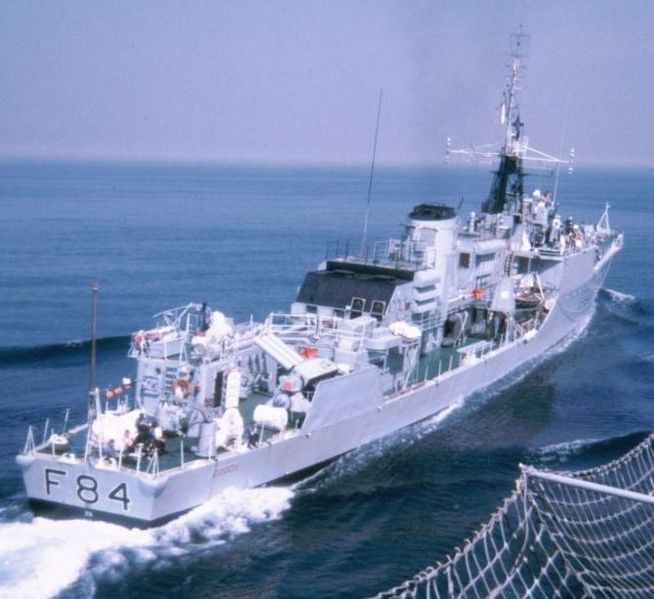
HMS Exmouth 1972
The high unit cost of the Whitby class design – 3.5 million pounds – led the Admiralty to consider cheaper vessels which could also be built more quickly: the result was the Type 14 (there was no Type 13), with the same ASW capacity as the Type 12, but with only half the power and virtually every other capability eliminated. All were ordered in March 1951. The result illustrates vividly the problems of building a 2nd rate frigate, for although the Blackwoods achieved exactly what the Staff Requirement demanded qualities at half the cost of the Whitbys – they were not popular in the Navy. Described as a utility design (as against the ‘quality’ Type 12) they were mocked as ‘futility frigates’, for their single-mission design made them inflexible for peacetime use.
What was ignored was the fact that if hostilities had broken out with the Soviet Union in the late 1950s (as many Western defence planners envisaged) there would have been an extra half dozen Type 14s and ten Type 16s. In ASW exercises the Blackwoods often proved superior to more sophisticated frigates, mainly because their inflexibility permitted them to be left to continue their ASW training to a high level, whereas other fregates frequently had their training programmes interrupted. With only half the machinery of the Whitby class the designers had to go for finer lines and less weight to reach 25kts, and so the short forecastle reappeared.
Strengthened after experiencing exceptionally heavy weather off Iceland they proved very seaworthy, and many gave good service in the Fishery Protection Squadron.
Blackwood, Exmouth, Malcolm and Palliser were completed with two twin 21in TT amidships to supplement the Mk 10 mortars, but the tubes were subsequently removed. After a few years in service the after 40mm gun was removed as well, mainly because it could not be used in heavy weather.
In 1966-68 Exmouth was engined with a Rolls-Royce Olympus gas turbine developing 23,200shp, backed up by two Proteus gas turbines for cruising (8500shp) geared to the same shaft. The ship was then put through an exhaustive series of tests, culminating in the adoption of the Olympus/Tyne combination as the future standard propulsion unit for the Royal Navy. There was no dramatic improvement in speed (maximum speed rose to 28kts, cruising speed of 22kts) because the hull could not absorb any great increase in power. The external configuration was unchanged apart from a new streamlined funnel, and fuel was slightly increased to compensate for higher consumption.

HMS Hardy in 1970 – Conway’s profile
Specifications
Displacement: 1180/1535 tonnes FL
Dimensions: 94.5 x 10.7 x 4.7 m
Powerplant: 1 shaft geared steam turbine, 2 B&W boilers 15,000 shp, 27 knots, range 4500 nm
Armament: 3x 40 mm/60 Mk9, 2 Limbo M10, 4x 21 in TT 21 in.
Electronics: Radars 974, 291, Sonars 174, 170, 162
 Leopard class Frigates (1955)
Leopard class Frigates (1955)
Class: Leopard, Lynx, Puma, Jaguar, Panther 1957-59 (transferred to India 1953)
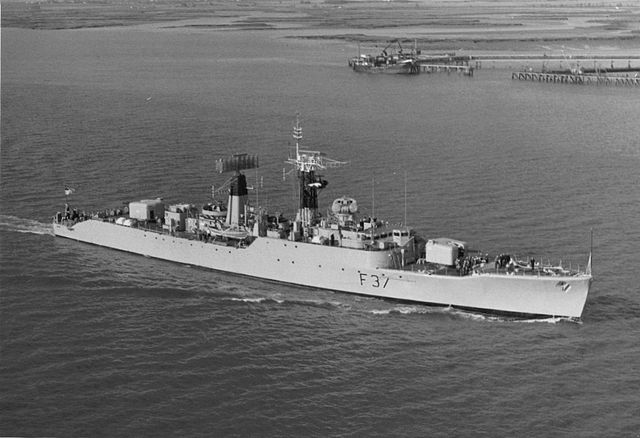
HMS Jaguar (F37)
For the remainder of the 1945 frigates it was decided to adopt diesel propulsion because it was felt that so many steam plants would overstretch the capacity of British industry. The Type 41 AA frigate was intended to support the Type 12, along with its half-sister, the Type 61 AD version, and the first orders were placed in August 1951. The 41/61 in steam form was the basic design and
the 12 was developed from it. The raised forecastle of the Type 12 was adopted in order to enable speed to be kept up in a head sea, but was somewhat shorter and therefore lacking in elegance. Another unattractive feature was the absence of a funnel, for the diesel exhaust-trunking was brought up inside both lattice masts.
This proved unsuccessful as well as unsightly, and to prevent the corrosion of masthead equipment Puma had her mainmast plated. The improvement was retro-fitted to the other ships. By the standards of the day a most elaborate anti-aircraft defence was provided, with a Type 960 long-range air warning radar on the main-mast, a Mk 6M fire control system controlling two twin 4.5in automatic mountings backed up by a CRBF director aft, and a STAAG autonomous close-range 40mm mounting. The STAAG was not reliable, how-ever; Jaguar entered service with a single 40mm gun in its place and the rest followed suit. Jaguar was the first to have the more effective Type 965 (AKE-1) long-range radar, but in time all four received it. A fifth unit, Panther, was sold (before being laid down) to India as Brahmaputra; a replacement was ordered, but subsequently cancelled. In 1978 faguar was transferred to Bangladesh as Ali Haider, followed by Lynx in 1982 (renamed Abu Bakr). Although effective ships when built, the Admiralty Standard Range 1 diesel was not a great success.

Conway’s profile of the Puma as completed
Specifications
Displacement: 2300/2520 tonnes FL
Dimensions: 103.6 x 12.2 x 3.6 m
Powerplant: 2 shaft, 8 ASR1 diesels 14,400 bhp, 25 knots, range 7500/16 kts
Armament: 2×2 4.5 in/45 Mk6 DP, 2x 40mm/60 STAAG Mk2 AA, 1 Squid ASW
Electronics: Radar 275, 960, 262, 974, 992Q later 965 AKE-1, 978, 993. Sonar 170, 174, 162
 Salisbury class Frigates (1952)
Salisbury class Frigates (1952)
Class: Salisbury, Chichester, Llandaff, Lincoln (Cancelled: Coventry, Exter, Gloucester)
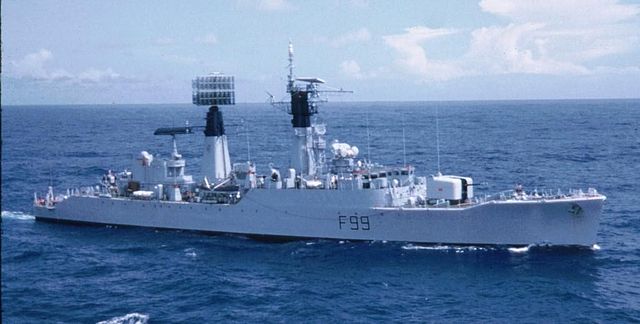
HMS Lincoln 1972
On the same hull as the Type 41, the Type 61 design sacrificed the after 4.5in twin gun in favour of a much more comprehensive air warning radar outfit. The ships were thus a much more valuable addition to the fleet than the Leopard class, for with adequate radar coverage carrier aircraft provided much better defence against air attack than guns. This was recognised quite early, and the Leopard class was stopped at four units whereas the Salisbury class was to have been expanded to eight units. Furthermore, the survivors had recceived a more comprehensive modernisation.
The original STAAG Mk 2 was later replaced by 1-40mm Mk 9, and the fourth ship, Lincoln, was completed later, with a big deckhouse aft to take a GWS20 director and a quadruple Seacat missile launcher (a single 40mm gun was mounted initially). In 1962 Salisbury was refitted with a plated mainmast carrying a ‘single bedstead’ Type 965 antenna. In 1964 Chichester appeared with both masts plated, the mainmast carrying a ‘double bedstead’ Type 965 array and Seacat GWS20; HMS Llandaff was similarly fitted in 1966, followed by Lincoln in 1968 and Salisbury in 1970.
Two more of the class were cancelled under the 1957 Defence Review and another (Coventry) was suspended. It was hoped to order her in 1961, but by then the more flexible Leander design was ready and so she was replaced by Penelope. Llandaff was transferred to Bangladesh as Umar Farooq in December 1978, followed by Lincoln in 1982. Salisbury was sunk as a target on 30 September 1985.

Conway’s profile of the Salisbury as completed.
Specifications
Displacement: 2170/2350 tons FL
Dimensions: As Leopard class
Poerplant: As Leopard class
Armament: 2x 4.5 in/45 Mk6 DP, 2x 40mm/60 STAAG, 1 Squid ASW
Electronics: Radars 275, 277, 960, 982, 293, 974, later 965, 993, 978, Sonars 170, 174, 162
 Tribal class Frigates (1959)
Tribal class Frigates (1959)
Class: Ashanti, Eskimo, Gurkha, Mohawk, Nubian, Tartar, Zulu completed 1961-64
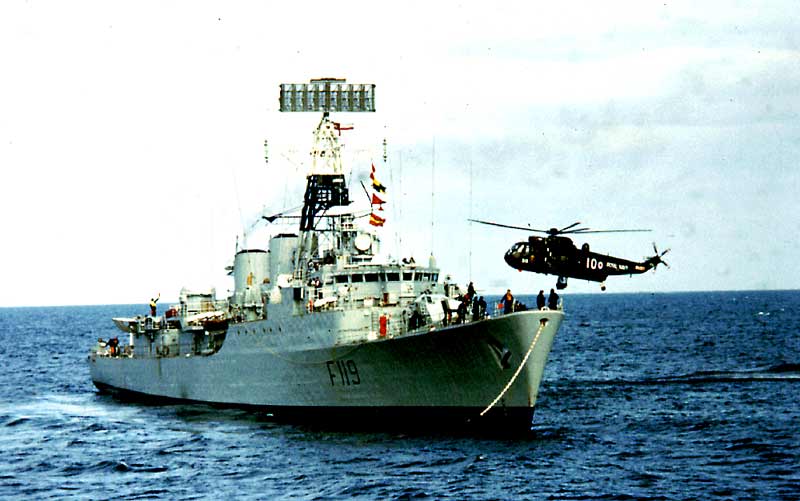
HMS Eskimo Sept. 1975
Inspired by the work already done on the Common Hull Frigate (see Type 42 frigates), the Naval Staff drew up a project known as a Common Purpose Frigate (later called a Sloop) having a second-rate AA, ASW and AD capability; in effect this meant a reversion to general-purpose ships, an admission that the breakdown into single-purpose ships was wrong. The armament was to be two twin 4in Mk 16, a twin 40mm Mk 5, a Limbo Mk 10 mortar and eight ASW TT. The standard sonar and radars were to be provided, but a measure of aircraft-direction was to be provided by a USN SPS-6C long-range radar.
Several changes of armament were proposed: a twin 3in/70 Mk 6 and two Vickers single automatic 4in in turn, but these were rejected to avoid pushing up dimensions. Then it was decided to Anglicise the SPS-6C radar, and until the weight and dimensions of the new Type 965 radar aerial were known the lattice mast could not be designed; allowance was made for an aerial weighing 2 times the manufacturers’ 1956 estimate, and this turned out to be sufficient!
The result was a very light mast which actually weighed less than the array it carried. Less difficulty was encountered with the fire control, for the Type 802 system was cancelled and replaced by the light MRS3, again Anglicised USN equipment, this time based on their Mk 56 director. The designation ‘sloop’ was chosen deliberately because ‘frigate’ denoted a single-mission ship, and
from the unused general purpose 80 series came, the later designation Type 81. Subsequently there was political pressure to show that the RN was capable of increasing its frigate force, and to bow to this whim the worthy designation of sloop was changed to frigate. There was a need to replace the nine ‘Loch’ class vessels in the Persian Gulf, and this became the prime mission for the new design. Several more attempts were made to upgrade the design, mainly to increase speed, but these were The most important innovation was the adoption of COSAG machinery, half that of the Kent class, whose design was proceeding at the same time.
HMS Ashanti was thus in effect the test-bed for the new machinery and the weight saved could be used for a more effective armament. Air warning radar could be accommodated, and as the trials with light helicopters in Type 15 frigates had proved successful it was decided to try to incorporate a hangar for a Fairey Ultra Light helicopter. This hangar was ingenious, the lift forming both the roof of the hangar and the flight deck. When the helicopter (in fact a Wasp) is stowed the hangar is closed by portable roof-sections. The adoption of COSAG machinery necessitated two funnels, the foremost serving the boiler room and the aftermost the gas turbine room. The ships were also unusual in having a tapering flush deck, giving good freeboard forward on a small displacement without sacrificing strength or covered access. On the displacement and cost-limits it was possible to provide only two single hand-loaded semi-automatic 4.5 Mk 5 guns (for shore bombardment) but provision was made for two Seacat (2 x 4) launchers, which replaced the 40mm weapons.
As completed, only HMS Zulu carried Seacat, with the prominent GWS21 version of the CRBF directors on platforms abreast the second funnel; by 1977, however, the remainder had been fitted as well. Some had VDS. Although successful ships, the “Tribals’ fell victim to the RN’s 1979 manpower crisis, and all were paid off from the end of that year, Gurkha being the first to be put on the disposal list; she recommissioned in 1982, however, in the wake of the Falkands Crisis, and some of her sisters were brought back into service for a short while. Three sold to Indonesia: Zulu in May 1985, Gurkha in October 1985, and Tartar in April 1986.

Conway’s profile of the HMS Mohawk as completed
Specifications
Displacement: 2300/2700 tonnes FL
Dimensions: 109.7 x 12.9 x 4 m
Powerplant: 1 shaft COSAG steam turbine, 1 B&W boiler, AEG G6 gas turbine, 12500+7500 hp 27 knots, 4500 nm/12 kts
Armament: 2x 4.5in/45 Mk5, 2x 40mm/60 DP Mk7/2x 20mm, Limbo Mk10 ASW, 1 Helicopter
Electronics: Radars 965, 993, 903, 974/78, Sonars 170, 177, 162/199
 Rothesay class Frigates (1957)
Rothesay class Frigates (1957)
Class: Rothesay, Londonderry, Brighton, Falmouth, Yarmouth, Rhyl, Lowestoft, Berwick, Plymouth, Hastings, +3 cancelled 1960 (Comp. 1960-61)
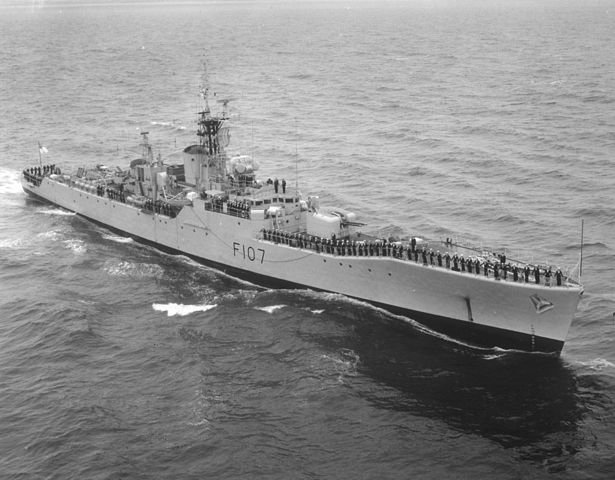
HMS Rothesay (F107)
These were repeats of the Whitby design, ordered under the 1954-55 Programme, but ‘tidied up’ internally. The raked funnel fitted in Torquay was incorporated during construction, but there were few differences. The other external twelve TT were removed and only the early ships carried the STAAG 40mm mounting. In its place was put a large deckhouse to carry a Seacat GWS20 missile system, but for some years all ships carried a single 40mm Bofors gun.
The last three hulls were cancelled and completed to the Leander design, the success of which prompted a major modernisation of the Rothesays. The major improvement was the incorporation of a Wasp light helicopter (Mk 44/46 homing torpedoes), while the opportunity was taken to update the fire control by replacing the Mk 6M with the MRS3 system. The appearance was slightly changed by providing a new plated foremast and raising the funnel, but in other respects the layout remained the same, Armament was now 2-4.5in, one Seacat GWS20 SAM (1 x4), 2-20mm, one Limbo Mk 10.
In 1978 Falmouth carried out trials of the winch gear for the new towed array sonar on the quarterdeck. From November 1975 to October 1979 Londonderry was reconstructed to serve as a trials ship for the Admiralty Surface Weapons Establishment (ASWE). This involved the removal of the 4.5in guns, altering the propulsion system to waterjets for quietness, and stepping a large, plated mizzen-mast to carry the new Type 1030 STIR radar. In the autumn of 1980 she also took the 30mm Naval Rarden gun to sea.
The first Hastings (ordered February 1956) became the Royal New Zealand Navy’s Otago in February 1957; another ship was ordered in her place, but completed as a Leander. The Defence Review spelled the end of the class, although some lasted longer as a result of the Falklands. Lowestoft was fitted with the first Type 2031I towed sonar array in 1981-82. Plymouth was handed over to the Warship Preservation Trust in April 1989 and was towed to the Clyde in June the following year.

Londonderry as built – Conway’s profile
Specifications
Displacement: 2150 (2380 as rebuilt)/2560 (later 2800) tonnes FL
Dimensions: As Whitby class
Powerplant: As Whitby class
Armament: As Whitby class
Electronics: Radars 975, 977, 293(later 903) 994, 978. Sonars 170, 174/177, 162
 Leander class Frigates (1961)
Leander class Frigates (1961)
Class: Leander, Ajax, Dido, Penelope, Aurora, Euryalus, Galatea, Arethusa, Naiad, Phoebe, Cleopatra, Minerva, Sirius, Juno, Argonaut, Danae. Completed 1962-1967

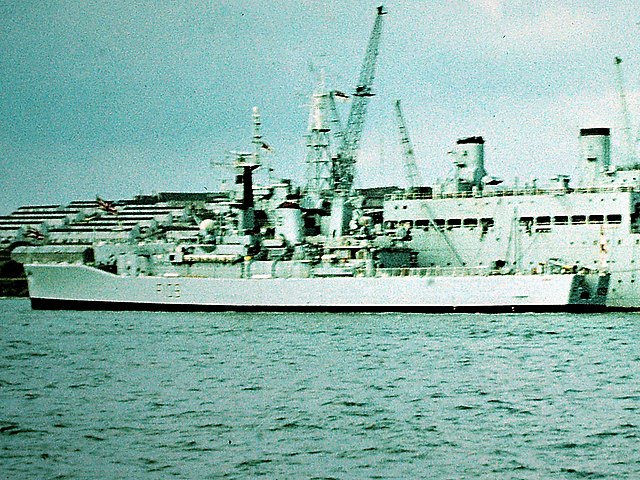
HMS Leander 1977
The advances made in the “Tribal’ class pointed the way to a return to the concept of a general-purpose model instead of the prevailing idea of specialised escorts operating in a group. Work done on a revision of the Type 12 design for New Zealand, incorporating two helicopters and full air-conditioning, provided further impetus to studies by M K Purvis. The design which evolved managed to incorporate the long-range air warning radar and the helicopter of the ‘Tribal’ class, but with the armament, fire control and rough-weather capability of the Whitby/Rothesay design.
The secret was to replace the separate ballast tanks of the Type 12 with well-compensating fuel tanks,Wuch the fuel was displaced by sea water as it was consumed. As many heavy items as possible were moved ower down in the ship, increasing not only the margin of stability, but also the amount of space for the operations room, extra generating capacity and auxiliary machinery. The forecastle deck was extended right aft and a new superstructure deck was built above that, extending from the bridge back to the helicopter hangar.
This transformed the appearance and as it was complemented by a well-balanced funnel the Leander set a new standard of good looks sadly lacking in some previous British designs. Building of the class was expedited by stopping work on the last three Rothesays at an early stage, and a further thirteen ships were laid down under the 1960-64 Programmes. The class are generally considered to be the finest escorts ever built for the Royal Navy and some of the best in the world. To increase the margin for future growth the next group of Leanders ordered was given 2ft more beam (see below). The machinery of the original design was improved, providing a greater degree of automatic control: The first ten had the Y-100 type and the rest Y-111. One of the benefits conferred by having advanced machinery control was the remarkable manoeuvrability and which was such a feature of the Leanders. During the ‘Cold War’ the Leanders proved that they could outmanoeuvre the Icelandic gunboats by changing speed rapidly.
All except Diomede received the Type 199 (VDS). While serving as a training ship Diomede had her 4.5in guns cocooned and the Type 965 radar removed in a variable depth well. In some ships the well remained, but in others it was plated in accommodation. While serving as a training ship Diomede had her 4.5in guns cocooned and the Type 965 radar removed. In 1966 Penelope was disarmed for trials in the Mediterranean. This involved removing her propellers and towing her at the end of a mile-long nylon to provide extra hawser to measure flow noise and hull drag. She was later fitted with the prototype Sea Wolf GWS25 missile system, with the six-cell launcher on the quarterdeck, Types 967/968 radar on the mainmast and a Type 910 tracker on a deckhouse aft.
The equipment was removed in 1979 and she went into dockyard hands for the Exocet conversion. Although no longer bearing any relation to the Whitby design (apart from the hull-form), they are incorrectly referred to as Type 12 frigates. Ikara conversions Eight ships received the Batch 1 conversion, which involved replacing the 4.5in gun mounting with a ‘zareba’ containing an Ikara GWS40 ASW missile system and its magazine and loading gear below. The air warning radar was removed from the mainmast because the ships were intended to operate in mixed escort groups. The Seacat arrangement aft was improved, with the GWS22 director moved to the centreline, leaving room for two quadruple launchers to port and starboard.
HMS Leander was recommissioned in December 1972 and was followed by Ajax (September 1973), Galatea (September 1975), Aurora and Euryalus (March 1976), Arethusa (April 1977) and Dido (October 1978). Displacement was now 2450t normal, 2960t deep load, and complement 257; sensors consisted of radar Types 994, 903 amd 1006 and sonar Types 184, 162 and 170; 2-40mm/60 Mk 9 (2 x 1) and 6-12.75in TT (2 x 3) were fitted and one Wasp helicopter was carried.
Although twelve Ikara conversions were planned the programme was cut short at eight units, for the RN needed to improve its surface-strike capability. The eight Batch 2 ships were given four MM38 Exocet missiles in place of the 4.5in guns, and at the same time the helicopter hangar was enlarged to take the new Lynx, and the new STWS-1 torpedo defence was added; 2-40mm/60 Mk 9 third launcher was positioned on the centreline ahead of the Exocets. Displacement became 2790t normal and 3200t full load, and complement fell (2 x 1) and 6-12.75in TT (2 x 3) are also carried. Unlike the Ikara conversions the Type 965 air warming radar (AKE-1) was retained; other sensors consisted of radar Types 903, 1006 and 994 and sonar Types 184/184M and 162.
HMS Cleopatra was selected as the trials ship for the Type 2031 towed array sonar, and conversion began in 1980. The provision of self-compensating fuel tanks did not prove successful, and as the Exocet missiles made relatively low demands on top-weight it was possible to revert to separate ballast tanks. This eliminated problems with marine growths in fuel tanks and incidentally increased the usable fuel by nearly 50 per cent, providing a much-needed improvement in endurance: the original design called for 4000nm at 15kts, but the effective endurance was nowhere to 223.
Recommissioning Cleopatra November 1975, Sirius April 1977, Phoebe October 1977, Minerva March 1979, Argonaut March 1980, Danae September 1980 and Penelope 22 January 1982. Juno’s Batch 2 conversion was cancelled and she was disarmed as a training ship at Rosyth. Phoebe was again refitted in 1981-82 when the Type 965 radar was removed, the Exocet ramps lowered and Type 2031 towed array sonar fitted. Argonaut was damaged by bombs during the Falklands fighting.
By the end of 1991 only six of the class remained. Juno paid off in 1980; disarmed as training ship and replaced Torquay in 1985. Dido became HMNZS Southland in 1983, Naiad was used for ‘Hulvul’ hull vulnerability trials in 1990 and then sunk as target. Penelope was sold to Ecuador in 1991 and renamed Presidente Eloy Elfaro. Many were sunk as targets for a new generation of weapons.
Apart from the four Exocets forward, the appearance was close to the original profile than the Batch 1 ships, The Seacat arrangements on the after superstructure were altered to a centreline director and two launchers port and starboard.
Specifications
Displacement: 2350/2860 tonnes FL
Dimensions: 113.4 x 12.5 x 5.5 m
Poerplant: 2 shaft geared turbines,2 B&W boilers 30,000 hp, 28 knots, Range 4000 nm/15 kts
Armament: 2x 4.5 in/45 DP Mk6, 2x 40 mm/60 Mk9/Seacat GW22 SAM, 2×20 mm, 1 Limbo ASW, 1 Helicopter
Electronics: Radar 965, 992Q, 903, 974/978, Sonars 162, 184, 199
 Leander “broad Beam” class Frigates (1967)
Leander “broad Beam” class Frigates (1967)
Class: HMS Hermione, Andromeda, jupiter, Bacchante, Charybdis, Diomede, Achilles, Apollo, Ariadne.
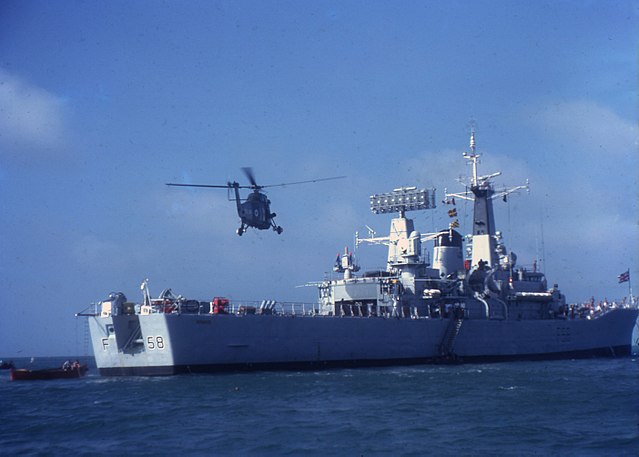
To provide more fuel stowage and a better margin for future growth, the last ten of the Leander class were ‘kippered’ by adding 2ft to the beam. This reduced speed slightly, but improved stability and endurance, both ems of greater fighting value. Although referred to in the RN as Type broad-beam Leanders’ they fomed a separate class, with improved machinery, enhanced by the radical reconstruction from 1977. The steady improvement in machinery stated in the original class continued, and these ships had the Y-136 plant. Speed dropped by half a knot because of increased displacement, but the improved degree of automation made for more machinery.
As built the ten ships were identical with the Leander class in equipment, but the extra internal volume meant difference in that they could be reconstructed to carry two important new systems: the long-range Type 2016 sonar and the Seawolf GWS25 Mod 0 missile sysem, capable of destroying sea-skimming missiles as well as supersonic aircraft. The two systems were inter-dependent because the Type 2016 was intended for detecting fast submarines in the GIUK Gap, far from the support of shore-based aircraft. The most likely opposition to * encountered is surface attack, against which Exocet missiles provided a long-range defence, and missile attack, either from bombers or submarines. The Sea Wolf systme was intended particularly to counter the ‘pop-up’ missile fired from Soviet ‘Charlie’ and ‘Papa’ class subs.
Other sensors included radar Types 967, 968, 910, 294 and 1066 and sonar Type 162M. A Lynx helicopter armed with Sea Skua ASMS or ASW torpedoes is carried. The conversion was a tight fit, and it involved virtually gutting the ship internally and resiting bulkheads. Every spare ton of topweight had to be reduced, by such expedients as cutting off the funnel-top and putting the 6-12.75in TT (2 x 3) a deck lower. The 6-cell Sea Wolf launcher SSMS was mounted forward of the bridge, with a heavy movable blast-shield to protect the four Exocet MM38. A single director was rather lighter than the original in the Broadsword class, is mounted over the bridge, with the back-to-back Type 967 and Type 968 surveillance radars at the masthead. As in the Exocet conversions the Limbo mortar was removed to allow for a larger flight deck and hangar. The generating capacity had to be increased over the 200kW in the Batch 2 Leanders, for five computers are required to handle and the rest followed in 1982-84.
Andromeda was the lead-ship, having gone into Devonport in late 1977; she completed in December 1980, and the rest followed in 1982-84. Following the 1981 defence cuts, the programme was reduced, leaving the remaining ships unconverted. Bacchante transferred to New Zealand in 1982; Apollo and Diomede went to Pakistan in 1988; Achilles went to Chile in 1990 and was followed by Ariadne in 1992; Danae went to Ecuador in 1991; was the first of the modernised ships to go for disposal in October 1991, and the others went in 1992-93.
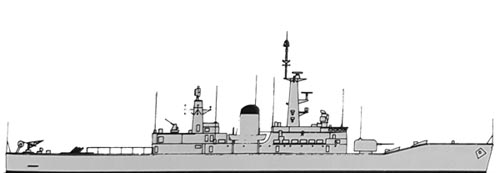
HMS Euryalus
Specifications
Displacement: 2500-2790/2962-3300 tonnes FL
Dimensions: Same as Leander but witdth 13.5 m
Powerplant: Same as Leander
Armament: Same as Leander
Electronics: Same as Leander
 HMS Mermaid Frigate (1966)
HMS Mermaid Frigate (1966)

HMS Mermaid as completed
Ordered by Ghana to serve as flagship and presidential yacht for President Nkrumah, but cancelled when a coup toppled him from power. She was launched without being named and completed fitting out in 1968, but without armament. Negotiations to sell her abroad failed and after being laid up at Scotstoun she was bought by the RN in April 1972 for conversion to a training ship; refitting started at Chatham in October that year. The design was based on the Type 41 or Leopard class, but without the raised forecastle and with a flush forecastle deck and a funnel. Although successful in RN service, she was an odd number in the inventory and was sold to Malaysia in May 1977 as Hang Tuah, replacing the previous ship of that name.
Specifications
Displacement: 2300/2520 tonnes FL
Dimensions: 103.4 x 12.2 x 3.7 m
Powerplant: 2 shafts 8 adm. standard range diesels, 14400 bhp, 24 knots, range 4800 nm
Armament: 2x 4in/45 Mk 16 AA, 4×40 mm/60 Mk9, Limbo Mk10
Electronics: ASW radar 978, sonars 174, 170B
 Amazon class Frigates (1971)
Amazon class Frigates (1971)
Class: Amazon, Antelope, Active, Ambuscade, Arrow, Alacrity, Ardent, Avenger.
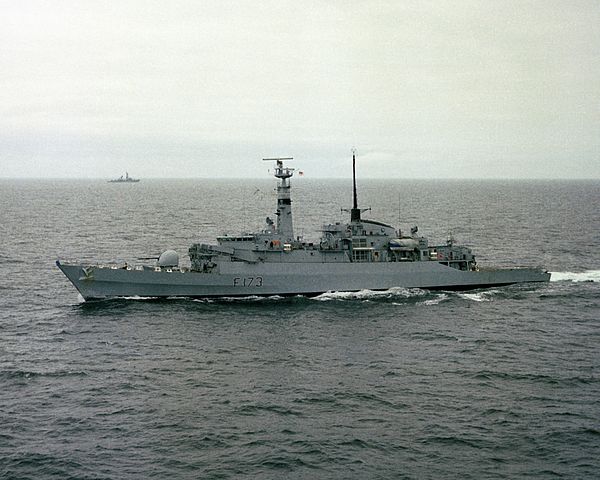
HMS Arrow F173, underway circa 1982. This class was tested in the Falkland war.
The Type 21 design had its origin in the need to replace the diesel-engined frigates of the Leopard and Salisbury classes. At the same time private shipbuilders were lobbying for a chance to build a frigate for the RN without what they claimed to be excessively high standards imposed by the MoD’s Ship Department at Bath. It was claimed that such a frigate would not only be cheaper (L3.5m as against £5m for a Leander at contemporary prices), but also a good export item. The Controller of the Navy backed this claim wholeheartedly, even to the point of trying to cut the Ship Department out of the design process.
The result was a wasted opportunity to bring private and official designers together. Details of the design did not meet certain naval requirements, the cost was f14.4m for the first ship, and the vessels lacked sufficient ‘stretch’ to take the next generation of weapons (specifically the Type 2016 sonar, a long-range radar and the Sea Wolf missile). They were popular with the RN, however, particularly because of their comfortable officers’ accommodation (in contrast, the ratings’ accommodation was below the standard in contemporary RN ships) and because they handled easily.
From Active onwards, four MM38 Exocet SSMS were fitted in ‘B’ position, toed inwards to allow the blast to vent outboard to port and starboard. The triple STWS-1 close-range torpedo defence was also fitted after completion. The fire control system was a new departure: as no suitable British light system existed, the RN bought the Italian Selenia RTN-10X radar tracker and combined it with the British Ferranti WSA-4 below-decks equipment, providing control for both the 4.5in gun and the Seacat GWS24. Although there was talk of the design allowing the replacement of Seacat by Sea Wolf this was never possible because the ships were delivered overweight and did not have the margin of stability necessary for such a big system. A Lynx helicopter armed with lightweight torpedoes was carried. The Royal Australian Navy contributed a large sum (believed to be about 35 per cent) to the design costs, with the intention of building five ships in Australian yards; this project never came to fruition however, and although Argentina showed some interest, no export orders were ever won for this design. In 1980 it was confirmed that the class would not receive a modernisation but all survivors were stiffened post-1982.
In 1977 in the Far East Amazon suffered a bad fire, and this drew attention to the risk of building warships with all-aluminium superstructures, a risk underlined by the Falklands conflict. The designers maintained that they could not have met the requirement to raise the weapon load without saving as much topweight as possible. To this their critics replied that the flimsiness of aluminium accentuates the vulnerability of modern warships to relatively minor damage. Whatever the merits of the argument, after the construction of the Amazon class the British Naval Staff changed their minds about aluminium, and stipulated that future ships use steel only. During the Falklands conflict Ardent was badly damaged by air-launched unguided rockets on 21 May 1982 and sank shortly afterwards; Antelope was hit by bombs on 23 May, and blew up on the following day while an explosives expert was trying to defuze an unexploded bomb. The six remaining were sold to Pakistan in 1993-94.

Profile of the Amazon class
Displacement: 2300/2520 tonnes FL
Dimensions: 103.4 x 12.2 x 3.7 m
Powerplant: 2 shafts 8 adm. standard range diesels, 14400 bhp, 24 knots, range 4800 nm
Armament: 2x 4in/45 Mk 16 AA, 4×40 mm/60 Mk9, Limbo Mk10
Electronics: ASW radar 978, sonars 174, 170B
 Broadsword class Type 22 Frigates (1976)
Broadsword class Type 22 Frigates (1976)
Class: HMS Broadsword, Battleaxe, Brillant, Brazen
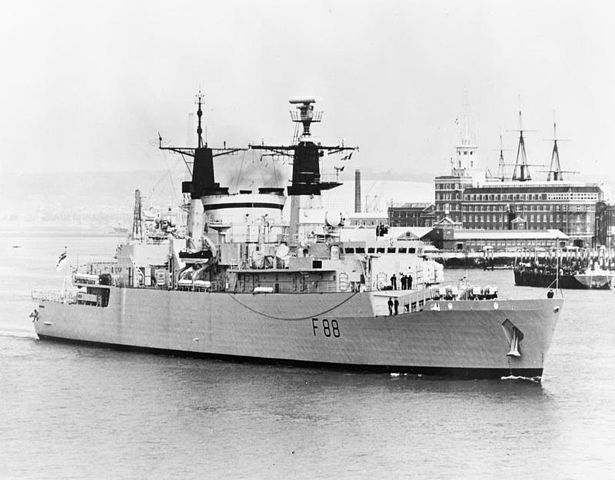
HMS Broadsword, Portsmouth Harbour, 1982 (IWM)
Originally conceived as a follow-on to the Leander class and intended to be built for the Royal Netherlands Navy as well, the Type 22 design was forced to grow to meet new threats and to accommodate new technology. The increasing inability of medium-range active sonars to cope with fast nuclear submarines led to the development of a new ‘fleet’ sonar, capable of long-range passive derection and use of convergence zones and ‘bottom-bounce’ techniques. The threat from SS-N-7 ‘pop-up’ missiles dictated the development of Sea Wolf anti-missile system, and finally the creation of the SOSUS barriers of underwater listening arrays in the GIUK Gap required a ship with a high degree of autonomy and good seakeeping.
As a result the Broadsword hull had much more freeboard than the Sheffield class DDG, a double hangar to accommodate a second Lynx (a late addition), a double-headed Sea wolf system, and a main armament restricted to four MM38 Exocet SSM. The hull was in fact an expansion of the original Type 12 design, intended to be driven in rough weather with little reduction in speed. The processing equipment needed for all this required seven computers, but there was another reason for the spaciousness: Experience has shown that maintenance is the biggest headache in a warship, and that the ‘payload’ has to be updated once or even twice in the lifetime of the ‘platform’ or hull.
Thus the Broadsword design left additional space for future growth, in much the same way as the American Spruance design. Although rated as frigates they were bigger than the DDGs, and proved magnificent ASW ships. The first two ships were not originally fitted with TTs. They were to be fitted with the Type 2031Z towed array, but the weight of the winch would have strained the hull girder. The enormous number of inputs from towed arrays also showed that the original Type 22 AIO was not big enough for the task. Large as these ships were, a second ‘stretched’ batch was ordered. For the first time the lead yard received all subsequent orders, as it is now recognised that this saves a considerable amount of time and money.
HMS Broadsword was damaged during the Falklands conflict, but both she and her sister Brilliant performed very well, the latter being the first to use Sea Wolf operationally when she shot down two Skyhawks on 12 May 1982, she was also the first ship to use Sea Skua in anger. In 1988-89 both Broadsword and Battleaxe were refitted by DML, with new funnels similar to their later sisters and additional accommodation for training. In 1991 it was suggested that these fine ships might be offered for sale, and in November 1994 all four were bought by Brazil.

Battleaxe as completed
Displacement: 4000/4400 tonnes FL
Dimensions: 131.2 x 14.8 x 6.1 m
Powerplant: 2 shafts CODOG, RR Olympus TM3B 54,300 bhp +2 RR Tyne RMIC GT 9700 bhp 18 knots, range 4500 nm
Armament: 4 MM38 Exocet, 2x Sea Wolf GWS25 SAM, 2×30/40 mm AA, 6x 324mm ASW TTs, 2 WG13 Lynx Helicopters
Electronics: Radar 967, 968, 910, 1006 sonars 2016/2050, 162, 165
 Boxer class Type 21 Frigates (1981)
Boxer class Type 21 Frigates (1981)
Class: HMS Boxer, Beaver, Brave, London, Sheffield, Coventry
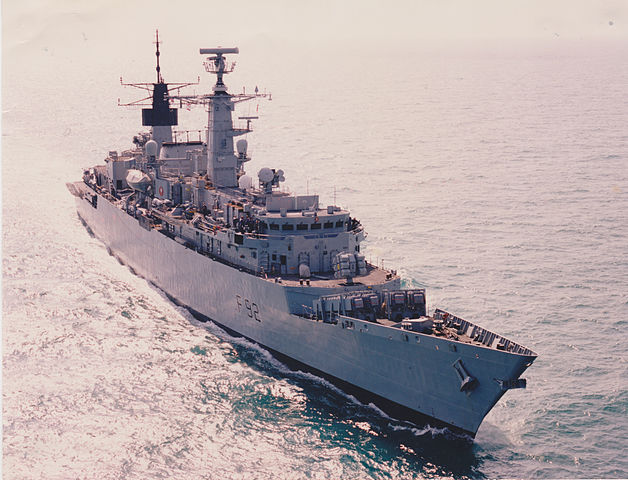
HMS Boxer in July 1999
Although an initial order of twelve Broadswords was talked of, after four units had been ordered the decision was made to lengthen the subsequent ships in order to accommodate the Type 2031Z towed array sonar. Orders for the first two of these improved Broadswords were placed in April 1979, and it was planned to build up to twenty-two units, but once again the design was revised in
the light of Falklands experience, and the class only ran to ten units. The major design changes in these Batch 2 ships included an expanded Operations Room and AIO to handle Type 2031Z data, the CACS-1 combat system in place of CAAIS, and moving the Type 2016/2050 sonar from its hull position to the bow (hence the marked overhang and the stem anchor).
From Brave onwards the flight deck was enlarged to accommodate a single Sea King or the new EH.101 Merlin helicopter, and the stern was redesigned with a square transom. Boxer and Beaver were trials ships for the CACS-1 command system and Brave had Marine Spey SM1A gas turbines in place of Olympus TM3BS. In 1990-91 she was given the uprated SM1C version, developing more power. Bloodhound was renamed London at the request of the Lord Mayor of London, and the last pair were named in honour of the destroyers lost in 1982.

Conway’s profile of the HMS Coventry in 1989
Displacement: 4100/4800 tonnes FL
Dimensions: 148.1 x 14.8 x 6.4 m
Powerplant: 2 shafts CODOG, RR Olympus TM3B 54,300 bhp 28.5 kts +2 RR Tyne RMIC GT 9700 bhp 18 knots, range 4500 nm
Armament: Only change GWS25 Mod3 SAM, 2 WG13 Lynx Helicopters/ single Sea King
Electronics: Radar 967M, 968, 911, 1006 sonars 2050, 2031Z, 162, 165
 Cornwall class Type 23 Frigates (1985)
Cornwall class Type 23 Frigates (1985)
Class: HMS Cornwall, Cumberland, Campbeltown, Chatham
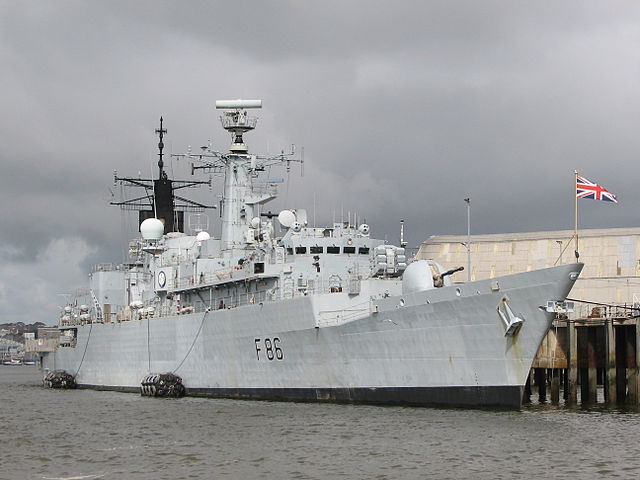
HMS Campbeltown at Devonport
Four more Type 22s were announced at the end of 1982, to replace Falklands losses, but they were redesigned to form Batch 3, with improved command facilities (including flag accommodation), new SSMS, a 4. 5in gun and a close-in weapon system (CIWS). The hull of the Batch 2 design was retained, but armament was rearranged to provide space for the medium-calibre gun. The eight RGM-84C Harpoon missiles were positioned athwartships behind the wheelhouse, with the 30mm Goalkeeper CIWS one deck up. They were also the first frigates to be completed with the new single 30mm Mk 1 in place of the elderly 40mm Bofors.
To mark the numerous differences and enhanced capability the ‘B’ series names gave way to a ‘C’ series. They have the CACS-5 command system (a version of CACS-1) and the gun is controlled by two GSA 8A Sea Archer electro-optical directors (port and starboard above the wheelhouse).
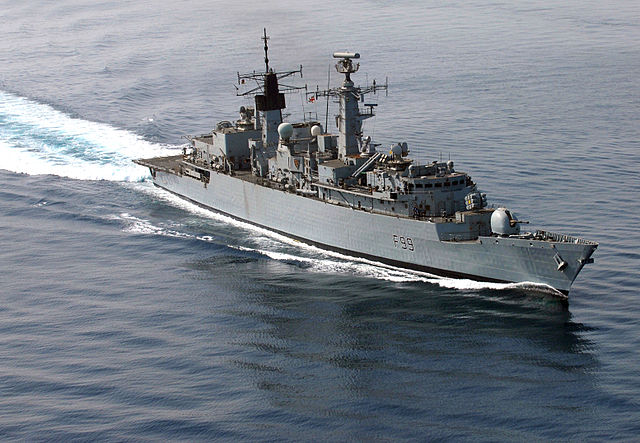
HMS Cornwall in the Persian Gulf, 2007

HMS Cornwall as completed
Displacement: 4100/4800 tonnes FL
Dimensions: 148.1 x 14.8 x 6.4 m
Powerplant: 2 shafts CODOG, RR Olympus TM3B 54,300 bhp 28.5 kts +2 RR Tyne RMIC GT 9700 bhp 18 knots, range 4500 nm
Armament: Only change GWS25 Mod3 SAM, 2 WG13 Lynx Helicopters/ single Sea King
Electronics: Radar 967M, 968, 911, 1006 sonars 2050, 2031Z, 162, 165
 Duke class Type 26 Frigates (1987)
Duke class Type 26 Frigates (1987)
Class: HMS Norfolk, Argyll (Launched 1987-89). Post 1990: HMS Lancaster, Marlborough, Iron Duke, Monmouth, Montrose, Westminster, Northumberland, Richmond, Somerset, Grafton, Sutherland, Kent, Portland, St Albans + Three more for Chile.
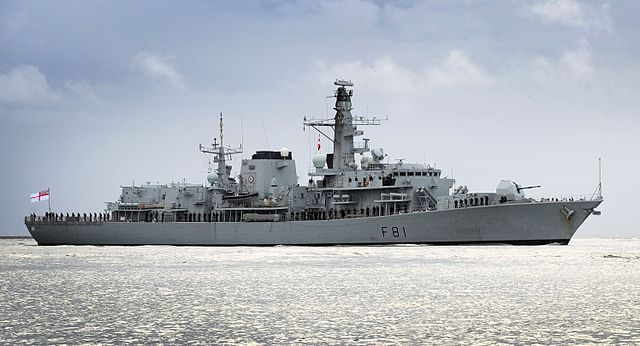
HMS Sutherland 2012
Although the Type 22 is recognised as a highly efficient ASW platform, alarm at its high cost led to a call for a cheaper frigate, relying on the Type 2031Z towed array sonar rather than
the big Type 2050 and Lynx helicopters. Out of this has emerged the Type 23, expanded to include a bow-mounted sonar, a large ASW helicopter and more general-purpose qualities. Although Falklands experience resulted in improved fire precautions and damage control, the decision to incorporate a double-headed Sea Wolf SAM system predated that conflict. By the time the design was finalised BAe’s vertically launched version was nearly ready for trials, and it was selected in place of the earlier lightweight version of GWS25.
The design is optimised for towed array operations, so silencing of machinery was a top priority. Finally a unique combined diesel electric and gas turbine (CODLAG) was chosen, using Spey gas turbines for main drive, and switching to a diesel-electric drive for slow but silent running when using the towed array. The advantage of CODLAG is the elimination of gearbox noise, and the generators are positioned above the waterline to reduce radiated noise. The opportunity was taken to incorporate ‘stealth’ features to enhance survivability in surface warfare. This takes the form of a flared hull and the elimination of right angles and radar-reflecting corners in the superstructure, etc. It is claimed that the Type 23 is ‘invisible’ to the seekers of the current range of antiship missiles, and it also claimed to be the quietest ASW ship in the world.
In all sixteen ships are planned. From the Richmond onwards SM1C Spey gas turbines replaced the SM1A. The first ships went to sea without their planned CACS-4 command system but its successor, the DNA (1) system, is being retrofitted from 1995 onwards. The first six ships ships have Racal’s UAF-1 ESM system, but later ships will have the Thorn EMI (now Racal) UAT equipment (earlier ships will have this system retrofitted; all will have 675(2) ECM).
Replacemement for 1980s generation Frigates is the Type 26 frigate or “town” class. HMS Glasgow was laid down on 20 July 2017, and Cardiff on 14 August 2019. Completion of the sister-ships Belfast is awaited to BAE Systems, Glasgow. Are also Announced a second batch for 2024-25 called Birmingham, Sheffield, Newcastle, Edinburgh and London, while a third Australian batch has been order as of 30 June 2018. Next in development is the Type 31 Frigates (unnamed), General Purpose Frigate (GPFF), to replaced the Type 23 Frigates for a service date in 2023, and strongly geared for export.

Conway’s profile – Duke class Frigates
Displacement: 3500/4200 tonnes FL
Dimensions: 133 x 16.1 x 7.3 m
Powerplant: 2 shafts CODLAG, RR SMI1A/Spey GT 37,540 bhp 28 kts +2 GEC 1.5MW EMs, Paxman Valenta 12 RPA generators, 7000 bhp 15 knots, range 8500 nm
Armament: 8 RGM-84C Harpoon SSM, 32 GWS26 mod 1 VL Seawolf SAM, 1x 4.5in/55 Mk8, 2x30mm Mk1, 4x 324mm TTs, EH101 Helicopter
Electronics: Radar 996(1), 911, 1007, sonars 2050, 2031Z
 Explorer class submarines (1954)
Explorer class submarines (1954)
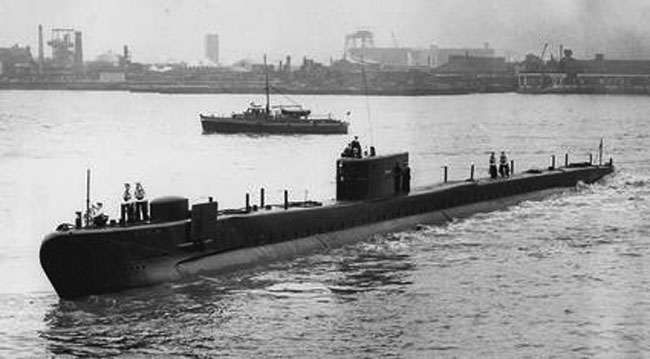
HMS Explorer, Excalibur
The two Explorer-class submarines were prototype submarines ordered by the Royal Navy to test a new propulsion system with highly concentrated hydrogen peroxide (HTP) plus diesel fuel in closed loop. This sytem, inspired by German experimental tech of WW2 allowed high underwater endurance and speed. The Walter cycle, of which details were retreived during Operation Clip. In addition, U-1407, scuttled in May 1945, has been salvaged by the British and was pressed into Royal Navy service as HMS Meteorite for testing purposes.
This formed the ground for the construction of two more closed cycle propelled experimental submarines, the Explorer-class. They used steam turbines, the steam being used for a catalysed interaction of HTP and diesel oil. The Porpoise-class hull was reused, but a retractable superstructure fin and fittings was added to more streamlining underwater and helping achieving the best possible speed. Unarmed, there was no radar fitted either, but a simple vision periscope. There were also backup diesel engines, notably to recharge batteries and surface cruis, separated from standard underwater populsion.
HMS Excalibur was commissioned first, in March 1958, and on trials reached 49 km/h (26.5 kn) for 3 hours, or 22 km/h (12 knots) for 15 hours, on just one turbine. Hydrogen peroxide was used to hair bleach, so both submarines were affactuously nicknamed the “Blonde class”. Royal Navy used them also as fast moving underwater targets but concluded after years of testing that HTP was not a solution for the future. There were several explosions, sometimes fatal, resulting in HMS Explorer being renamed “HMS Exploder” while the other was infamously known “HMS Excruciater”.
HTP for torpedoes meanwhile led to the loss of HMS Sidon, so when the United States started their developement of a nuclear reactor for submarines, UK started negociations for a technological cooporation, being a nuclear power herself. The HTP project was scrapped altogether, and it was judged not practical or rconomical to reconvert both as diesel submarines. Both were sold for BU to Thos. W. Ward. This was ot the end for AIP propulsion however, this story is still ongoing and could well be the next standard for non-nuclear subs around the world, but with less dangerous technogies.
Displacement: 780 tons surfaced/ 1,000 tons submerged
Dimensions: 54 x 4.78 x 3.4 m (178 x 16 x 11 ft)
Propulsion: 2 shafts HTP steam raising plant, turbines, Diesel-electric
Top speed: 46 km/h (25 kn) (submerged)
Crew: 49

 Stickleback-class midget submersibles (1954)
Stickleback-class midget submersibles (1954)
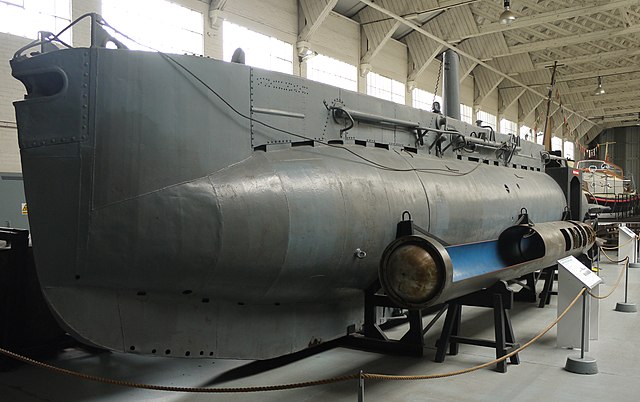
X51 Stickleback, X52 Shrimp, X53 Sprat, X54 Minnow
The Stickleback class were midget submarines which superficiously looked like the X1 serie from WW2, which targeted KMS Tirpitz and Japanese ships at anchor with mixed success. The Royal Navy ordered improved XE-class in fact in 1951, designed to allow training ASW units against such midget submarines, and tests. However declassifed informations in the 1990s alleged that their story was much more complicated and whorty of a long article.
It was indeed believed and very popular at the time, that the Soviet Union were developing such crafts, something that was debunked in 1953. So the initial replacement design was further revised in 1954 and the new X51 serie were supposed to carry a 15-kiloton nuclear mine based on the “Red Beard” and codenamed “Cudgel”. It was supposed to be deployed into strategic Soviet harbours, snearking in, for example, Murmansk or Kronstadt.
This mine was developed from the Mk.I “blue danube” 10,000 Ibs, 20-kt yeld nuclear bom for the RAF. The 1955 “Red Beard” was a derivaive for the Navy, and a 2000 Ib “only” bomb laid down to around 300 ft or 90 m, one carried by each sub, and the primer setup up to 12h after being laid, but the timer could even be setup for a full week before detonation. So even if the sub was spotted and sunk in between, there was little to change to discover the underwater mine.
The blast effect was supposed to create a wave high enough to crush every ship in ints path and submerge the port installation, then causing intense radiation poisoting of the site. But the nuclear part of the project was precisely its ondoing, due to the ratity of the fissile material, as well as reccuring financial problems. So much so, that cancellation intervened in either late 1955 or mid-1956;
Completed in 1955 without purposes, the four subs had different fates: X51 was resold to the Swedish navy as Spiggen, X53 was lent to the USN to test its own harbour defences, returned in 1965 and BU. The two others were probebly used for more tests, mothballed and eventually stricken in 1966. Spiggen was discarded in 1977 and returned, and by that point it was decided to preserve her. She is now in Duxford.
Displacement: 35.2/39.27 tons surf/submerged
Dimensions: 15.44/16.41 m x 1.8 x 2.29 m (53 x 6 x 7ft 10-in )
Propulsion: 1 shaft Perkins P6 6 cyl diesel, 1 electric motor, 50 bhp/44 shp
Speed: 6.5/6 kts surfaced/submerged
Crew: 5, armament: 2 detachable 2-ton side charges
 A class patrol submersibles (converted 1955)
A class patrol submersibles (converted 1955)
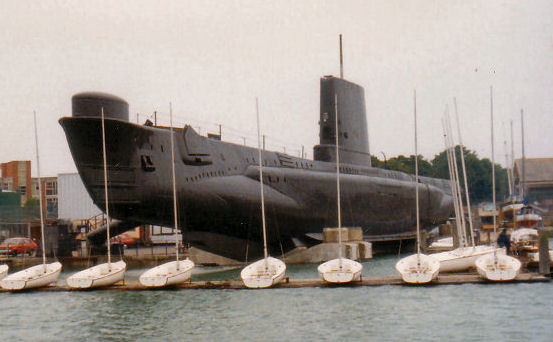
Acheron, Aeneas, Alaric, Alcide, Alderey, Alliance, Ambush, Amphion, Anchorite, Andrew, Artemis, Artful, Astute, Auriga.
There were three series of converted WW2 submarines, worth a full article each. The interim solution that led the germans to devise the Type XXI also conducted many nations to do the same in the early cold war. The USN had their GUPPY series, and the British the “T” and “A” fleet snorkels. The first onverted were the eight T class which received extra batteries and a modernize powerplant as well as new periscope, searc and navigation radarn more modern torpedoes and a streamlined fin. They were called “T conversion” and served until the 1970s or even 1980s with Israel, seeing combat action in the middle east.
Next were five other boats of the WW2 T class converted as “T streamline” with the same modifications essentially and more work put into streamilining the hull and fin, plus upgraded electronics and torpedoes. They had generally better performances and served until 1965-70. Yet in 1944 another class of oceanic submarines tailored for the Pacific were built and most were either to the point of being launched ot completed when the war ended, so the whole serie of fourteen 1400 tonnes boats of the “A” class were planned for modernization after completion and years of service.
Plan for modenrization were made in 1954 and HMS Artful (S96, the last, completed 1948) was taken in hands in 1955 for a conversion and streamiling. Conversion was completed in late 1956 and she re-entered service for extensive trials and testings. She became the prototype for further conversions, and after being validated in 1959, the other thirteen boats were taken in hands for conversion in 1960-61. This only marginally prolongated their useful service as they were retired from 1970 onwards. Technnology had progressed enormously in between, notably the launching of the first British SSNs. The last to be retired was HMS Alliance (S 67) in 1977, and it was chosen to preserve her. She is now on display at Gosport, but formerly as HMS Dolphin.
Design wise, they had the same recipe as previous boats, with twice the battery capacity, and more modern cells, reshaped hull with reworked bow and stern, streamlined fin, new persicope, search and navigation radar, sonar 186, 187 and 197 (the bulbous appendage on the bow). They retained however their old diesels. They used the Mk.32 torpedoes. One boat, HMS Aeneas was provided to Vickers for missile tests, the TV-guided SLAM, derived from the blowpipe missile, mounted in the fin and controlled from below to provide an anti-helicopter defence. But tests failed and the program was cancelled, the boat returned to the RN aand scrapped.

Displacement: 1,385/1,620 tons surf/submerged
Dimensions 280.5 x 22.3 x 16.8 ft (85.5 x 6.8 x 5.1 m)
Top Speed 18.5/8 kts surfaced/sub
Range: 10,500 nm/11 kts, 16 nm/8 kts surf/sub
Test depth: 500 feet (150 m)
Crew: 61
Armament: 6 × 21 inch (533 mm) bow TTs, 4 stern, 16 torpedoes/26 mines, see notes.
 Porpoise class patrol submarines (1956)
Porpoise class patrol submarines (1956)
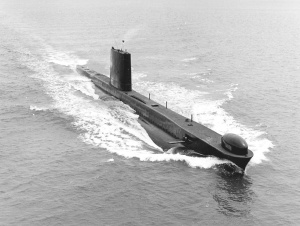
Porpoise, Rorqual, Narwhal, Grampus, Finwhale, Cachalot, Sealion, Walrus
The modernization of the British wartime submarine fleet along the line of the German Type XXI submarines was accompanied by the construction of new boats altogether. The Porpoise class was such class, or eight diesel-electric submarines originally designated as patrol submarines, built 1956-59. Later they were reclassed as conventional attack subs. Their design ws a synthesis of this new generation, mirrored by the Soviet Whiskey class. Their core conception was excellent, and they met immediate inheritance with the Oberons, largely exported British submarines. They were exceptionally quiet underwater, more than their NATO counterparts, used until 1988 for covert operations. They carried 30 Mark 8, replaced by the Mark 23 torpedoes, and eventually the Mark 24 Tigerfish.
Displacement: 2,080 tons surfaced, 2,450 tons submerged
Dimensions 290 x 26 ft 7 in x 18 ft (88 x 8.1 x 5.5 m)
Propulsion: 2 Admiralty diesel generators 1,650 hp + 2 Electric motors, 12,000 hp
Speed: 12 kn surfaced/17 kn submerged
Range: 9,000 nmi (17,000 km; 10,000 mi)/12 knots
Complement: 71
Armament: 8 × 21 in TTs, 6 bow, 2 stern, 30 torpedoes Mk8
 Oberon class patrol submarines (1959)
Oberon class patrol submarines (1959)

27 boats, also for RAN, RCN, Chile, Brazil
The Oberon class comprised 27 submarines designed as follow-on from the Porpoise class with stronger construction, updated equipment and electronics, built 1957-1978 in four shipyards: Cammell Laird, Chatham Dockyard, Scotts Shipbuilding and Vickers-Armstrongs, 13 operated by the Royal Navy, 6 by the Royal Australian Navy, 3 by the Brazilian Navy, 3 by the Royal Canadian Navy, 2 by the Chilean Navy, staying active until the late 1980s and even ealty 1990s for some. They were tasked of surveillance, tracking, operating special forces or used as targets for ASW training. The last were discarded in the 2000s and byf 2015, eight were preserved as museums, others partially preserved, one under private ownership.
Displacement: 2,080 tons surfaced, 2,410 tons submerged
Dimensions 295 x 26.5 x 18 ft (90 x 8.1 x 5.5 m)
Propulsion: 2 diesel and generators, 2 Electric motors, 1840+12,000 hp
Speed: 12 kn surfaced/17 kn submerged
Range: 10,350 nmi (19,170 km; 11,910 mi)/12 knots
Complement: 7+62
Armament: 8 × 21 in TTs (6 bow, 2 stern) 20 torpedoes Mk23
 HMS Dreadnought SSN (1960)
HMS Dreadnought SSN (1960)
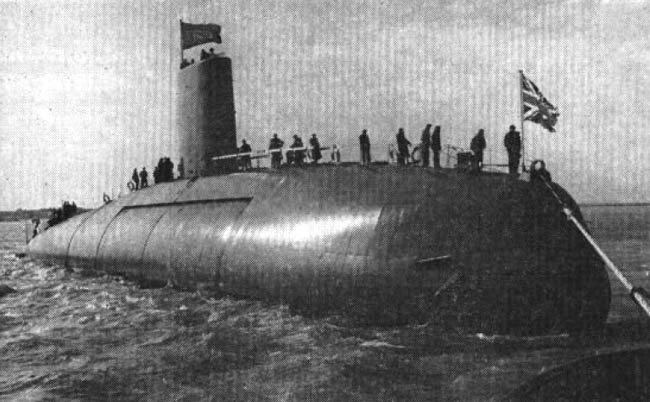
Although nuclear energy was researched in Great Britain since before WW2 and participated in the Manhattan Project, the US after the war rejected demands for collaboration, notably considering a nuclear program, both for the civilian and the military. The Royal Navy itself forayed into nuclear propulsion since 1946. The first plant was created at Calder Hall in 1956, and Great Britain in fact developed the world’s first civil nuclear program while the United Kingdom Atomic Energy Authority (UKAEA) was established in 1954.
Development for nuclear propulsion was suspended indefinitely in October 1952 but in 1955 the USS Nautilus was completed, setting up records and showing its usefunles when training with the RN. The Admiralty renewed interest under the drive of the First Sea Lord, Admiral The Earl Mountbatten and Flag Officer Submarines, Sir Wilfred Woods led to relaunch the program, now with a solid base, the existng development of civilian reactors.
Plan was to build an all-British nuclear submarine was too much of a stretch and would have delayed their completion for about ten years, so instead, the British government turned to the US for cooperation. Excellent relations between Admiral Mountbatten and US Navy Chief of Naval Operations Arleigh Burke was a crucial step to circumvent Rear Admiral Hyman Rickover’s stauch opposition to any transfer of technology, even forbid Mountbatten to inspect Nautilus. However in a visit to Britain in 1956 Rickover saw the state of nuclear power in UK and changed his mind. He at first agreed to provide the S3W reactor of the Skate class, but Mountbatten after much influence and networking obtaine dno less than the entire machinery system of the very latest Skipjack-class, the fifth generation S5W reactor. In 1958 was signed the US-UK Mutual Defence Agreement which cemented further technology transfers. Although the powerplant was US-built, the hull, combat systems and equipment of the new SSN were purely British. The new project, pennant S101, was aply named “HMS Dreadnought”. A collaboration with Electric Boat Company wa useful to gain time in the design and construction of the hull.
Laid down on 12 June 1959, the first British SSN was launched by Queen Elizabeth II on Trafalgar Day, 21 October 1960. Reactor tests did not started before the reactor was installed and ready in 1962, and she made made her first dive in Ramsden Dock, 10 January 1963, commissioned on 17 April 1963. Great Britain became the third nation to field nuclear sumarines, after USSR with its November class (1958). Menawhile, a truly British onboard nuclear plant was developed by Rolls-Royce with the United Kingdom Atomic Energy Authority at the Admiralty Research Station HMS Vulcan in Dounreay, Scotland. On 31 August 1960 another SSN was ordered from Vickers Armstrong, to be fitted with the PWR1 nuclear plant: HMS Valiant. HMS Dreadnought was eventually decommissioned in 1980 and since kept for gradual dismantling in Rosyth, with some hope since 2012 to preserve here.
Displacement: 3,500 tons surfaced/4,000 tons submerged
Dimpensions: 265.7 ft (81.0 m) x 31.2 ft (9.5 m) x 25.9 ft (7.9 m)
Propulsion: Westinghouse S5W reactor, 2 geared steam turbines 15,000 shp (11,000 kW)
Speed: 20 knots surfaced/28 kts submerged
Complement: 113
Armament: 6 bow tubes, 21-in (533 mm), 24 torpedoes Mk.23
 Valiant class SSN (1963)
Valiant class SSN (1963)
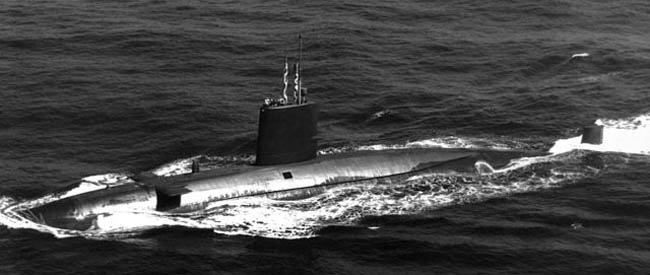
S102 Valiant, S103 Warspite
As said before, the plan was to provide a purely British SSN class with both the hull and reactor purely British. The class were based on HMS Dreadnought, enlarged by 20 feet (6 m) and larger at 4,900 tons. Improvements were made for a quieter run and still had a Paxman diesel-electric generator for silent running. US Admiral Hyman G. Rickover dismissed the British proposed rafting system for the Valiant class propulsionand the result was the Royal Navy gained an advantage in that field. It would take year before the United States Navy introduced the same concept. The basic principle, which almost buffers the hull from the powerplant’s vibrations, is now the core silending principle for all submarines, nuclear or not.
The Valiant class was conceived as a pure hunter-killed class. The class was named after famous dreadnoughts to continue the tradition started by HMS Dreadnought. This was also a measure of their importance to the Royal Navy as commissioned in 1966 and 1967. In 1967, HMS Valiant set the RN record for a 12,000 miles (19,312 km) submerged cruise of 28 days from Singapore to home waters. Refits were numerous, one ssing the adoption of torpedo-launched Harpoon missiles in the 1980s. They served in the Falklands War in 1982 and were decommissioned in 1991-1994, inspiring both the Resolution and Churchill classes.

Displacement: 4,400 tons surfaced/ 4,900 long tons submerged
Dimensions: 285 ft (87 m)x 33 ft 3 in (10.13 m) x 27 ft (8.2 m)
Propulsion: 1 shaft, Rolls-Royce pressurised water reactor, 2 steam turbines
Speed: 20 knots surfaced/29 knots submerged
Complement: 103
Armament: 6 × 21 in (533 mm) bow TTs, 32 Mark7/Tigerfish torpedoes
 Churchill class SSN (1970)
Churchill class SSN (1970)
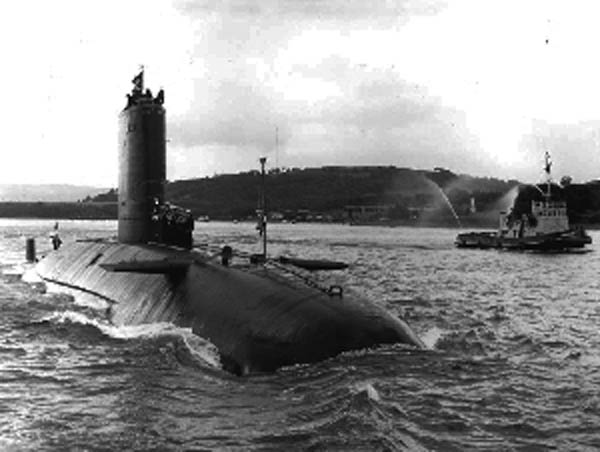
S46 Churchill, S48 Conqueror, S50 Courageous
The Churchill class were a follow-up of the Valiant, with a submerged displacement of 4,900 tons and slightly shorter, at 285 ft long for 33 ft 2 in and single pressurized water-cooled reactor coupled to two English Electric geared turbines (20,000 shaft horsepower), and as before, single shaft, 28 knots underwater. They were fitted with a Kelvin Type 1006 surface-search radar, a Type 2001 sonar array and after refit a Type 2020 array/Type 2026 towed array. They fired the Mk VIII torpedo and the Mk 24 Tigerfish. In the 1980s they were modified to also fire tje tube-launched Sub-Harpoon. They also evaluated the Mark 48 torpedo and UGM-84 Harpoon. They served in the Falklands; HMS Conqueror became the first SSN in the world to sink a major warship, the cruiser ARA General Belgrano. They were decommissioned in 1990-1992. Since 2010 HMS Conqueror is in Devonport, awaiting disposal. In 1981, HMS Courageous became was the first equipped with the Sub-Harpoon, and last decommissioned, in 1992, now a museum ship in Devonport.
Displacement: 4,900 tonnes submerged
Dimensions: 86.9 m (285 ft) x 10.1 m (33 ft) x 8.2 m (27 ft)
Propulsion: Nuclear reactor, 2 turbines, 1 shaft
Speed: 28 knots (52 km/h) submerged
Complement 103
Armament: 6 × 533 mm (21 in) tubes, see notes.
 Swiftsure class SSN (1971)
Swiftsure class SSN (1971)
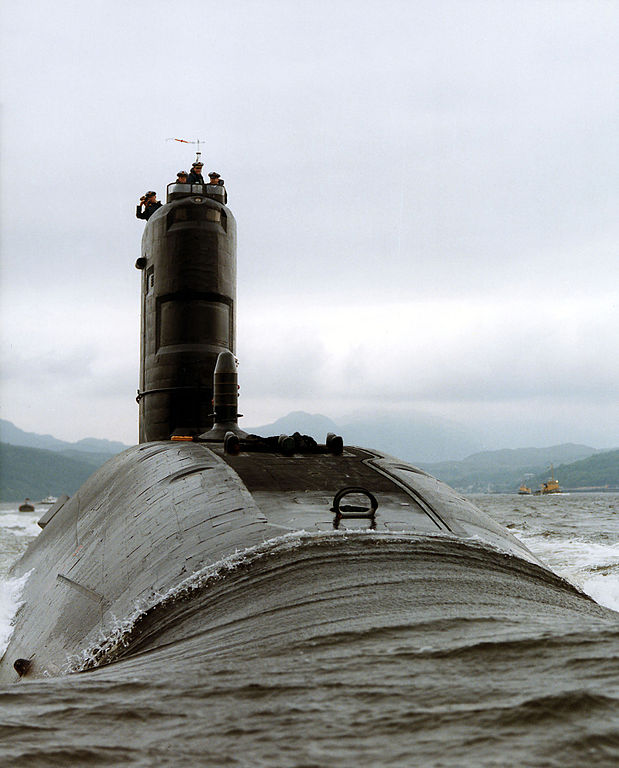
S126 Swiftsure, S108 Sovereign, S109 Superb, S104 Sceptre, S105 Spartan, S106 Splendid
Contraty to all previous “whale-shaped hull” Bitish SSNs of the first generation, the Swiftsure class was was given a different shape, maintaining its diameter for a much greater length, 13 ft (4.0 m) shorter but with a fuller form, fore-planes set further forward, one less torpedo tube, deeper diving depth. They were also more silent running, and the propulsion was much more advanced. This started with the propeller replaced by a shrouded pump-jet propulsor, prototyped on HMS Churchill already. 50% more efficient than a propeller at lower revolutions, it also grealty reduced the noise signature. Pipework connections had expansion/flexible coupling connections to achieve the “improved raft” conception of the powerplant. The US Navy was interested and secured a licence for the British flexible coupling arrangement.
Displacement: 4,400 t standard/ 4,900 t submerged
Dimensions: 82.9 m (272 ft) x 9.8 m (32 ft) x 8.5 m (28 ft)
Propulsion: Nuclear Reactor, 1 shaft, 2 steam turbines, pump jet
Speed: 28 knots (52 km/h) underwater
Complement 116
Sensors: Bow, flank, active intercept, towed array sonars, periscope and collision avoidance radars
Armament: 5 x 21 inch (533 mm) torpedo tubes (Spearfish, Sub Harpoon, Tomahawk)
 Trafalgar class SSN (1981)
Trafalgar class SSN (1981)
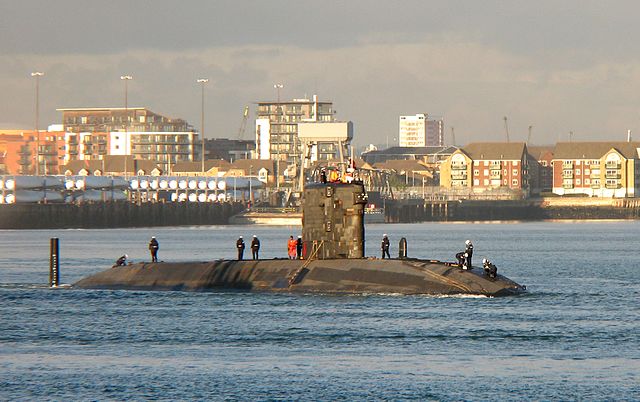
Trafalgar S107, Turbulent S87, Tireless S88, Torbay S90, Trenchant S91, Talent S92, Triumph S93
The Trafalgar class was a Cold War development of the Swiftsure class, fifth class of the Royal Navy, the first (HMS Trafalgar) ordered on 7 April 1977, completed in 1983, a bit late to take part in the Falklands war. HMS Triumph was completed in 1991 aftr USSR collapsed. All seven were built at Vickers Shipbuilding, Barrow-in-Furness and the average coast was estimated £175 million with equipment and weapons systems per unit, and £200 million consolidated in 1984–85 on average. They were in essence the last British SSNs of the cold war.
As a refinement of the preceding Swiftsure they saw their internal layout improved and adopting a Rolls-Royce PWR1 Core 3 nuclear powerplant. The acoustic signature was further reduced as the hull was covered with anechoic tiles, efficient against active sonars. They had strengthened fins and retractable hydroplane to surface through thick ice. The pumpjet propulsion system was also imrproved for even better cyclic rate efficiency and lower revolutions. They were stlightly longer for the same basic hull and underwater displacement of 5,300 tonnes.
Their propulsion system comprised a single Rolls Royce PWR1 nuclear reactor coupled with two GEC steam turbines providing steam to two WH Allen turbo generators of 3.2 MW, two Paxman diesel generators 2,800 shp (2.1 MW) for silent-running, a pump jet propulsor, a motor for emergency drive
and an auxiliary retractable prop.
She was the first class fitted with an extesive ECM and decoy suite: Two SSE Mk8 launchers for the Type 2066 and Type 2071 torpedo decoys and SAWCS decoys carried from 2002 were added to seach, anti-collision and aerial radars, active and passive sonars, the RESM Racal UAP passive intercept and the CESM Outfit CXA. Armament comprised the Tomahawk Block IV cruise missiles and Spearfish heavyweight torpedoes.
Torbay, Trenchant, Talent and Triumph were fitted the Sonar 2076 system and the last four were upgraded in 2014, notably all received a modenrized communications package. They operated the Tomahawk Block IV cruise missiles, and the Spearfish heavyweight torpedo, with 30 vectors in store. Decommissioned started in 2009 and is ongoing. Only the last two are maintained active for the moment, plus one in reserve.
Displacement: 4,500-4,800 t surface, 5,200-5,300 t submerged
Dimensions: 85.4 m (280 ft) x 9.8 m (32 ft) x 9.5 m (31 ft)
Propulsion: 1 shaft, PWR1 reactor, 2 steam turbines, see notes.
Speed: 30 knots (56 km/h) submerged
Test depth: 600m
Complement: 130
Electronic suite: RESM Racal, CESM Outfit CXA, Type 2066 and Type 2071, SAWCS decoys
Armament: 5 × 21-inch (533 mm) torpedo tubes, 30 vectors, see notes.
 Upholder class Patrol Submarines (1986)
Upholder class Patrol Submarines (1986)
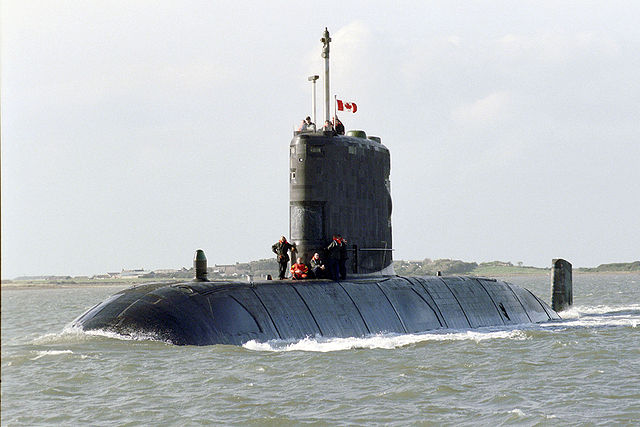
Upholder, Unseen, Ursula, Unicorn
The Upholder/Victoria-class submarines (Type 2400 from their displacement) were the ultimate Royal Navy diesel-electric submarines, designed in the 1980s to supplement the costier SSNs and named after the most famous of the WW2 U-class. Their service was however limited due to the end of the cold war, and they were discarded aft 1994. The Royal Canadian Navy erepurchased them in 2011, replacing their old Oberon class retired in 1998. Renamed Chicoutimi, Victoria, Corner Brook and Windsor in Canadian service, they are classified as the Victoria class. Electrical problems and mechanical operational incidents limited their active service, problems since fixed and all boats duly modernized.
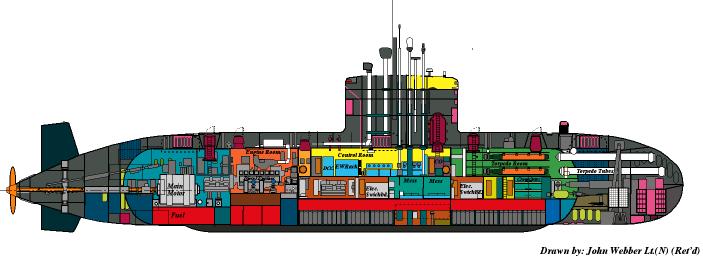
Displacement: 2,455 t
Dimensions: 230 x 23 x 24 ft (70.26 x 7.2 x 7.6m)
Propulsion: 1 shaft, 2 diesels 2,035 hp ,1 electric motor
Speed: 12 knots/20 knots
Range: 8,000 nmi/8 kn, 10,000 nmi snorkel
Endurance 30 days, crash depht beyond 656.17 ft (200 m)
Complement: 48
Sonar: Type 2040, 2041, 2007, 2046/CANTASS MOD, 2019, SFCS Mk 1 Mod C, Kelvin Hughes Type 1007
Armament: 6 x 21 in (533 mm) torpedo tubes (18 Mark 48 torpedoes)
 Resolution class SSBN (1966)
Resolution class SSBN (1966)
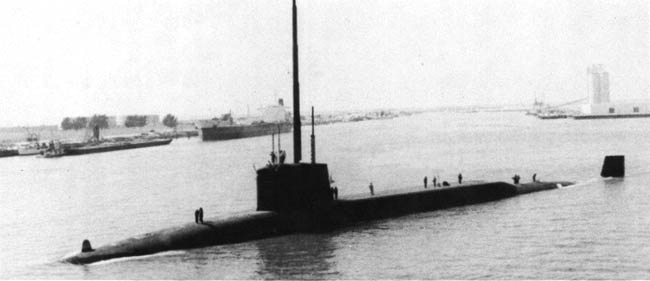
S22 Resolution, S23 Repulse, S26 Renown, S27 Revenge
The Kennedy administration expressed doubts on the airborne AGM-48 Skybolt intended for bombers, and US deterrent policy at large, while the British use of V-bombers as main deterrent policy was endangered by new Soviet missiles and interceptors. New ICBM inertial guidance systems gave a new strike capability making fall bombs obsolete. McNamara concerns about the UK’s own nuclear force and possible involvement into a war started by the UK went to the resolution of a dual-key arrangement. Skybolt in concertation with the British was cancelled in November 1962, stirring protests at the House of Commons, Macmillan reasssuring that the UK would retain independent deterrent capability in any case. Development of the Polaris at last presented a suitable vector shared in agreement and a launch platform was to be developed. The dual-key arrangement was accepted eventually by Kennedy and the Polaris system was gained by UK which started development of dedicated SSBN while planning its retirement of its V bombers fleet from 1968.
Engineers took the easiest path to gain time, choosing the existing Valiant-class SSN hull and stretching it by adding a 16 tubes section for Polaris missile launchers. Two pairs were ordered in May 1963 from Vickers, Barrow in Furness and Cammell Laird in Birkenhead. The fifth was planned as HMS Ramillies but cancelled in February 1965 under Harold Wilson’s administration. The missile compartment was located between the fin and nuclear reactor as per US practice on the USS Washington design (launched 1961). With 130 metres (430 ft) long for 10.1 metres (33 ft) and 9 metres (30 ft), displacing 8,400 long tons (8,500 t) submerge they were the largest Britsh submarines ever built;
They were given a Rolls-Royce pressurised water reactor PWR1 and two English Electric Company turbines for 25 knots (46 km/h) submerged, with a diving depht of 275 metres (902 ft). They still had six 533-millimetre (21 in) bow torpedo tubes with the Tigerfish wire-guided homing torpedo. According Naval Constructors R.J. Daniel, these boats had features that would be copied by the USN, such as the machinery loading hatch, automated hovering system, welded hull valves, standardised valves, plus the usual raft-mounted propulsion machinery making them extremely silent.
Just like for France, it was chosen to built four SSBNs in order to have two at sea at all times, allowing another to be one in maintenance and another ready for replacement on the patrol course. Commissioned in 1967-69, all four were decommissioned in 1992-95. Cost per unit on average was £39 million.
Displacement: 7,600 t surfaces/8,500 t submerged
Dimensions: 425 ft (130 m) x 33 ft (10 m) x 30 ft 1 in (9.17 m)
Propulsion: PWR1 nuclear reactor 27,500 shp (20.5 MW)
Speed: 20 kn/25 kn surface/submerged
Complement: 143
Armament: 6 21-in TTs (12 torpedoes), 16x Polaris SLBM
 Vanguard class SSBN (1992)
Vanguard class SSBN (1992)
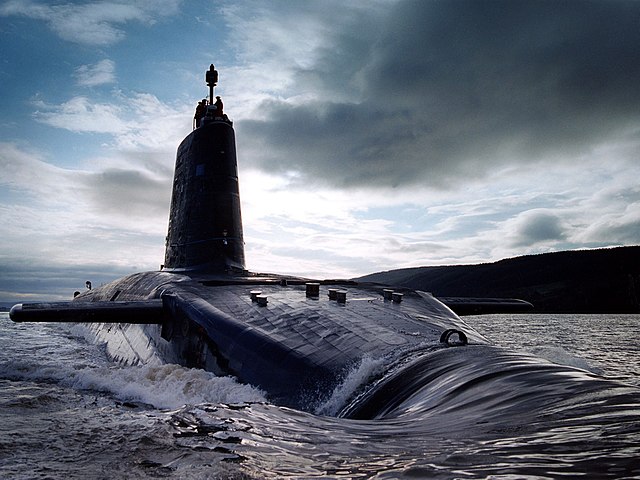
Vanguard S28, Victorious S29, Vigilant S30, Vengeance S31
Although they were launched in 1992-98, the Vanguard class was studied during the cold war, in the 1980s. The previous Resolution class rested on the UGM-27 Polaris missile system. It was supplied to Britain following the 1963 Sales Agreement (UK Polaris programme) but in 1979 the British government wanted to study options for the successor of the Resolution-class and its Polaris missile. On 24 January 1980, the House of Commons backed the government for a fully independent nuclear deterrent and development started for a British designed and built ballistic missile, an option deemed very expensive and risky compared to the updated US solution, eventually considered “unattractive”.
It was chosen to te updated Polaris, but make a brand new SSBN, a cheaper proposition. Eventually the high cost of sustaining a small stockpile of British missiles in service post-1990 seemed unappropriate. The US UGM-73 Poseidon was also considered but rejected as too new and costly. The UGM-96 Trident I was the preffered option, and on 10 July 1980, PM Margaret Thatcher asked Jimmy Carter for the purchase of Trident I missiles and renewal of the 1963 Polaris Sales Agreement. But soon the new ready UGM-133 Trident II was available, and it was asked to the now president Ronald Reagan in 1982, with an agreement signed in March 1982, Britain providing 5% R&D as agreed.
As the new missiled specs were soon known, work started on the carrier submarine, integrating the latest prospective in SSBN technology. Studies started in 1985, at HMNB Clyde and the Royal Naval Armaments Depot Coulport, Faslane. The Vanguard class general outlines were defined and Rosyth was soon included in the loop. The program total cost was estimated £550 million and the much larger Vanguard-class also asked for the reconstruction of the Devonshire Dock Hall. Construction was completed in 1986, S28 being laid downon on 3 September that year.
The Vanguard class was mostly the result of VSEL (Vickers Shipbuilding and Engineering) Barrow-in-Furness, later integrated into BAE Systems Maritime and from the outset modelled about the new tubes section provided for the UGM-133 Trident II. It was strongly influenced by the Ohio class systems and thus the much larger Vanguard-class reached 16,000 tonnes submerged, making them not only the largest submarines ever built for the Royal Navy but also the largest European submarines as well. As a remainder, the earlier Delta III-IV class were 18,000 tonnes. It was still “light” however compared to the Typhoon and their 43,000 tonnes. All four boats are currently the backbone of the British nuclear deterrence, but they are still small in comparison of the planned Dreadnought class replacing them, displacing circa 19,000 tonnes, and armed with the evolved Lockheed Trident II D5 SLBMs (First laid down 6 October 2016, expected for 2030).
Displacement: 15,900 t
Dimensons: 149.9 m (491 ft 10 in) x 12.8 m (42 ft 0 in) x 12 m (39 ft 4 in)
Propulsion: PWR2 nuclear reactor, 2 GEC turbines 27,500 shp, see notes;
Speed: 25 knots (46 km/h; 29 mph) submerged
Complement: 135
Sensors: SMCS, Type 1007 nav radar, Thales Type 2054 sonar, Pilkington Optronics periscopes, Type 2066/2071 torpedo decoys, RESM Racal
Armament: 4 × 21-in TTs: Spearfish torpedoes, 16 Trident II D5 SLBMs
Amphibious Warfare Ships
 Fearless class Assault ships (1963)
Fearless class Assault ships (1963)
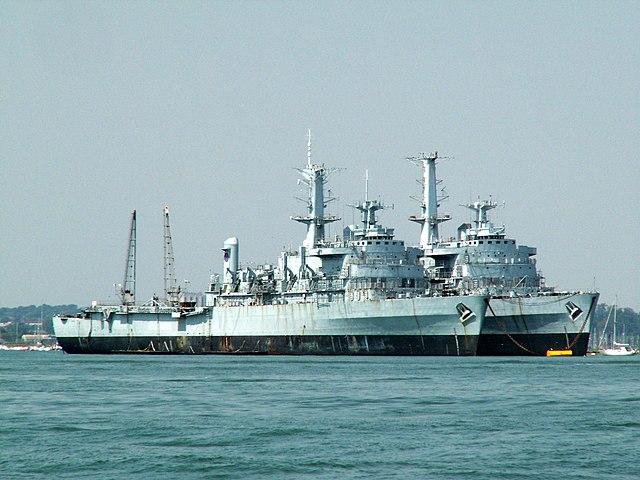
Fearless and Intrepid in Portsmouth, pending deactivation
The Fearless-class were the first landing platform docks, purpose-built as amphibious assault vessels for Royal Navy, with HMS Fearless and HMS Intrepid. Like the USN landing platform docks (LPD), they could hold four Landing Craft Utility (LCU), two pairs side by side, in their dock, or operate helicopters from their aft deck. The internal dock was accessed via the stern in port with a stern ramp for vehicles, and their own dedicated decks forward. The internal dock could be flooded up to the edge of the vehicle deck.
In addtition of the dock crafts, they carried four smaller landing craft on davits, in the superstructure and had accommodation for 400 troops up to 700 when no vehicle were carried.
Commissioned in 1965 and 1967 the were mobilized during the Falklands war, and Intrepid was eventually in extended reserve in 1991, used for spares to maintain her sister Fearless. Intrepid was discarded in 1999 and Fearless until 2002, as the last steam-powered surface vessels of the Royal Navy.
Specifications
Displacement standard 16,950 tons
Dimensions: 158.5 x 24.4 x 6.3m (520 x 80 x 21 ft)
Propulsion: 2 steam turbines 22,000 shp (16,000 kW), 22 kts (41 km/h)
Payload: 4 medium landing craft in dock, 4 davits, 700 troops, 15 tanks, 27 vehicles
Complement: 580
Armament: 2 AA guns, 16 SAM, 2x Phalanx CIWS
Aircraft: 5 helicopters
 In planning: Ocean class assault ships (launched 1995)
In planning: Ocean class assault ships (launched 1995)
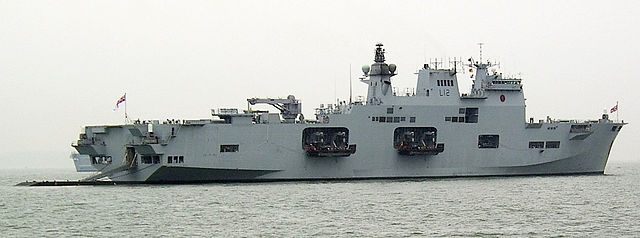
In 1989 it was planned to replace the Fearless class LHDs. But it’s only in 1992 that an invitation to tender was made. Unlike the previous Fearless class which were ‘hybrids” with only the aft section used, the new Ocean class closely resembled modern LHDs, with a full deck and island. The deck ended is a gothic ogival fashion like HMS Hermes and Eagle. She was at the forefront of a wave of relatively similar European LHDs of the same design, like the French Mistral, Spanish Juan Carlos I and RAN Camberra class, plus new vessels in construction worldwide.
HMS Ocean was planned to be a 21,500 tons 203.4 m (667 ft) x 35 m (115 ft) x 6.5 m (21 ft) vessel powered by two Crossley Pielstick 12 cylinder to 18 knots on 8,000 miles (13,000 km), carrying four LCVP Mk5B, 40 vehicles, 830 Royal Marines and operate up to 18 helicopters with a large models array. She was completed in 30 September 1998 but was resold in 2018 to Brazil.
 Round Table class Logistic Landing ships (1963)
Round Table class Logistic Landing ships (1963)
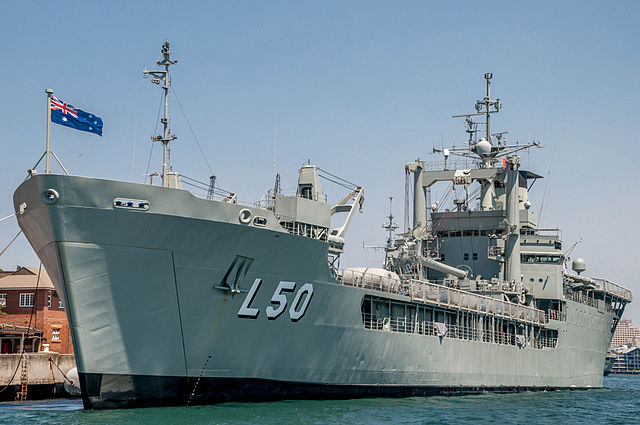
The Round Table class (Sir Lancelot class for some sources, from the led vessel) was a British ship class designed in 1959 for amphibious warfare missions, designated landing ship logistics (LSL). The idea for the class name probably came from the acronym phonetically resembling to “Lancelot”.
This was a successful class with eight vessels built total, six for the RN and two for the RAN, built by Fairfields Stephens, Hawthorn Leslie and Swan Hunter between October 1965 to Sept. 1967 for the British vessels, and 1978-87 in Australia.
Specifications
Displacement: 3,270 tons standard/5,674 tons FL
Dimensions: 413 ft (126 m) x 59 ft (18 m) x 13 ft (4.0 m)
Propulsion: Two shafts diesel 9,400 bhp (7,010 kW) 17.25 knots, range 3,000 nm.
Capacity: 12 Challenger tanks, 31 large vehicles, 56 Land Rovers or 26 cargo containers on the main deck plus 19 large vehicles, 50 Land Rovers or 20 containers on the upper vehicle deck. Troops 402, crew 65, defense 2 × 20 mm guns, Helicopter deck aft.
 HMS Sir Galahad Logistic Landing ship (1986)
HMS Sir Galahad Logistic Landing ship (1986)
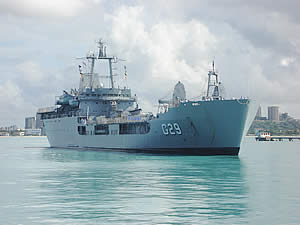
The previous one was part of the Round Table class, famously sunk during the battle of the Falklands. She was laid down at Swan Hunter in 1985 in replacement. Launched on 13 December 1986, completed on 19 July 1987 to enter service on 7 December she was a larger vessel, although still hybrid in nature. She was sold to Brazil in 2007 as Garcia D’Avila.
140.16 m (459 ft 10 in) long overall she displaced 7,400 long tons standard and was powered by two Mirrlees Blackstone K9 Major diesel engines for 13,320 bhp and 18 knots (21 mph; 33 km/h) with a generous global range as a result, of 13,000 nmi (15,000 mi; 24,000 km). She did far better than the previous Round Table class, but woud remain alone in her class. No sister ship was ordered.
Specifications
Dimensions: 140.16 m (459 ft 10 in) x 19.50 m (64 ft 0 in) x 4.50 m (14 ft 9 in)
Displacement: 7,400 long tons standard/light, 8,541 long tons FL.
Propulsion: 2 shafts K9 Major diesel 13,320 bhp (9,930 kW) 18 kn (21 mph; 33 km/h), 13,000 nmi (15,000 mi; 24,000 km).
Capacity: Bow & stern doors, two decks, 400 troops, 3,440 tonnes of supplies
Armament: 2x Oerlikon 20 mm, 2x 7.62 mm GMPG
Aircraft: aft pad: Westland Sea King. Amidships pad CH-47 Chinook
 Ardennes (Mark 8) class LSTs (1944)
Ardennes (Mark 8) class LSTs (1944)
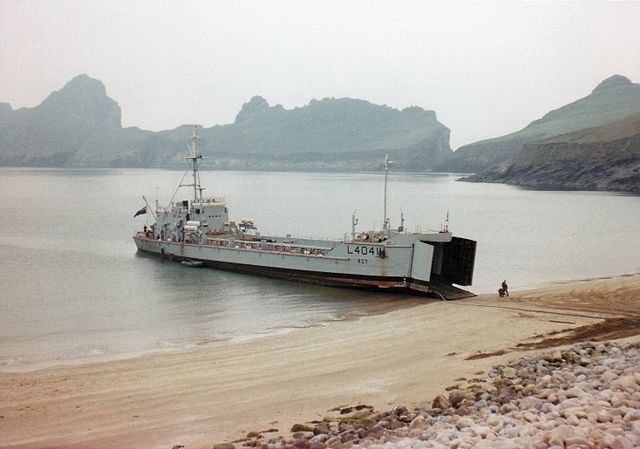
These vessels were the British verison of the American LSTs. They were however completed too late to take part in wartime operations, after 1945. Over 187 planned, only 30 were completed, and man modernized. The Mark 8 Landing Craft Tank or “LCT (8)” or “LCT Mark VIII” were ocean-going vessels designed originally to take part in operations in the Far East.
Outside the 30 completed for the Royal Navy, 6 were sold to the civilian market. From 1957 twelve were transferred to the British Army, Royal Army Service Corps and then Royal Corps of Transport. In 1958-1966 the remainder 18 were transferred or sold to foreign navies, converted or disposed of. Their design was also inspiring to the Royal Malaysian, French, Singaporean Navy, and Comoros.
They took part in the Suez Crisis, Indonesian Confrontation, and supplied remote bases in the Hebrides (Operation Hardrock) and islands throughout their career. They were replaced by the much larger and modern Round Table class ships.
Specifications
Dimensions: 231.2 x 38 x 4ft 8 in (70.5 x 12 x 1.42 m)
Displacement: 1,017 tons FL
Propulsion: 2 shafts, 4× Davey Paxman 12TPM engines 1,600 bhp, 8-12 kts, 4000 nm/8 kts
Capacity: 8 x 30-ton tanks, 13 x 3-ton trucks, 42 personal, or 350 tons cargo
Crew: 33-37 (1968)
Armament: 4 x 20 mm Oerlikons AA.
 Avon class (1959)
Avon class (1959)
Avon, Bude , Clyde, Dart, Eden, Forth, Glen, Humber, Itchen, Kennet, Lodden, Medway.
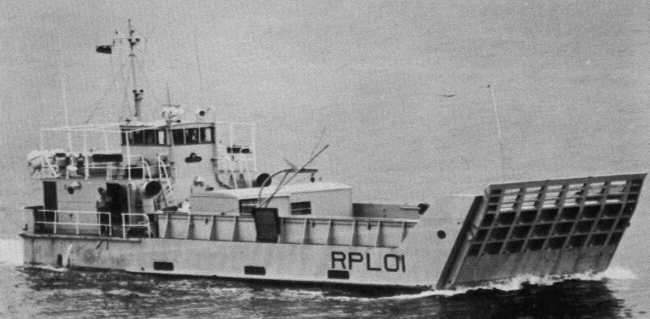
The “Avon class” are a serie of tanks landing crafts, built in 1960-62 at White & Saunders-Roe, Isle of Wight. They were completed in 1960-67. They were ramp powered lighters, available for short coastal hauls. They did not saw action in the Falklands;
Technically these were 100 tonne, 22 m long vessels (by 6.20 x 1.20 m) with two shafts diesels 870 bhp, 9 knots. They carried one main battle tank or 100 troops. They were fitted with a navigation radar and had a crew of 6. Unarmed but possible 0.5 in Browning HMGs. They were all discarded before 1994, starting in 1983.
 Arromanches class (1981)
Arromanches class (1981)
Arromanches, Antwerp, Andalsnes, Abbeville, Akyab, Aachen, Arezzo, Agheila, Audemer.

All nine were built at James and Stone, Brightlingsea between 1981 and 1987. The were replacement for the 1959 Avon class and stricken in 1994-2013. One even served until 2019. Specifications: 165 tons standard, 282/290 tones FL. 30.0m pp (33.3 oa) x 8.30 m,x 1.45 m loaded. Two shafts Doorman 8JTCWM diesels 660 bhp: 9.2-10 kts max, 17 tons oil, 900 nm/9 kts. They carried 100 tons of cargo, so a main battle tank and a light vehicle plus crews and extra personal, with their own crew of 6. Unarmed, equipped with the Decca 110 radar for navigation.
 LCM(9) type (1963)
LCM(9) type (1963)
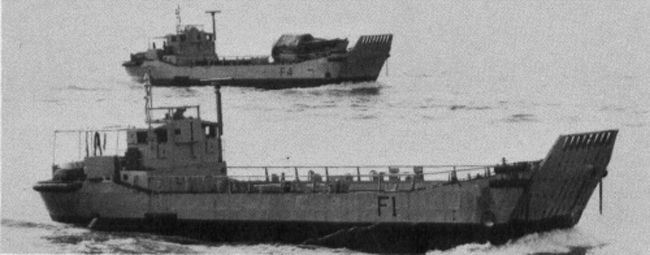
14 Landing Craft Mechanized, numbered L700-711 and 3507-3508. Built at Brooke Marine, Lowestoft (4), R. Dunston, Thorne (6), J. Bolson, Poole (2) and Vosper, Portsmouth (2). The latter were the prototype, launched 1963. The last were completed in 1966. They were carried by the HMS Fearless and Intrepid and took part in the Falklands war. Discarded in the early 2000s.
Specifications: Displacement 88 standard, 176 otns FL, 27.5 x 6.80 x 1.60 m, 2 shafts Paxman Diesels 624 bhp, 10 kts, unarmed, capacity 1-2 tanks or 100t of vehicles, navigation radar (1982), crew 6.
 LCVP Mk.4 type (1982)
LCVP Mk.4 type (1982)

Evolution and modernization of the ww2 LCVP. Made for the Royal Navy (L8301,L8403-8408, L8410-8418, L8619-8622) and Royal Army (L8402, L8409, L8419-8420). The prototype was built by Fairey Allday Marine, Hamble and the serie by Souter, Cowes. Discarded 2006-2013.
Specifications: Displacement 11 tons standard, 16 tons FL, 11.9 pp/13.0 m oa x 3.20 x 0.80 m, 2 shafts Perkins T6-3544 diesels or Dorman diesels 440 bhp, 20-22 kts (15 loaded), 150 nm/14 kts. Armed with two 7.6mm/90 LMGs, capacity 20-35 troops/5.5 t of cargo, Raytheon radar for navigation, crew of 3. From 1996 a new serie called LCVP Mk5 type was started. They are currently in service.

LCU Mk.9R (1986)
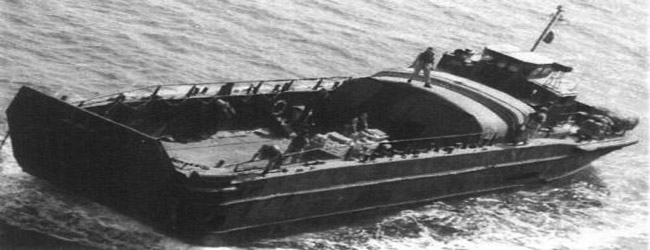
Three utility landing crafts denominated L713-16, built at McTay Marine, Liverpool in 1986. Discarded 2003-2005. Compared to the previous LCUs they had new diesels and grill-reinforced bow ramps.
Specifications: Displacement 115/160 tons FL, 25.7 x 6.50 x 1.70, 2 Dorman 8JTM diesels 540 bhp, 10 kts (9 loaded) 300 nm/9 kts;, unarmed, carries 1-2 tanks or 100t of vehicles. Crew 7.
Other types started after the end of the cold war:
-LCVP Mk5 vehicle and personnel landing craft (1996 – 2004)
-LCU Mk10 type utility landing craft (1999 – 2005)
-PACSCAT air-cushion landing craft (T-1) (2010)
-Type 2400 TD(M) air-cushion vehicles (2011).
Patrol Boats
Ford class seaward defense boats (1951)
Kingfisher class patrol crafts (1974)
Island class offshore patrol vessels (1976)
HMS Speedy – Patrol Hydrofoil (1979)
Castle class offshore patrol vessels (1980)
Peacock class patrol vessels (1982)
Fast Attack/Patrol Crafts
MTB 538-39 class FACs (1948)
Gay class FACs (1952)
Dark class FACs (1953)
Bold class FACs (1953)
Brave class FACs (1957)
HMS Tenacity patrol craft (1967)
Scimitar class FPB (1969)
Mine Warfare
‘Ton’ class minesweepers (1952)
‘Ham’ class inshore minesweepers (1952)
‘Ley’ class inshore minesweepers (1952)
‘Hunt’ class mine countermeasure vessels (1978)
‘River’ class fleet minesweepers (1983)
Sandown class mine hunters (1988)
Other Minesweepers
HMS Abdiel, HMS Wilton. Projects: Thorpe class Minesweepers (1952), 1954 Fleet Minesweepers.
Read More
- Conway’s all the world’s fighting ships 1947-95
- https://www.royalnavy.mod.uk/
- https://www.nmrn.org.uk/research/online-resources
- http://www.naval-history.net/Index0-1945.htm#falklands
- http://www.rnsubs.co.uk/
- https://rmhistorical.com/
- http://www.rnmuseumradarandcommunications2006.org.uk/
- https://www.rnecmanadon.com/about/timeline.php
- www.submarinersassociation.co.uk
- http://rnpsa.co.uk/cms/
- https://royal-naval-association.co.uk/
- http://www.mcdoa.org.uk/
- https://www.nmrn.org.uk/our-museums/fleet-air-arm-museum
- https://www.nmrn.org.uk/our-museums/national-museum-royal-navy-portsmouth
- http://www.naval-history.net/xGM-Ops-Events1961-70.htm
- https://southfront.org/the-british-royal-navys-queen-elizabeth-class-aircraft-carriers/
- en.wikipedia.org/wiki/Royal_Navy
- en.wikipedia.org/wiki/Type_system_of_the_Royal_Navy

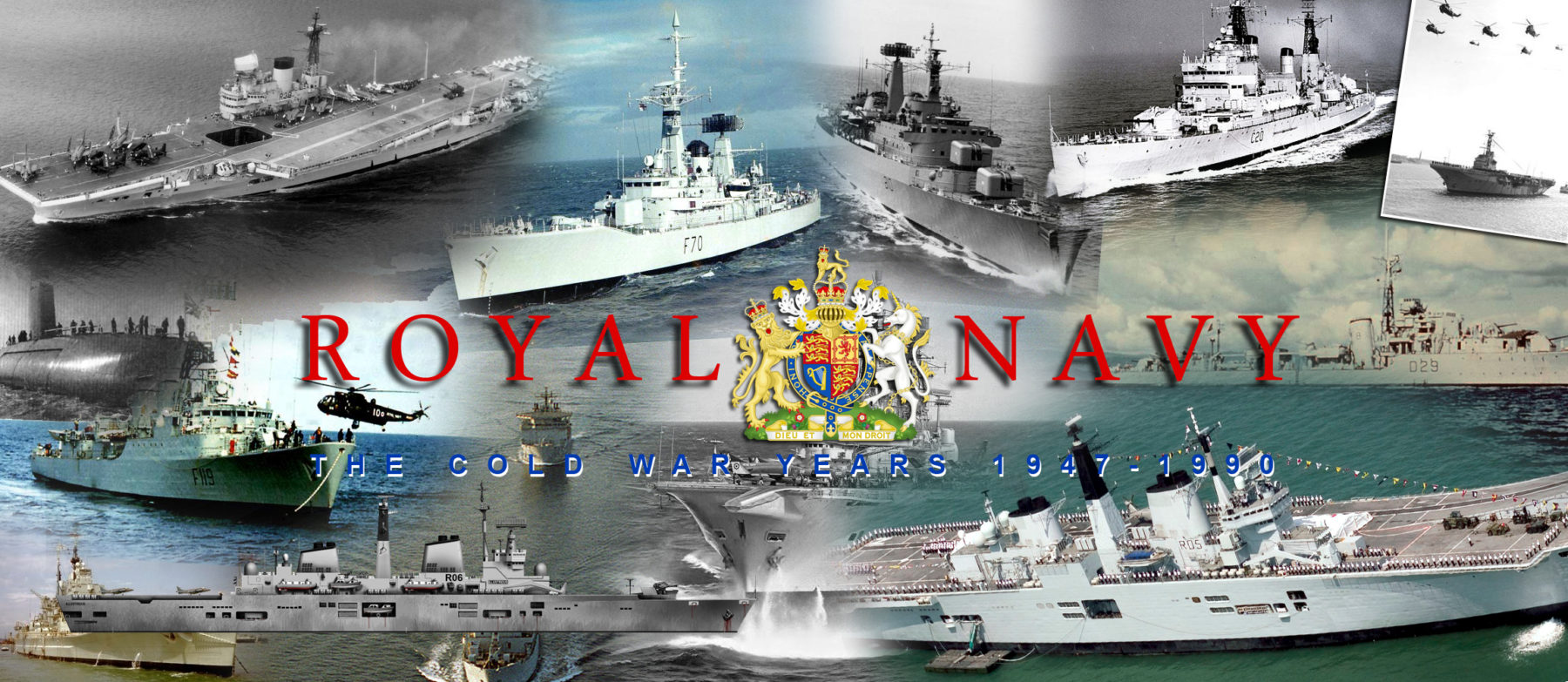
 RN Cold War
RN Cold War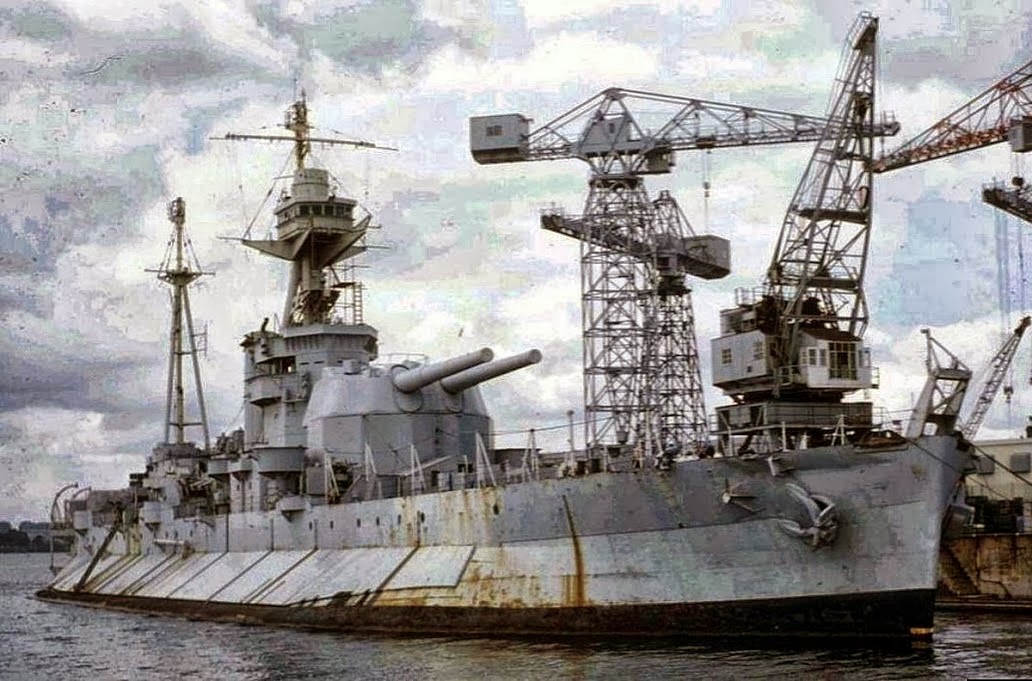



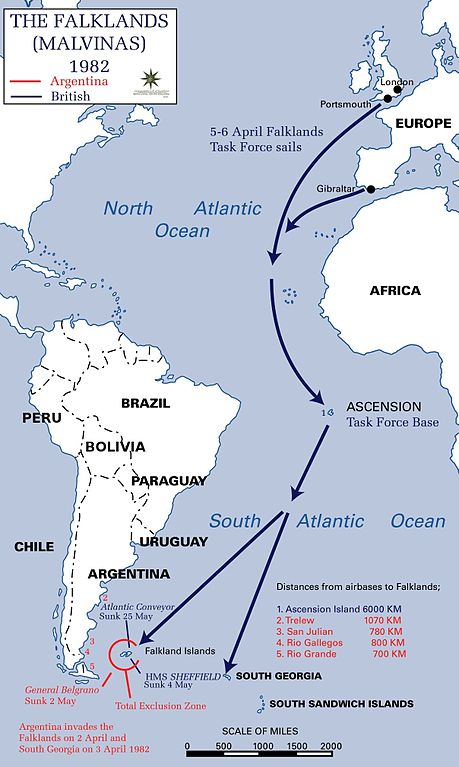
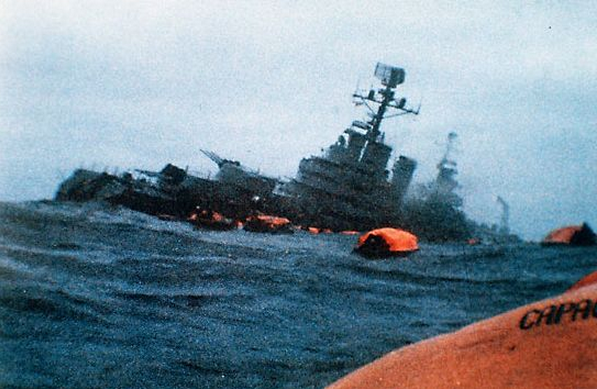
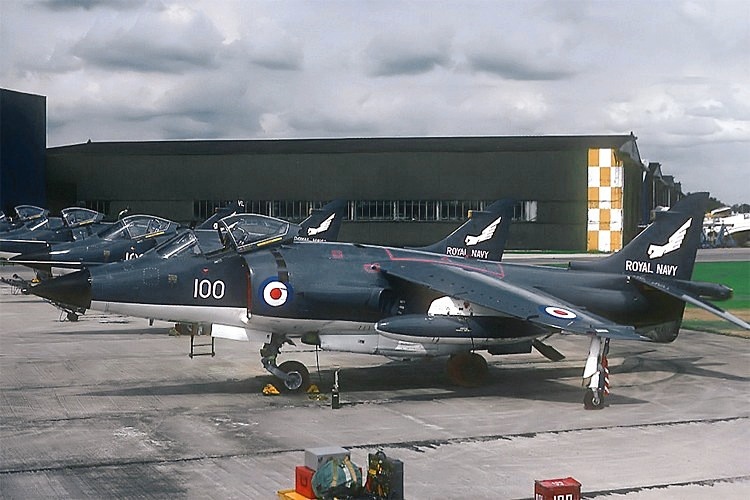

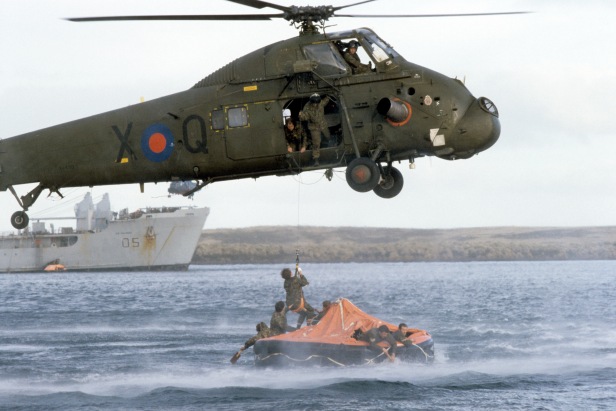
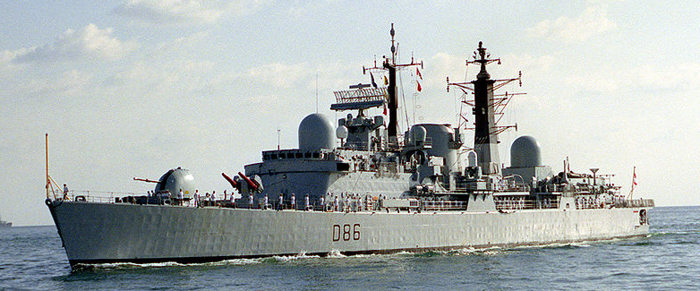
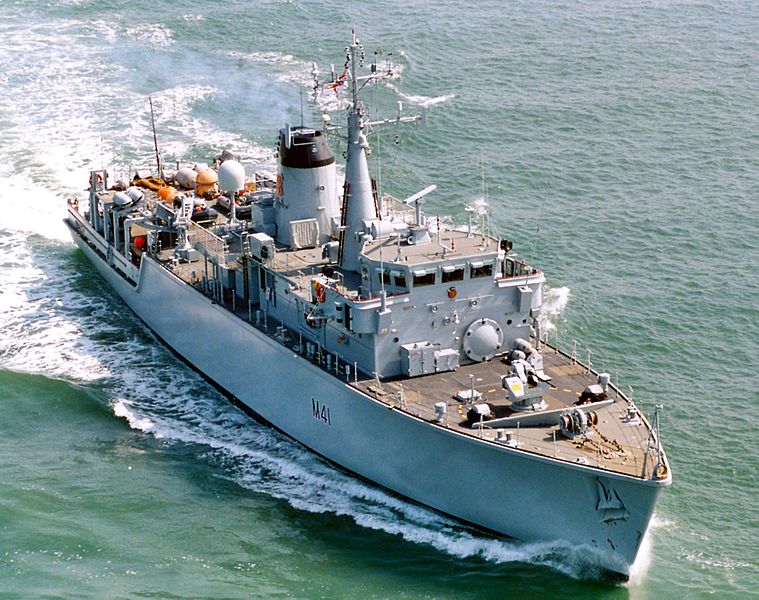

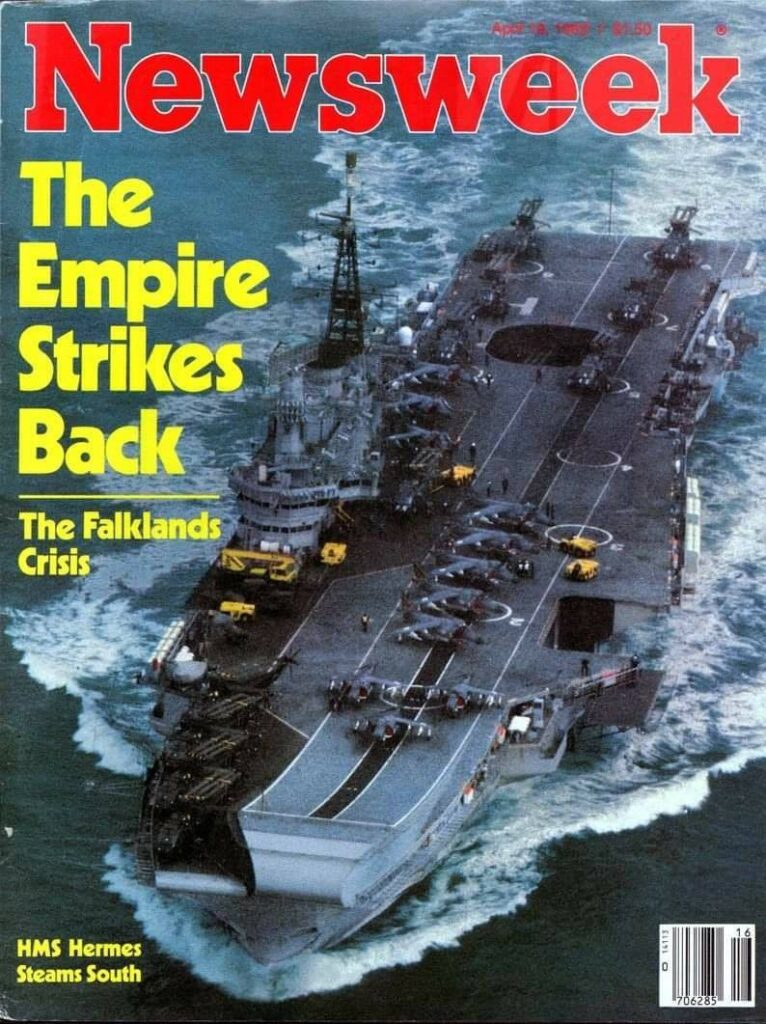
 Latest Facebook Entry -
Latest Facebook Entry -  X(Tweeter) Naval Encyclopedia's deck archive
X(Tweeter) Naval Encyclopedia's deck archive Instagram (@navalencyc)
Instagram (@navalencyc)





 Austrian Navy
Austrian Navy French Navy
French Navy Royal Navy
Royal Navy Armada Espanola
Armada Espanola K.u.K. Kriegsmarine
K.u.K. Kriegsmarine Dansk Marine
Dansk Marine Nautiko Hellenon
Nautiko Hellenon Koninklije Marine 1870
Koninklije Marine 1870 Marinha do Brasil
Marinha do Brasil Osmanlı Donanması
Osmanlı Donanması Marina Do Peru
Marina Do Peru Marinha do Portugal
Marinha do Portugal Regia Marina 1870
Regia Marina 1870 Nihhon Kaigun 1870
Nihhon Kaigun 1870 Preußische Marine 1870
Preußische Marine 1870 Russkiy Flot 1870
Russkiy Flot 1870 Svenska marinen
Svenska marinen Søværnet
Søværnet Union Navy
Union Navy Confederate Navy
Confederate Navy Armada de Argentina
Armada de Argentina Imperial Chinese Navy
Imperial Chinese Navy Marinha do Portugal
Marinha do Portugal Mexico
Mexico Kaiserliche Marine
Kaiserliche Marine 1898 US Navy
1898 US Navy Russkiy Flot
Russkiy Flot French Naval Aviation
French Naval Aviation Russian Naval Aviation
Russian Naval Aviation Sovietskiy Flot
Sovietskiy Flot Royal Canadian Navy
Royal Canadian Navy Royal Australian Navy
Royal Australian Navy RNZN Fleet
RNZN Fleet Chinese Navy 1937
Chinese Navy 1937 Kriegsmarine
Kriegsmarine Chilean Navy
Chilean Navy Danish Navy
Danish Navy Finnish Navy
Finnish Navy Hellenic Navy
Hellenic Navy Polish Navy
Polish Navy Romanian Navy
Romanian Navy Turkish Navy
Turkish Navy Royal Yugoslav Navy
Royal Yugoslav Navy Royal Thai Navy
Royal Thai Navy Minor Navies
Minor Navies Albania
Albania Austria
Austria Belgium
Belgium Columbia
Columbia Costa Rica
Costa Rica Cuba
Cuba Czechoslovakia
Czechoslovakia Dominican Republic
Dominican Republic Haiti
Haiti Hungary
Hungary Honduras
Honduras Estonia
Estonia Iceland
Iceland Eire
Eire Equador
Equador Iran
Iran Iraq
Iraq Latvia
Latvia Liberia
Liberia Lithuania
Lithuania Mandchukuo
Mandchukuo Morocco
Morocco Nicaragua
Nicaragua Persia
Persia San Salvador
San Salvador Sarawak
Sarawak Uruguay
Uruguay Venezuela
Venezuela Zanzibar
Zanzibar Warsaw Pact Navies
Warsaw Pact Navies Bulgaria
Bulgaria Hungary
Hungary

 Bundesmarine
Bundesmarine Dutch Navy
Dutch Navy Hellenic Navy
Hellenic Navy Marina Militare
Marina Militare Taiwanese Navy
Taiwanese Navy Chinese Navy
Chinese Navy Indian Navy
Indian Navy Indonesian Navy
Indonesian Navy JMSDF
JMSDF North Korean Navy
North Korean Navy Philippines Navy
Philippines Navy ROKN
ROKN IDF Navy
IDF Navy Royal New Zealand Navy
Royal New Zealand Navy Egyptian Navy
Egyptian Navy South African Navy
South African Navy

































 RN
RN
 Marine Nationale
Marine Nationale
 Soviet Navy
Soviet Navy
 dbodesign
dbodesign